Disclaimer: This post contains affiliate links to handpicked partners, including tours, gear and booking sites. If you click through or buy something via one of them, I may receive a small commission. This is at no extra cost to you and allows this site to keep running.
This Everest Base Camp trek guide shows how the Nepal EBC journey isn’t a light-hearted adventure. It’s a mini-expedition that will test and reward you.
It was the eighth final day of the ascent on the trek to Everest Base Camp. The 6 am wake-up call marked the start of our eighth day of trekking in this sacred area of Nepal, where the swift knock on the door and long-resounding tones of “morning” signalled the start of another long and arduous day. By this point, each day of the EBC expedition began to feel like a relentless and monotonous struggle.
Except this was the day where, despite extreme exhaustion, weakness from loss of appetite and braving bitterly cold conditions, we all hoped to find enough energy to pull ourselves through the last leg of our journey to get to Everest Base Camp. A journey to trek to the highest mountain in the world and stand at its foundation upon the jagged Khumbu Glacier.
I didn’t feel giddy with excitement that morning. Instead, swathed in five layers of clothing and still suffering from severe coughing and altitude headaches, I felt relieved that what I had set out to achieve was just a few hours away. I just wanted the pain to go away. Even the strongest of people were flagging.
We pulled ourselves slowly and sluggishly through the thin and icy air over six hours, broken up halfway by a short break at our accommodation tea house. I remember one of the Sherpas grabbing my arm to hold me up, pulling me over rocks and icy pockets as my legs were about to give way and pushing me to the end because I refused to be defeated. Not now, so close to the dream of climbing Everest Base Camp.
When we reached the top of the final climb, stumbling over loose rocks and onto a canvas of white, I could only sit and cry at what had become one of my greatest achievements.
The top of the world was standing right before me.
Contents
- Everest Base Camp Trek Guide – All Questions Answered
- Everest Base Camp Tours – Trek in a Group or Solo?
- Day-To-Day Trekking Guide
- Reaching Mount Everest Base Camp – Exhaustion and Euphoria
- Trekking Back to Lukla after Reaching Base Camp
- Top Tips to Complete the Trek to Everest Base Camp
- Preparing and Packing for Everest Base Camp Trekking
- Thinking About Trekking to Everest Base Camp? Do it!
- Everest Base Camp Trek: Snapshot
Everest Base Camp Trek Guide – All Questions Answered
Everest trekking is a dream of any avid adventurer, but just because you are not climbing Mount Everest, do not think the hike to Everest Base Camp (EBC) is easy. It’s so tough that, at times, you question your sanity and why you ever decided to do it.
At other times, you look at the scenery that’s so breathtakingly stunning and unlike any mountainous terrain that you have ever seen before – changing from lush green farmland, dense forest and glistening blue fast-flowing rivers to the barren land and glacial pools the higher you climb – that you realise it was a good decision. Here you are, backpacking Everest like a warrior. They call it the “steps to heaven” for a good reason.
It’s one of the hardest physical and mental challenges I have ever faced in my life. Yet, it became one of my proudest moments upon reaching Base Camp and looking up towards the clouds wrapping the top of Everest.
And that’s just a snippet of your feelings whilst ON the trek. A dozen questions run through your head before booking this adventure, so here are the answers to the most posed questions about how to hike to Everest Base Camp.
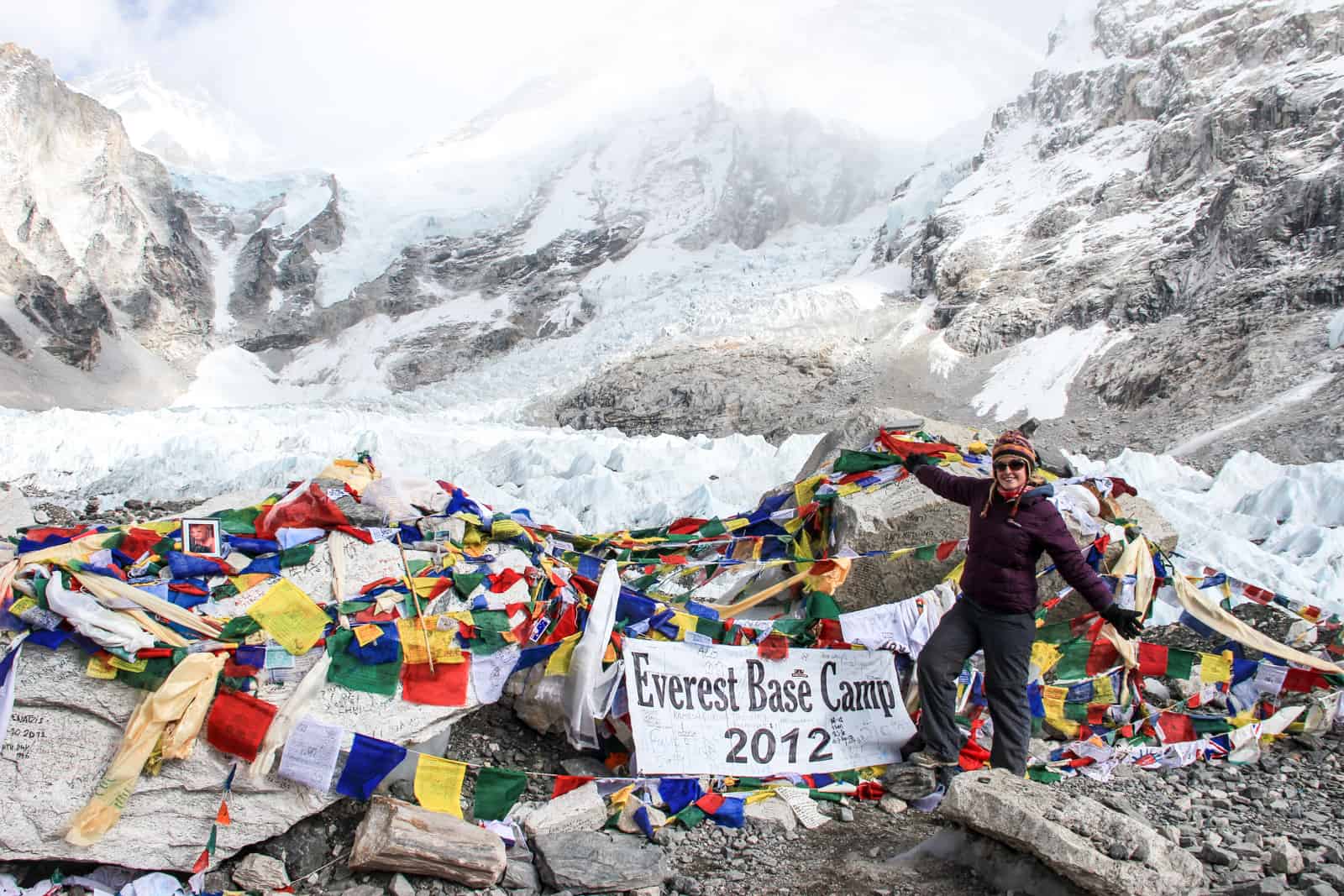
Everest Base Camp Trek Guide – Facing The Challenge. Reaching the Top of The World.
How Long is the Trek to Everest Base Camp?
The trek to Everest Base Camp typically takes 12 days to complete on a 130km round-trip. It takes eight days to get to Base Camp and four days to get back down, broken down into nine days of long trekking and three short trekking acclimatisation days.
Any treks which claim (or push you to complete the trek in a shorter amount of time) do so at risk. Despite the relatively short distance overall, there is a reason the journey to EBC camp one is stretched over 12 days, mainly due to the steep rise of altitude.
Nepal Everest Base Camp Trekking Route
There is a set route for EBC trekking that takes you through various villages, camping grounds and incredibly isolated spots with magnificent views of the mountain panoramas.
- Way up: Kathmandu – Lukla – Phakding – Namche Bazaar – Tengboche – Dingboche – Lobuche – Gorak Shep – EBC
- Way down: Gorek Shep – Pheriche – Tengboche – Monjo – Lukla – Kathmandu
Day 1: Kathmandu to Lukla flight. Trek to Phakding
Day 2: Phakding to Namche Bazaar
Day 3: Namche Bazaar acclimatisation day (trek to Thame and Khumjung, the green village)
Day 4: Namche Bazaar to Tengboche
Day 5: Tengboche to Dingboche
Day 6: Dingboche acclimatisation day (hike to Chhukung or Nagarzhang Peak)
Day 7: Dingboche to Lobuche
Day 8: Reach Everest Base Camp, crossing the Changri Glacier, and return to Gorak Shep.
Day 9: Gorak Shep to Pheriche (optional morning trek to Kala Pattar for sunrise views of Everest)
Day 10: Pheriche to Tengboche
Day 11: Tengboche to Monjo village
Day 12: Monjo to Lukla and stay overnight. Flight back to Kathmandu the following day
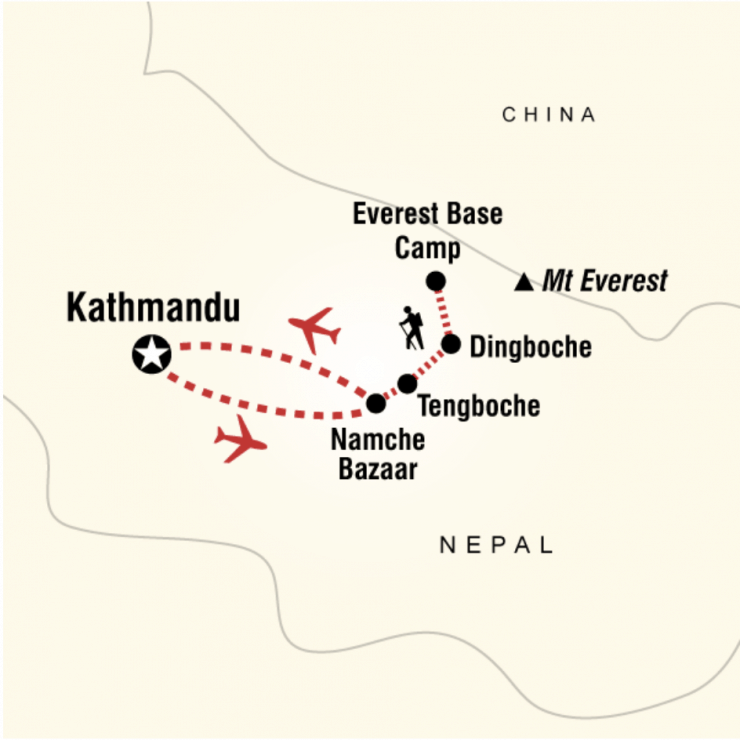
A map of the Everest Base Camp trekking route
Is the Everest Base Camp Trek Difficult?
Trekking from the starting point at 2,850m / 9,000 ft and climbing to 5,364m/ 17,500 ft is not easy, and it is more arduous than technically difficult. You don’t need any particular mountaineering skills or equipment such as ropes and crampons, just a lot of stamina.
Remember, you are not hiking Mount Everest – a feat that can take at least 40 days!
The greatest difficulty you will face trekking in Nepal is with altitude.
The distance from Lukla to Base Camp can be completed more quickly. However, you must stay healthy with less oxygen at a higher altitude. This makes the 12-day trek long – so that you can adjust and allow for acclimatisation as you get higher. It’s tough in parts, especially on the knees, with the daily differing uphill climbs and downhill descents.
I saw people of all ages, all sizes, and varying levels of hiking ability. I’d been that typical asthma kid at school – that one who was told I didn’t have to partake in the difficult athletic endeavours because it was obvious I would never make it. Any attempt would result in some hideous outcome of extreme embarrassment. I did not take much interest in sports or thought I couldn’t do much extreme physical exertion. It took many years to realise that this is not the case, and the Everest Base Camp trek was one of those things I had to do to prove that to myself. If someone like me with a chronic disease can complete the Everest Base Camp trip, so can you.
Besides ALWAYS drinking plenty of water, the most important thing is to go at your own pace. There is also no pressure to keep the same pace as everyone around you. A guide will either be with you, or not far behind a small group of people, so there is no danger of getting lost or alone on the trails.
Is the Trek to Everest Base Camp Dangerous?
40,000 people per year trek to Everest Base Camp on its south side in Nepal. While it remains one of the most popular and well-versed treks in the Himalayas, it’s natural to consider how dangerous this high-altitude endeavour is.
Regarding the terrain, you will not be undertaking any form of wall climbing, walking along narrow ridges with steep drops or using ropes to haul yourself over rock faces. Getting to Everest Base Camp is a slow and steady walk with a strategically timed ascent into altitude.
Extreme thoughts may move to the question: has anyone has died trekking to Everest Base Camp? The fact remains that while there are no official figures, any statistics reported have been less than .5% of the overall trekking number and usually because of a natural disaster. The only danger to you will be if you don’t listen to the advice of your guide or wander off alone.
What is the Best Time of Year to Trek to Everest Base Camp?
The best time to trek to Everest Base Camp falls into two seasons: March to May (spring) and September to November (autumn).
These two trekking seasons fall on either side of the summer monsoon season, allowing for optimal conditions – less rainfall, comfortable temperatures and clearer skies. The heavy rainfall from June to early September renders the Everest Base Camp trail off-limits. It becomes treacherous territory with muddy, inaccessible paths and risk of landslides.
The March to May trekking season has the advantage of warm, sunny days and the opportunity to see the bustle of those setting up camp at Base Camp, ready to climb Everest. The disadvantage is the chance of humidity and heat on the long trek and cloudy weather in May as the monsoon season brews.
The September to November trekking season has the advantage of crisp, clear skies allowing incredible views of the Himalaya ranges. A trade-off for the more moderate temperatures, which get colder towards November, especially at night. As my pictures show, visibility in November was glorious.
How cold is it at Everest Base Camp?
While the first few days of trekking in the low Himalayan forest are in warm and slightly moderate temperatures, the second half takes you right into the mountain plateau’s cooler and often freezing altitudes.
On Base Camp itself, temperatures can vary from 1 to -10 degrees, on average. Be prepared with base layers, mid-layers and a down jacket – the morning trek can also be a slog in icy winds, so you’ll want to be as comfortable as possible.
Do I Need to Train for Everest Base Camp?
Strength and endurance are the core aspects of your fitness that will help you build up for EBC success. Doing short practice hikes at home at least two to three months before you leave is recommended. Start with some two to three-hour hikes on varying ascents and descents, and try to build up to a five or six-hour hike to get used to long hours at a similar pace. This will give you a better idea of an average day of trekking EBC.
If you are already on the road before the trek, like I was, factor in some hikes in the destination you are in. I went to many mountainous areas of China three months before my EBC trip, where I did half-day treks and multi-stair climbs.
One woman on my trip undertook altitude training at a test centre at home, and while this expensive training measure helped a little, she was still hit with altitude sickness on the Base Camp trek. You can’t control nature – just get yourself in the best shape possible before arriving.
Everest Base Camp Tours – Trek in a Group or Solo?
I didn’t know what to expect from the epic Everest Base Camp trek. I knew it would be hard, but I never realised how hard it was. The most I had managed before this was a three-day jungle hike in Northern Thailand, which now feels like a walk in the park.
Can I do the Everest Base Camp Trek Alone?
With the streams of websites on top of the dozens of locally offered tour offerings when you arrive, it’s hard to know where to start when booking a trip to hike Mount Everest. I toyed with the idea of hiring a guide when I was there but figured being on my own might be lonely when you need the camaraderie of others to spur you on. I was also close to using localised websites for Everest tours, such as Bookmundi, to meet others, form a group and hire guides and porters. Still, I worried that I would be thrown into the midst of diehard trekkers, where I would be a burden or unable to keep up.
There have also been multiple reports of people trekking solo, even without a porter or a guide and going missing. Do not underestimate the power of nature, and not knowing your surroundings. Everest trekking in Nepal may be a big business, but it’s not something to be stubborn about. This isn’t a place to get lost as it’s hard to be found. The porters and guides are born and bred here and understand the terrain and the changes in altitude. If you want a solo experience, hire a local guide to ensure you do so in the safest environment possible.
Small Adventure Group Tours to Everest Base Camp
I booked the 12 day Everest Base Camp trek with G Adventures over six months before I was due to start it, ensuring that I would be with a group. It is an organised Kathmandu to Everest Base Camp tour, with plenty of time in the city on either side.
And so I began my EBC trip with 14 people, alongside two guides and four porters. Looking back, I needed a lot of those people. I relied on them when times got tough because this isn’t just a test of physical strength but one that pushes you to the limit mentally, too. A simple hug and daily words of encouragement made everything better. When you cried, they understood or cried too because we were all going through the same pain. The laughter and the nights huddled around the fire, talking and getting to know one another better, overshadowed any negative thoughts that were always lurking.
I doubt I would have completed this trek without the collective morale between us.
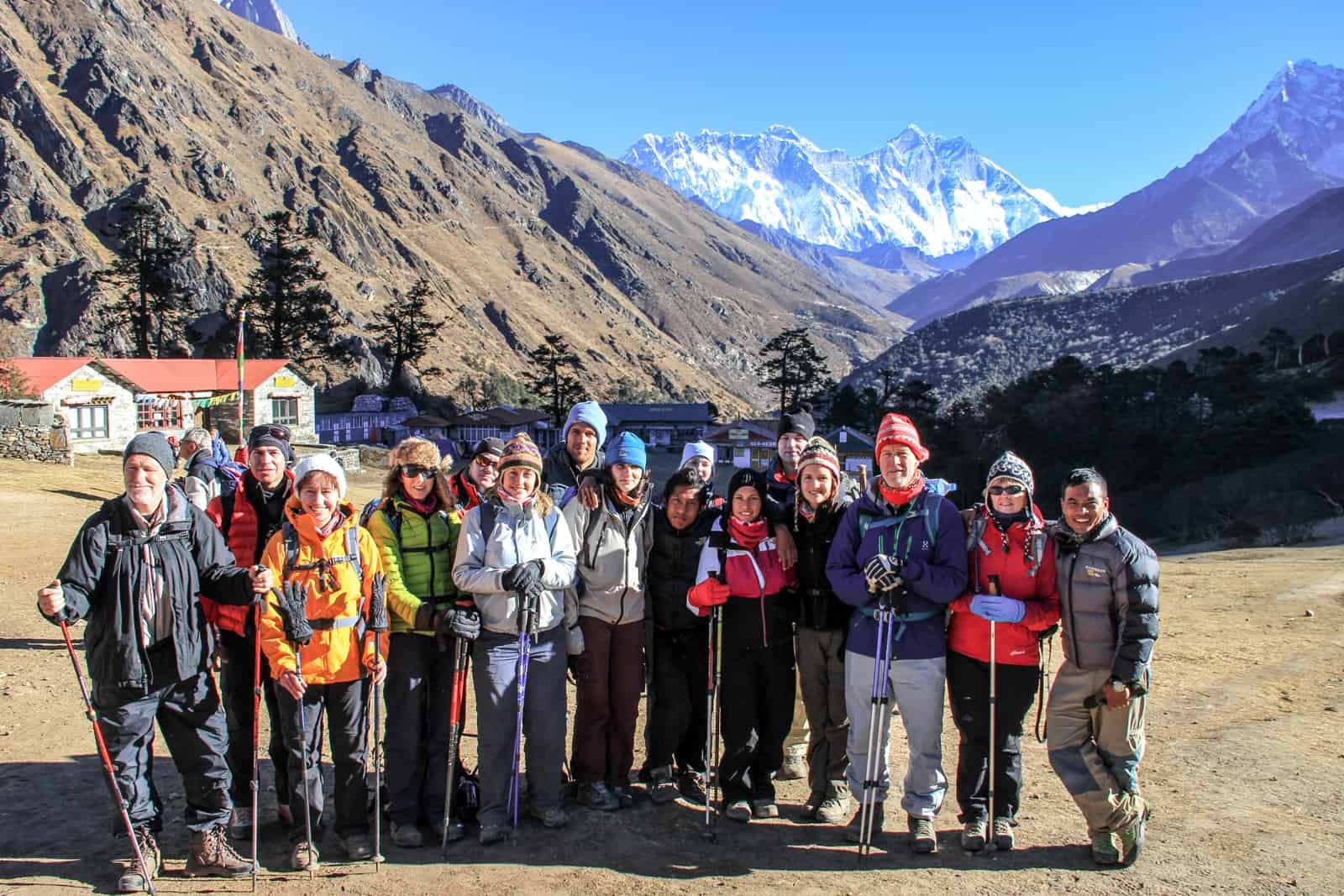
My EBC Trek group and guide
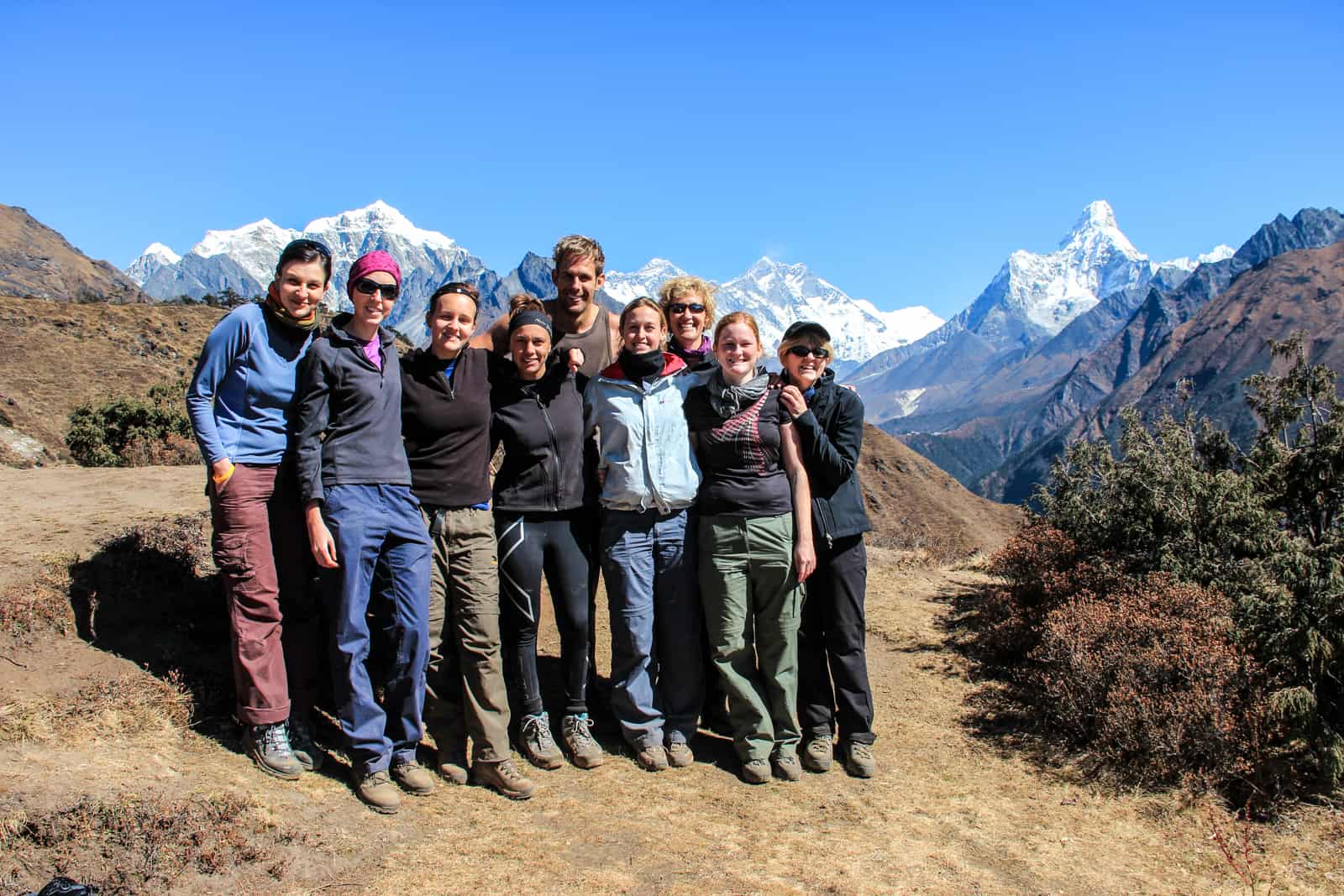
Treks are better when you are together.
How much Does it cost to do the Everest Base Camp Trek?
I’ve seen the Everest Base camp trek cost starting from $1,200 up to $1,600, but it helps to know what’s included and the ethics of the company, including how they support their porters and other local staff and resources.
Usually, what is included in the trek cost of Everest Base Camp is:
- At least one night of accommodation in Kathmandu on either side of the trek
- Return flight to Lukla from Kathmandu
- Accommodation for the entire trek (typical teahouses in Nepal)
- A licensed and trained trekking guide
- Porters for carrying your larger bags and supplies for the trek
- Permits for trekking and the National Park/Conservation Area entry permit
The main variable that differs from company to company is the inclusion of all meals and beverages at the trekking camps and EBC teahouses while trekking.
Some treks are cheaper because food and drink are not included, and you can set aside a personal budget for this.
What’s NOT included in the trek cost:
- Travel insurance, which you must arrange yourself and ensure it includes emergency rescue
- International flights/airfare
- Visa costs for Nepal and the organisation of the trek
- Rental of equipment like a sleeping bag or down jacket (you can do this in Kathmandu before the trek)
- General trekking gear, such as walking poles
- Snacks
- Medication (including altitude sickness tablets)
Everest Base Camp Trekking Permits
There are two permits required to trek the Everest Base Camp trail.
- The Khumbu Pasang Lhamu Rural Municipality Entrance Permit replaced the old Trekkers Information Management System (TIMS) permit in October 2018. It costs NPR 2000 Per Person and is obtained in Lukla.
- The Sagarmatha National Park Entry Permit is needed since you will trek through the park. It costs NPR 3000 Per Person.
However, on most organised small group trips, these permits are managed by your guide and included in your overall tour cost. It’s worthwhile to check if they are included.
Can I Visit Tibet Everest Base Camp?
I have also visited Tibet Everest Base Camp on a countrywide overland tour. On a separate trip, you can travel to Tibet on a two-week adventure (on a round trip from Kathmandu), which passes through the Tibetan region of Rombuk.
Visiting Base Camp on the Tibetan side isn’t a multi-day hike though, but more of a long walk to the Base Camp boundaries from the Monastery in Rombuk where you stay overnight. Everest Base Camp on the Tibet side has recently been moved back by 7km, making the proximity to Everest mountain even less attainable, yet nothing beats the flipside view of it.
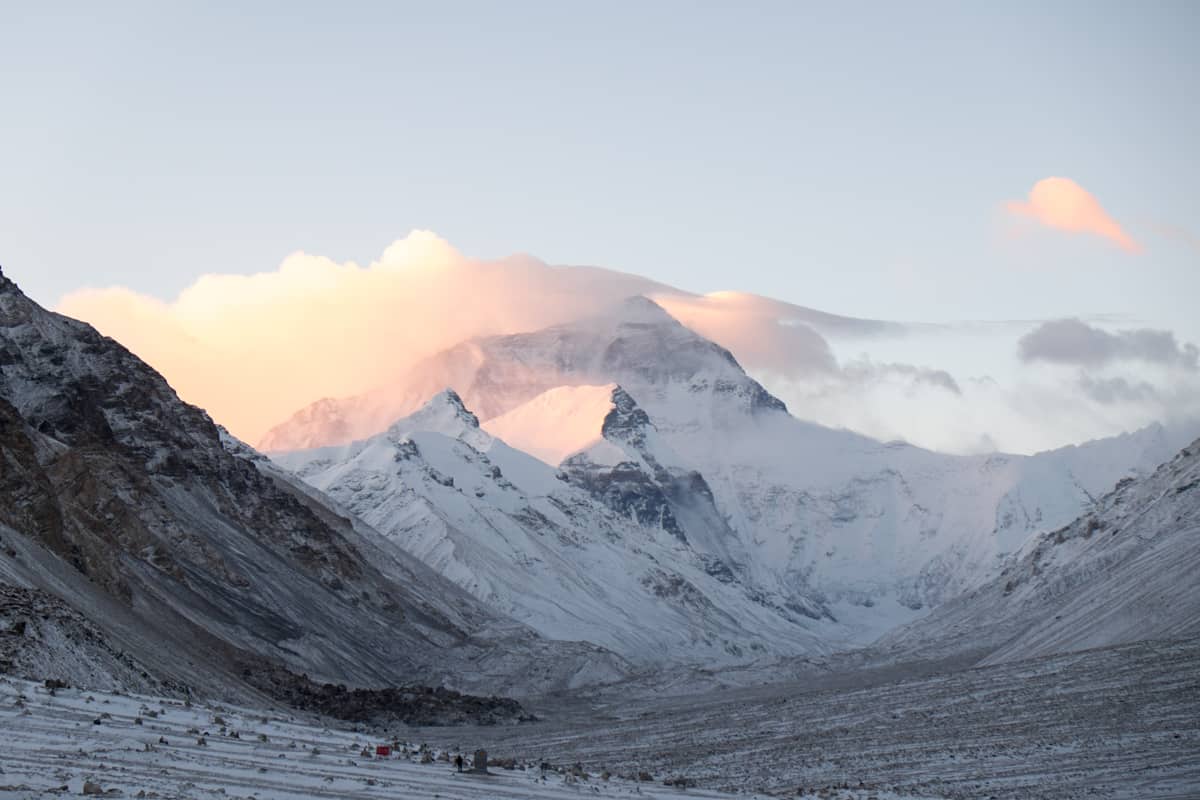
Tibet Everest Base Camp
Day-To-Day Trekking Guide
Everest Base Camp Trek Itinerary: Day One
Leaving Kathmandu, you’ll brave an early morning flight to Lukla – a small aircraft where the engine roars for 40 minutes (muffled in vain by the complimentary cotton wool from the flight attendant that you’re urged to stuff into your ears). The wind lightly wobbles you in the air until you touch down on the famous short, steep and precarious mountain-side runway that Lukla is known for.
The Lukla flight is included in your EBC trip itinerary.
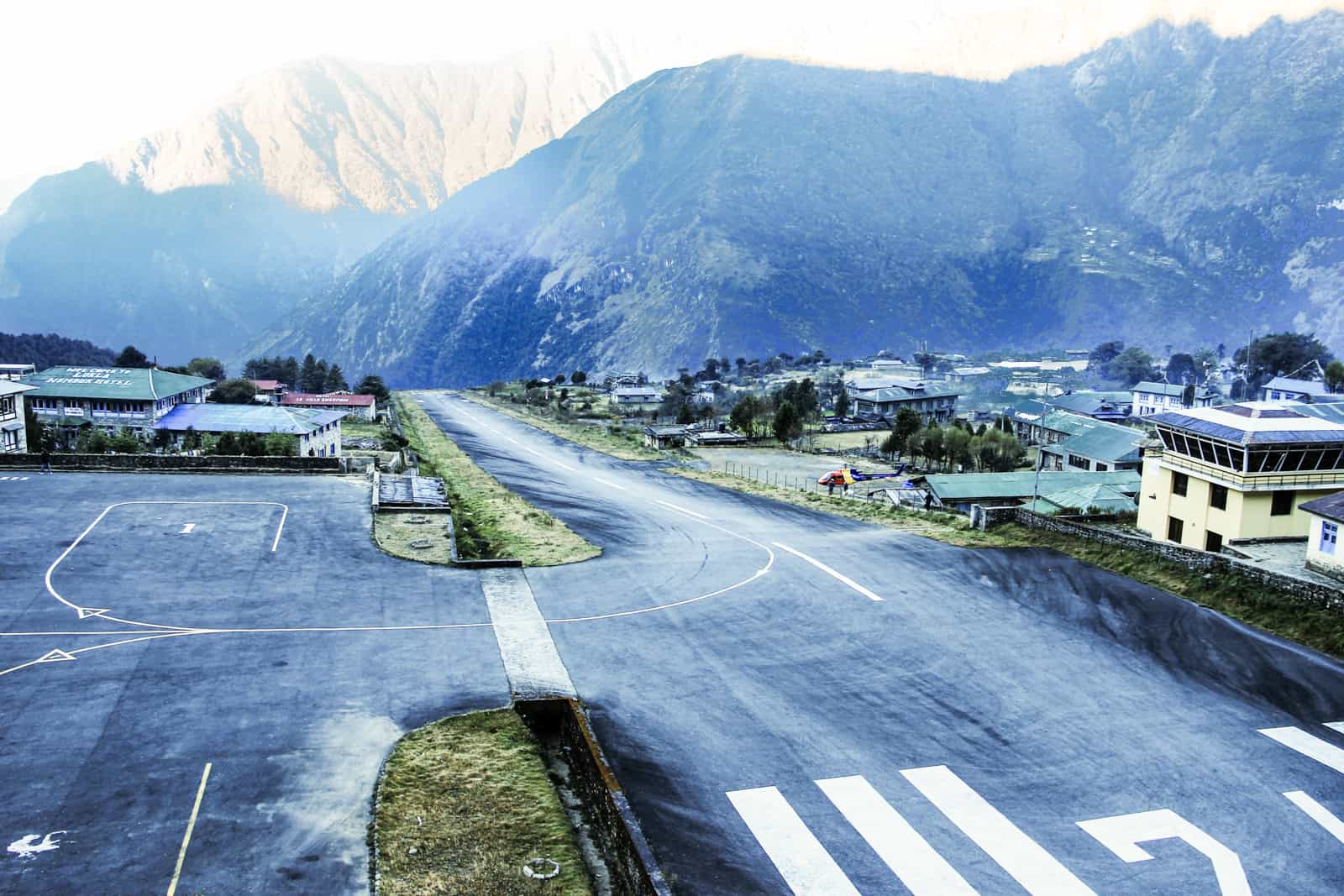
The short mountain-side runway at Lukla airport
Cheering at the successful landing and knowing that we were still alive after this nail-biting experience, we went to breakfast full of excitement about the trek ahead – a three-hour, uphill climb that wasn’t too taxing. Little did we know how much harder it would be and how much colder it would get.
Savour that first night. It’s one of the most comfortable.
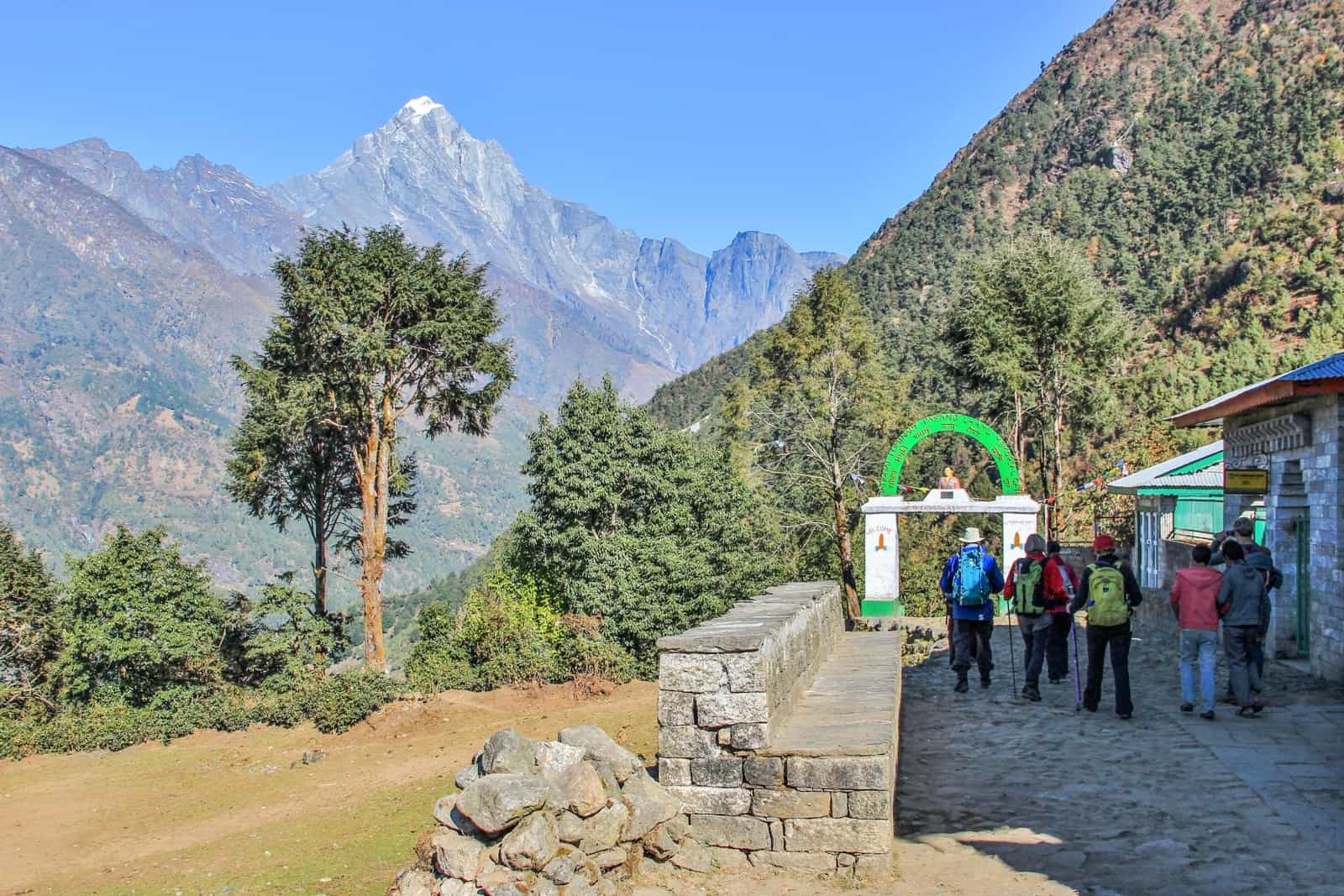
The group begins the Everest Base Camp trek from Lukla.
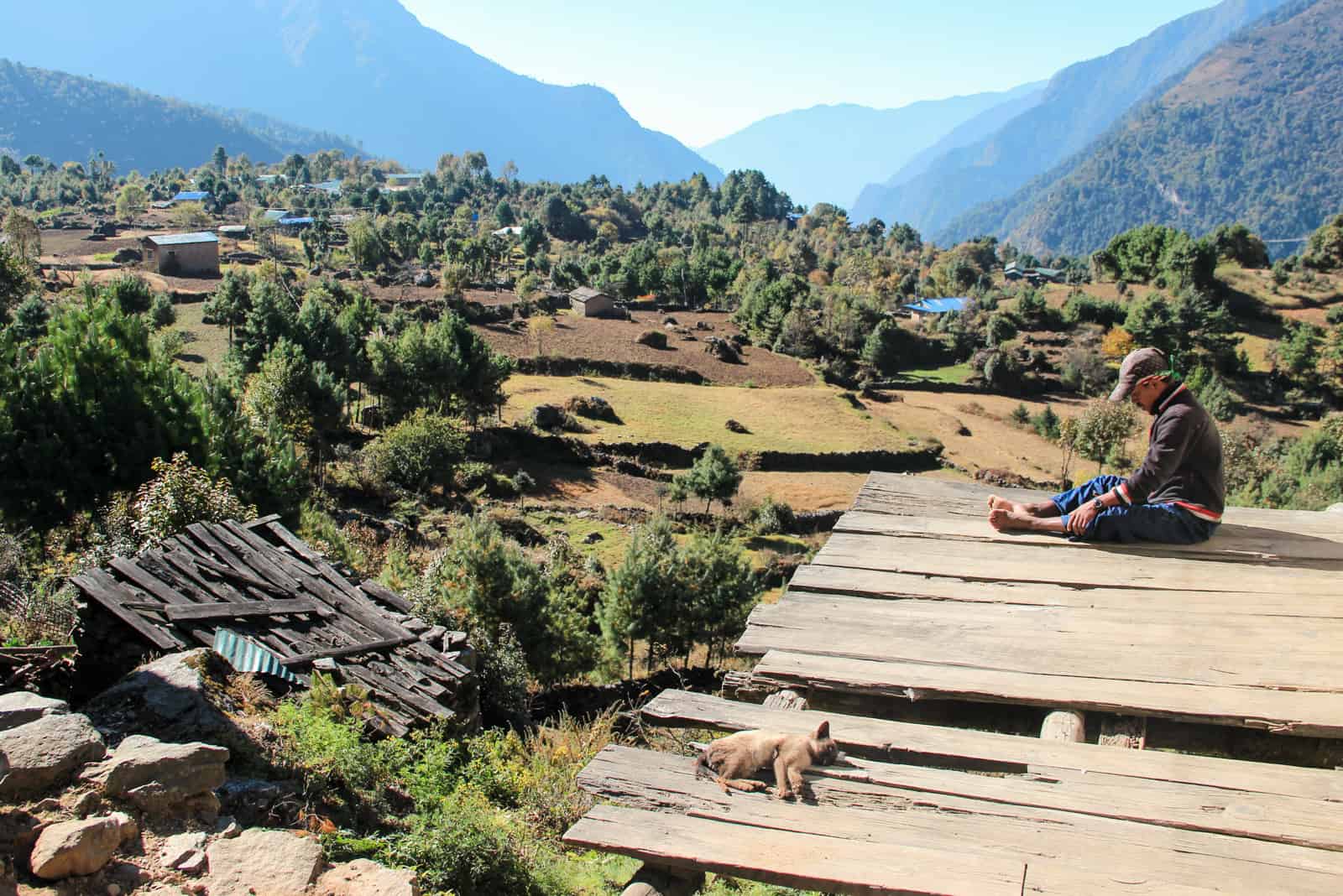
The forested Sagarmatha National Park on the Everest Base Camp Trek
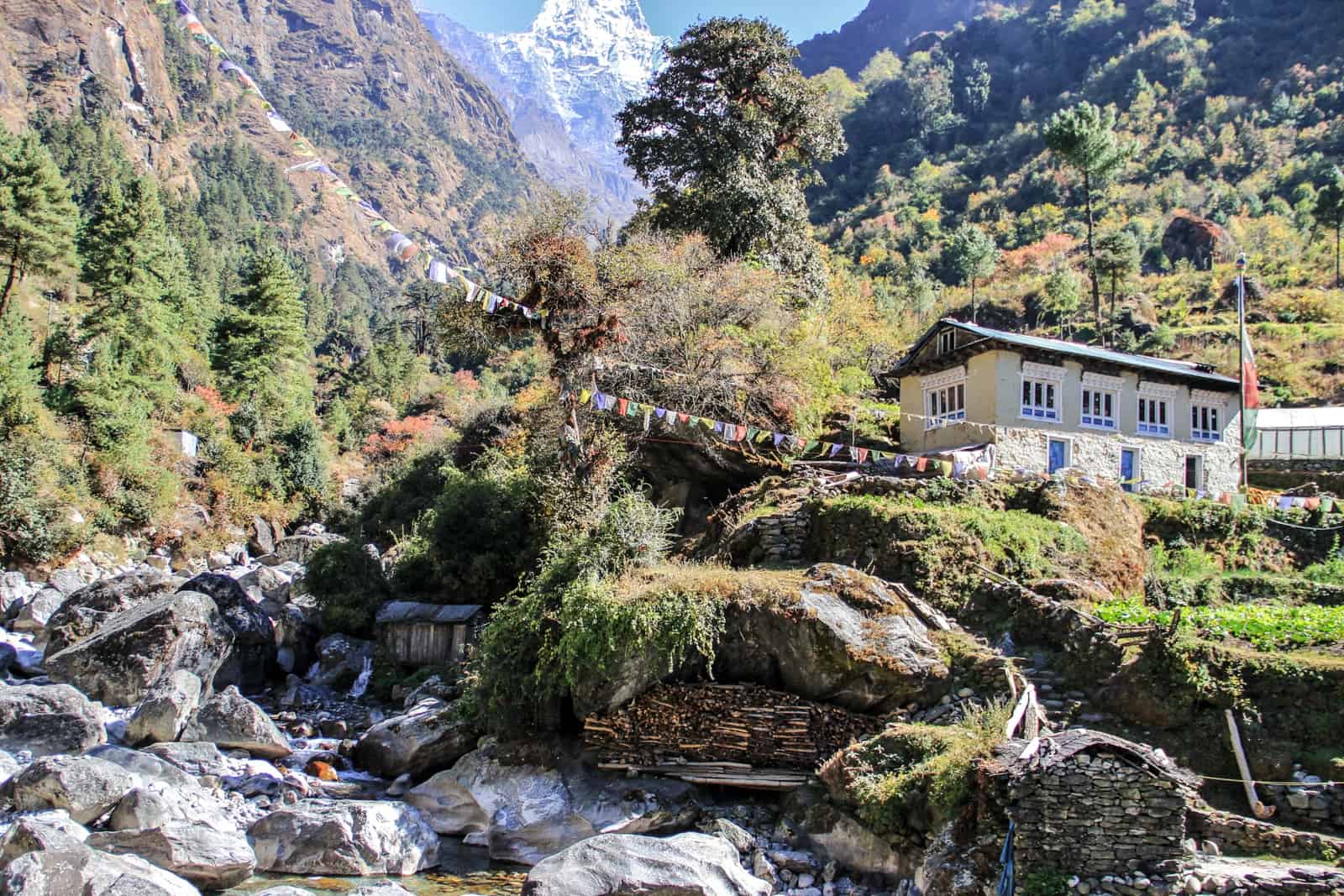
Constant mountain views on the trek
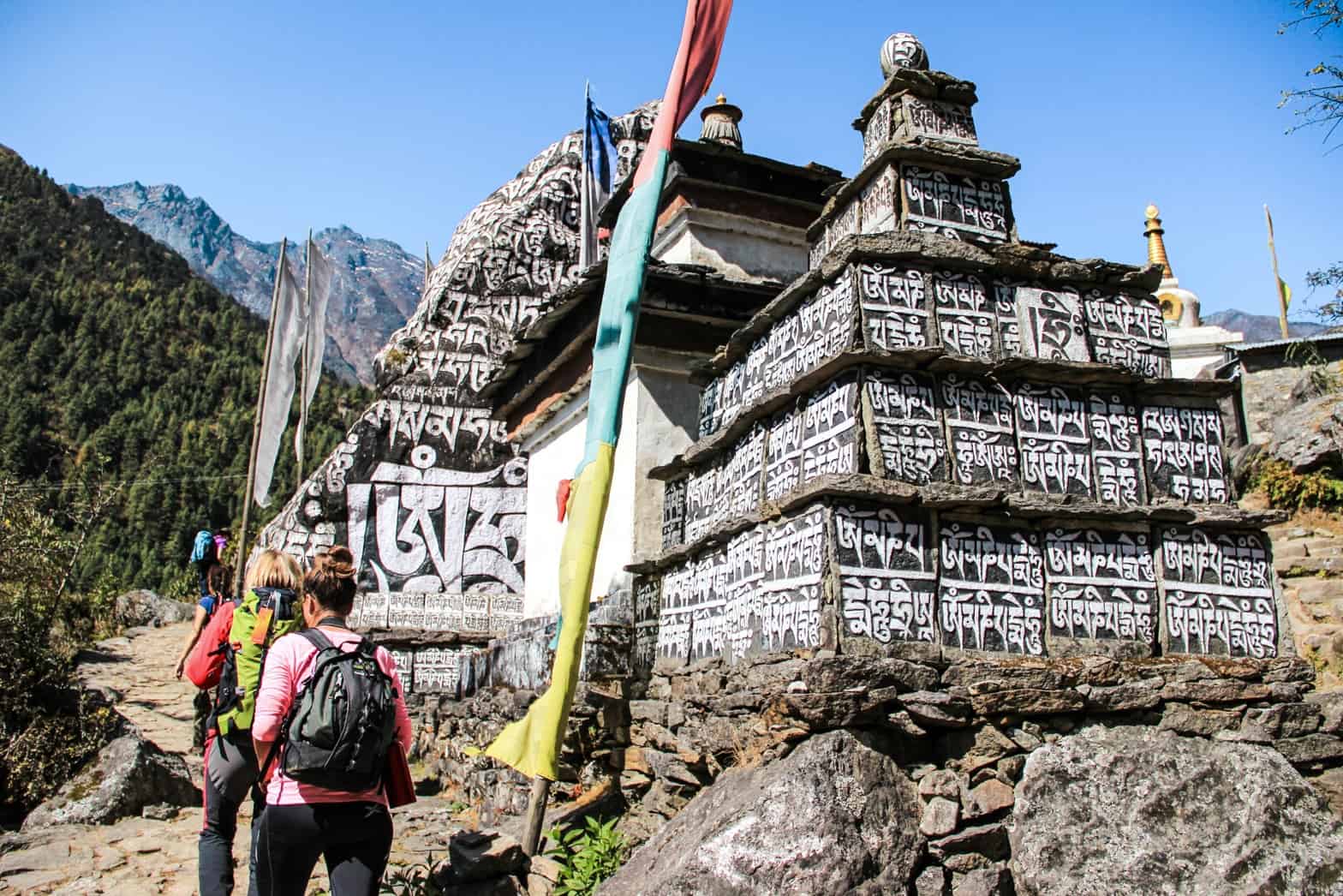
Passing a sacred site on the Everest Base Camp Trek – one of the many temples and monuments along the way
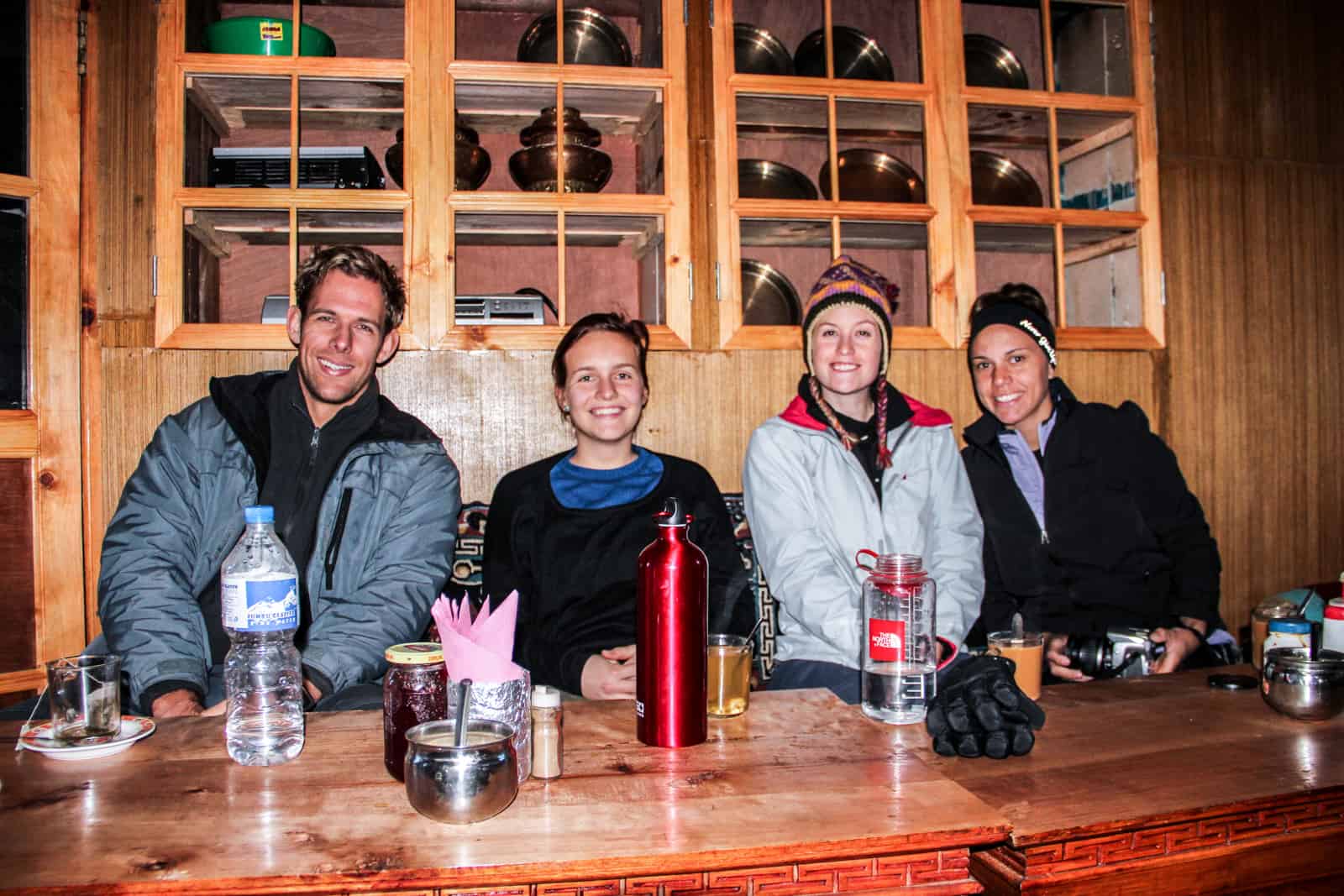
Reaching the teahouse in the afternoon.
Everest Base Camp Trek Itinerary: Day Two
On day two, we made our way to the well-known Namche Bazaar – one of the biggest rest areas full of markets, restaurants and Wi-Fi cafes. Sounds amazing, right? Yet reaching this haven at 3,440 metres requires an extreme effort.
Said to be one of the toughest parts of the Everest Base Camp trek, I found this day one of the hardest, alongside the day of getting to Everest Base Camp itself.
It involved six hours of high climbing and steep steps through stunning forest, crossing rivers via long, swaying suspension bridges and relentless physical exertion in dusty, dry heat, which sent my adrenalin levels pumping so high that all I could do when I reached the lodge was sit and cry in exhaustion.
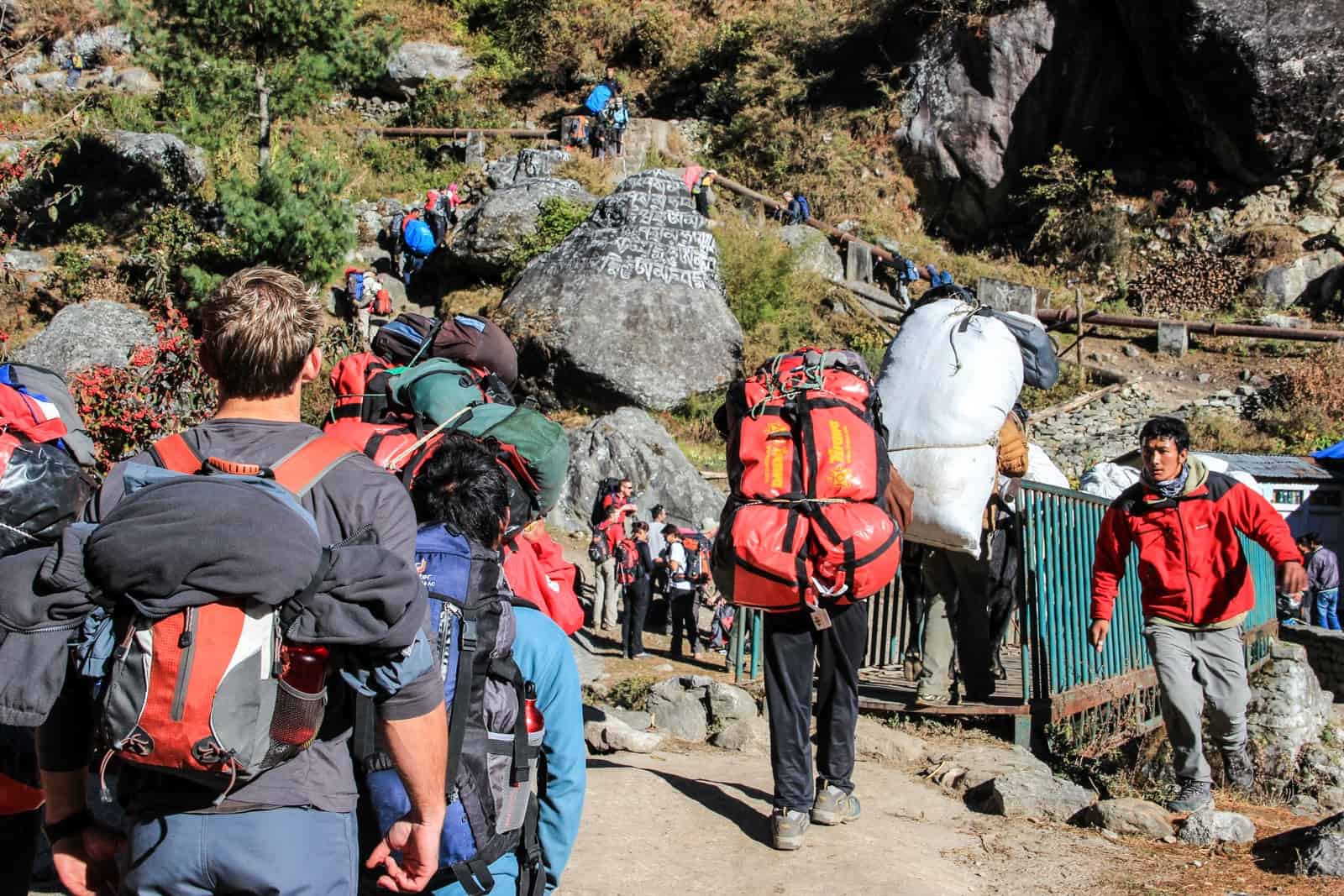
Bridges and steep climbs on Day 2
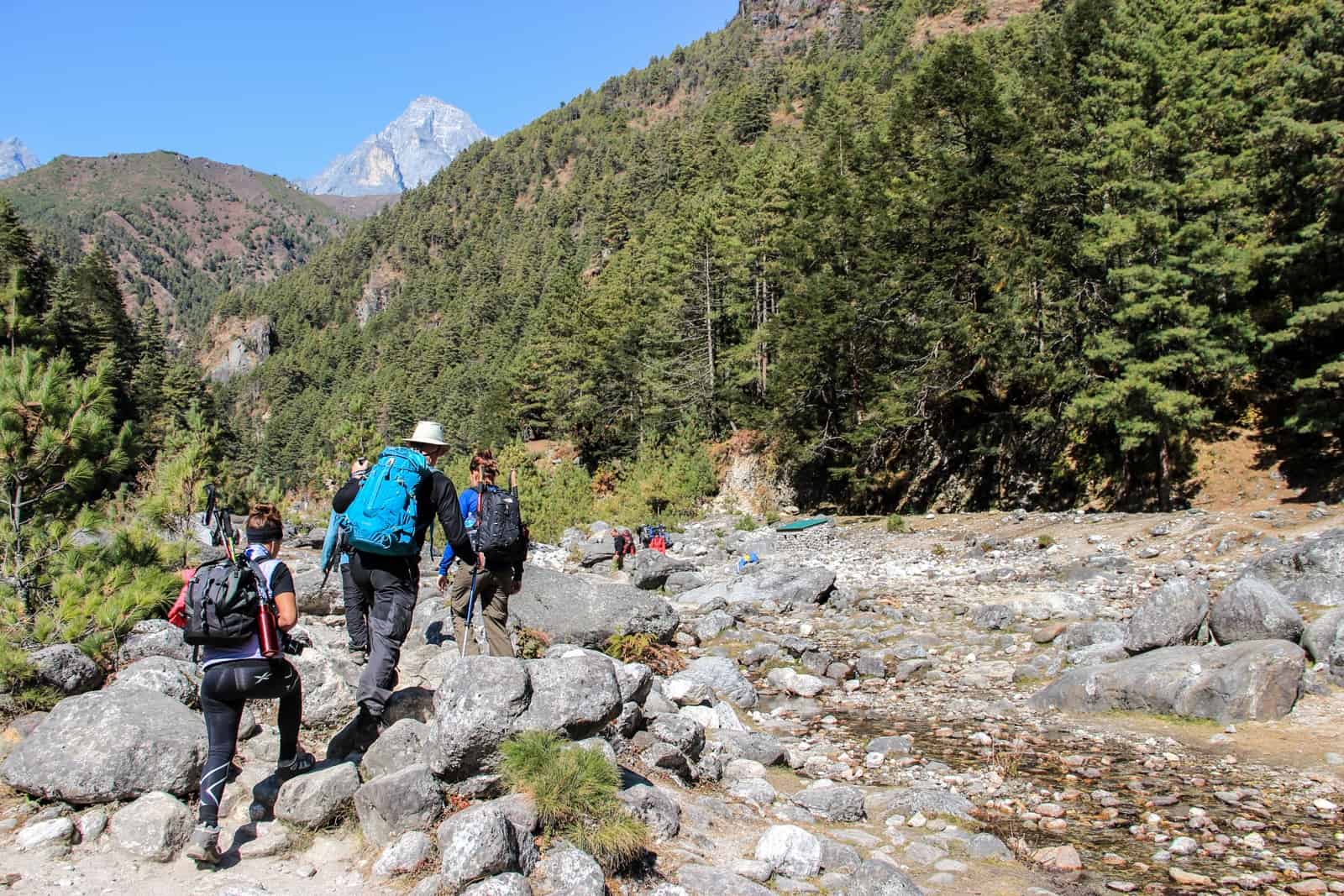
The long push to Namche Bazaar
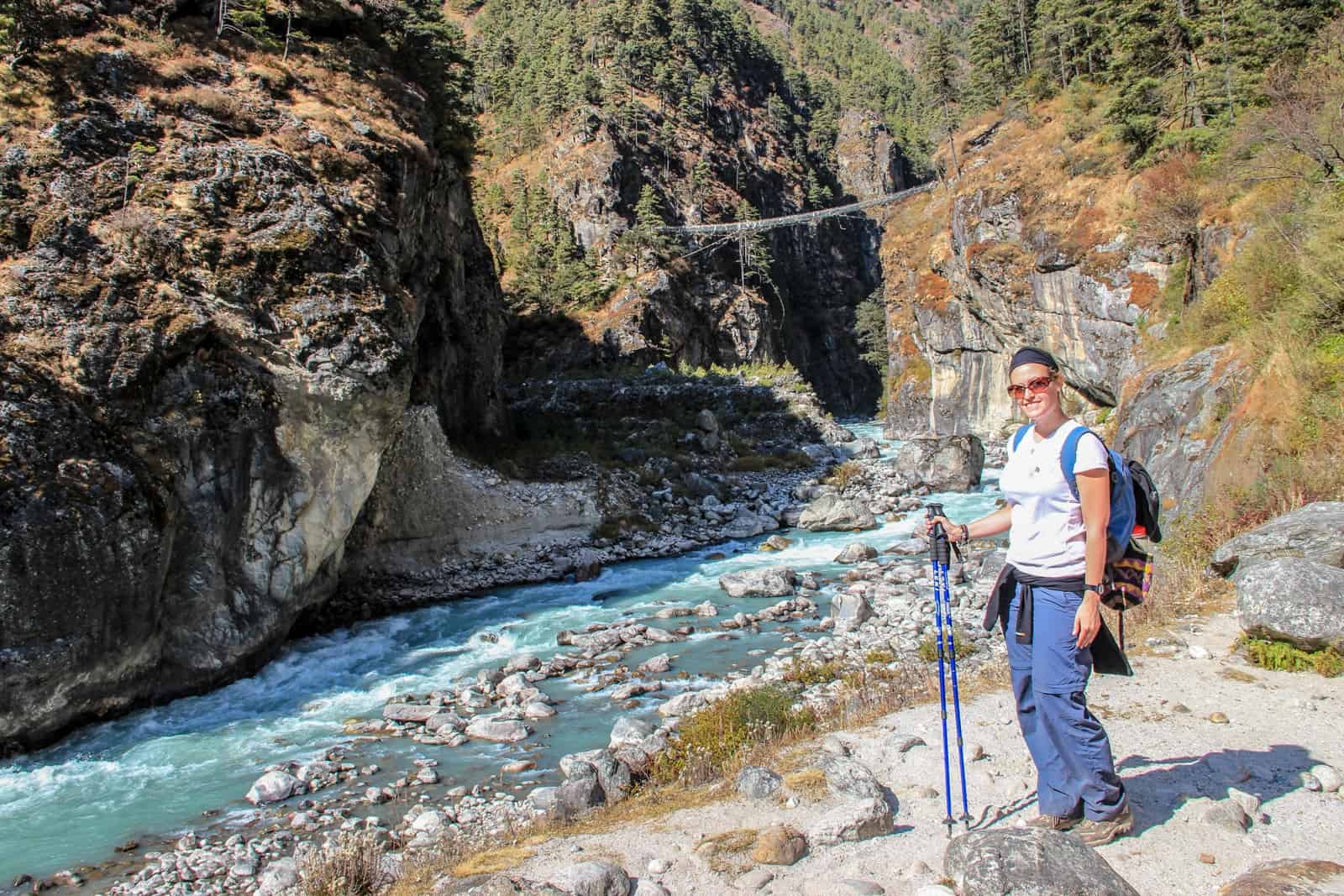
A rest stop before continuing. See the bridge in the distance?
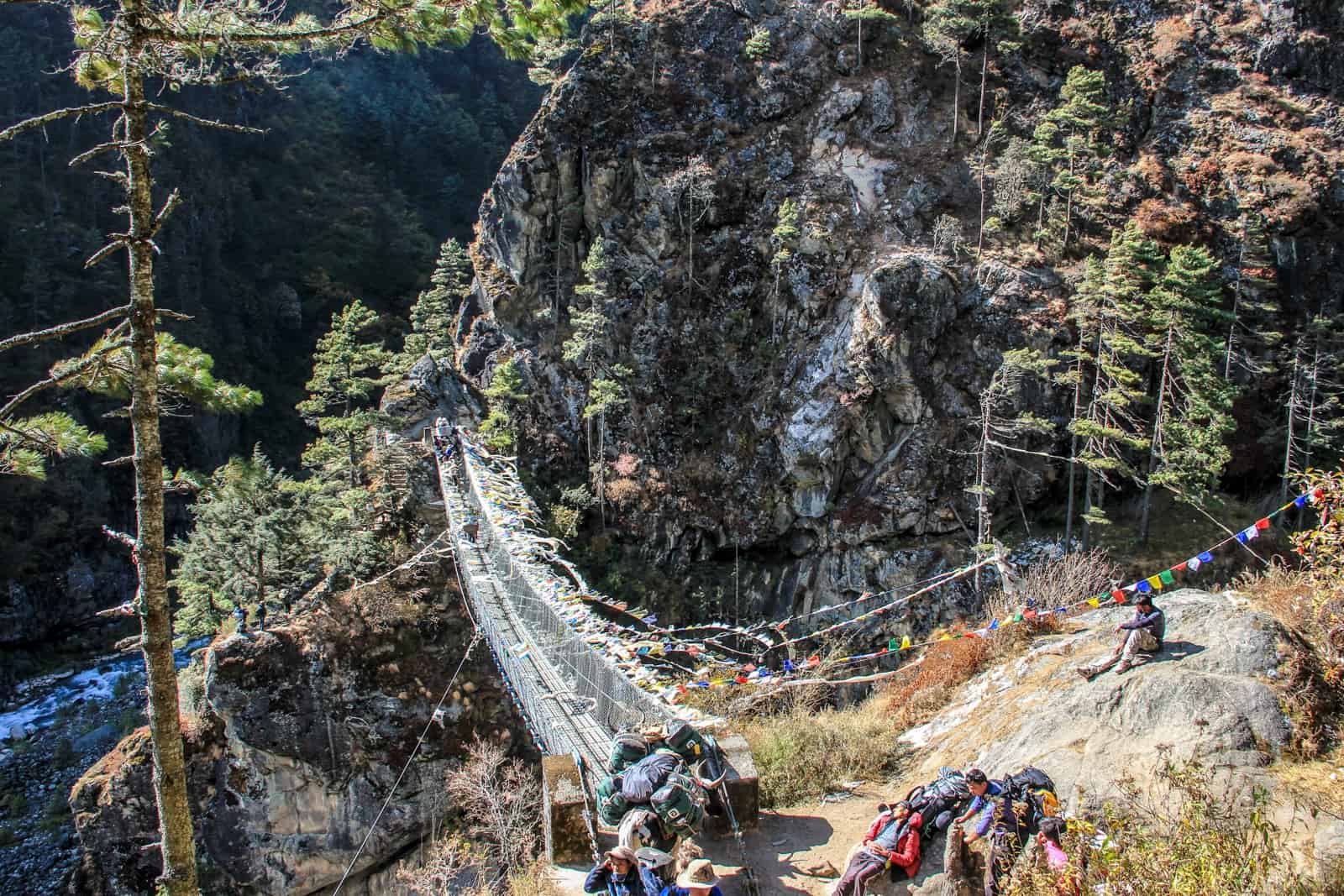
There it is. One of the many suspension bridge crossings on the Everest Base Camp Trek
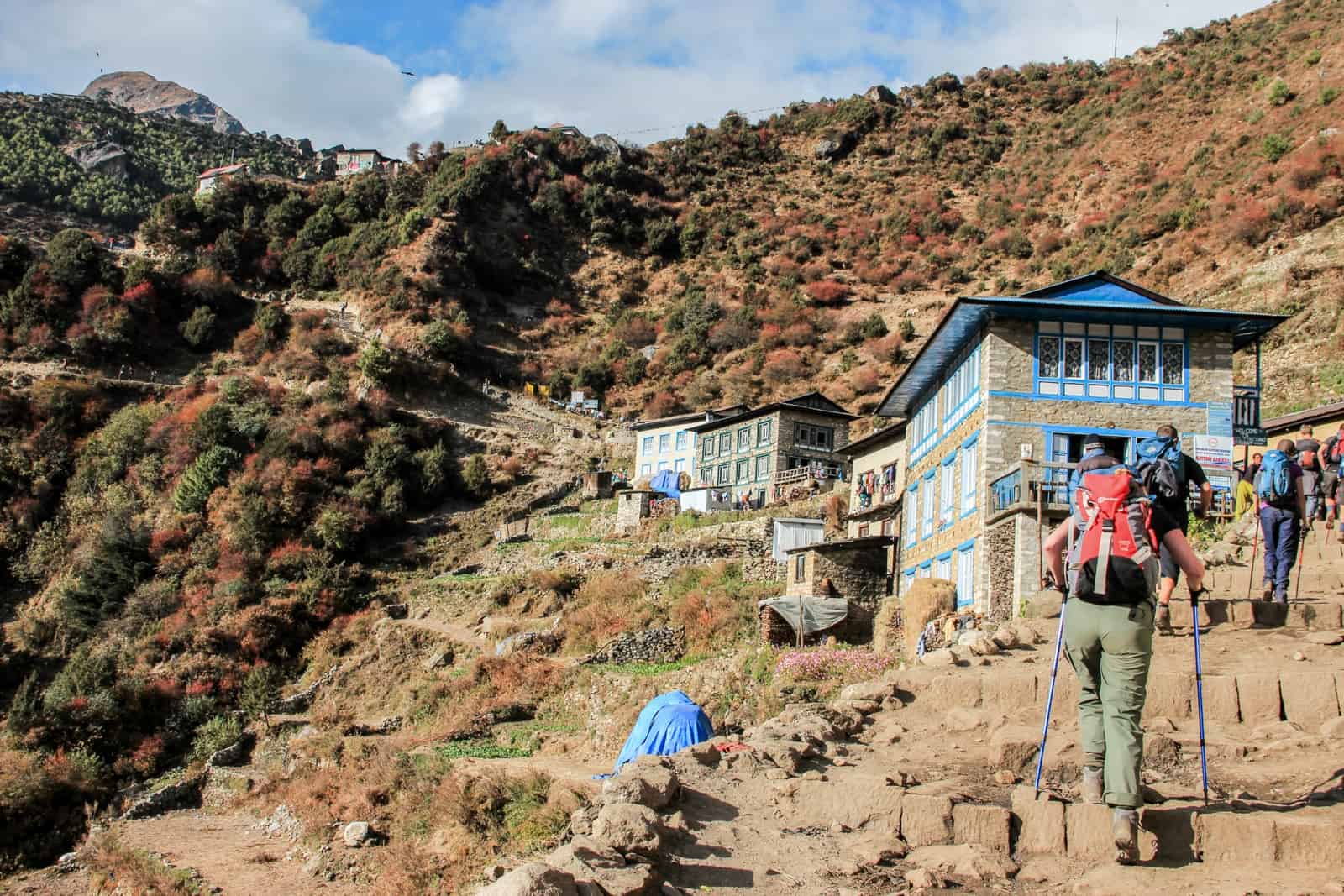
One of the last uphill segments towards Namche Bazaar
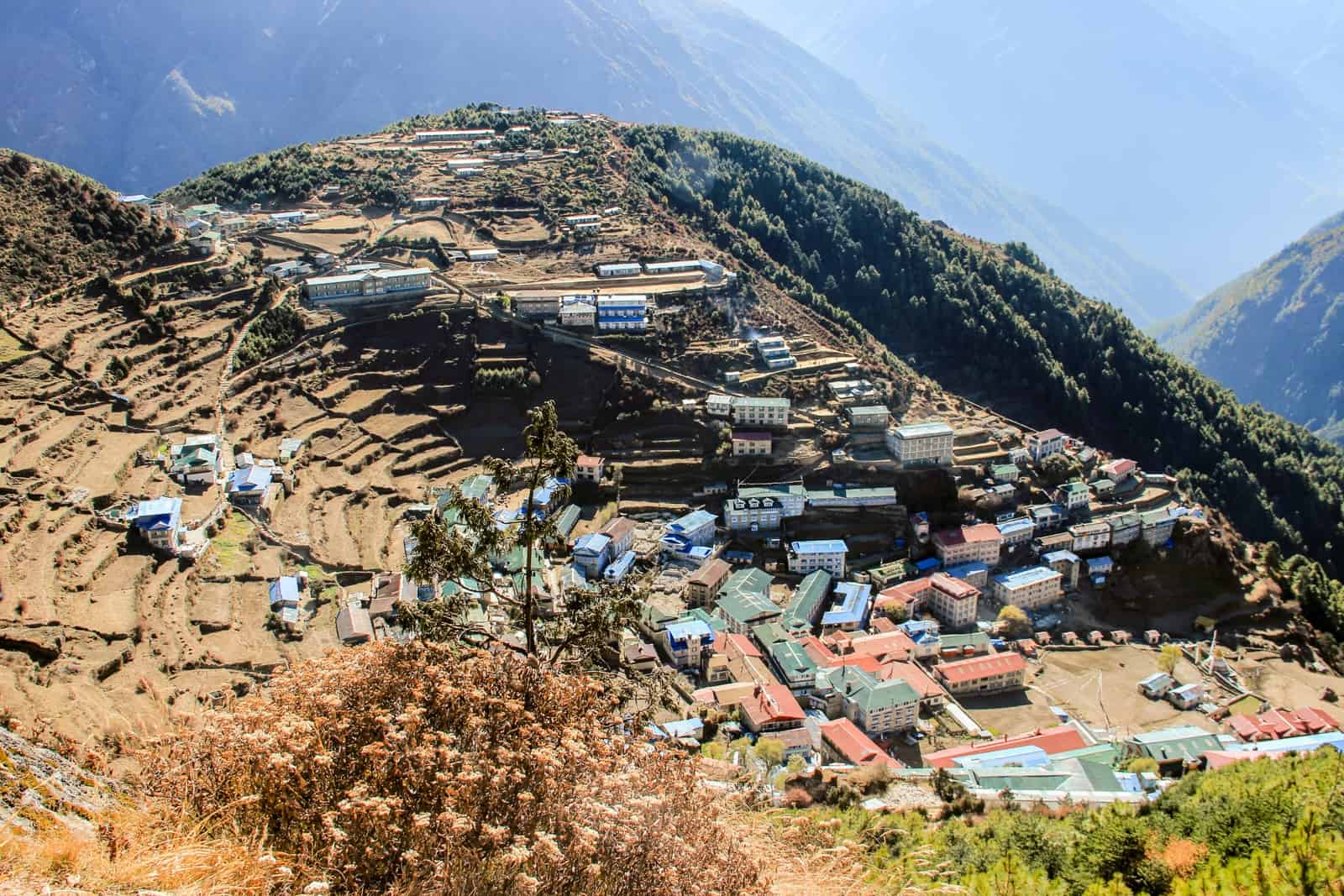
The elevated view of Namche Bazaar on approach
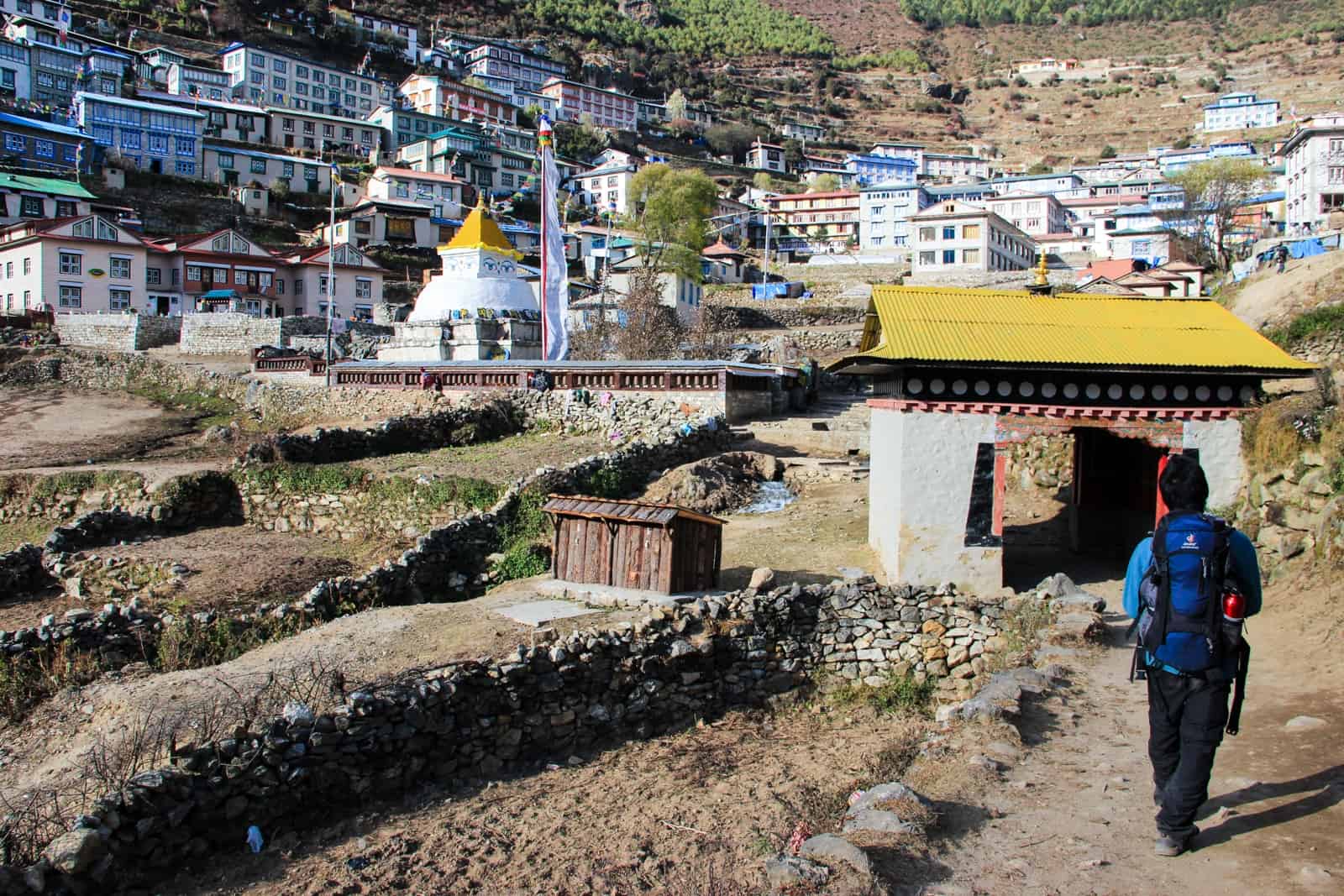
Reaching the gate of Namche Bazaar.
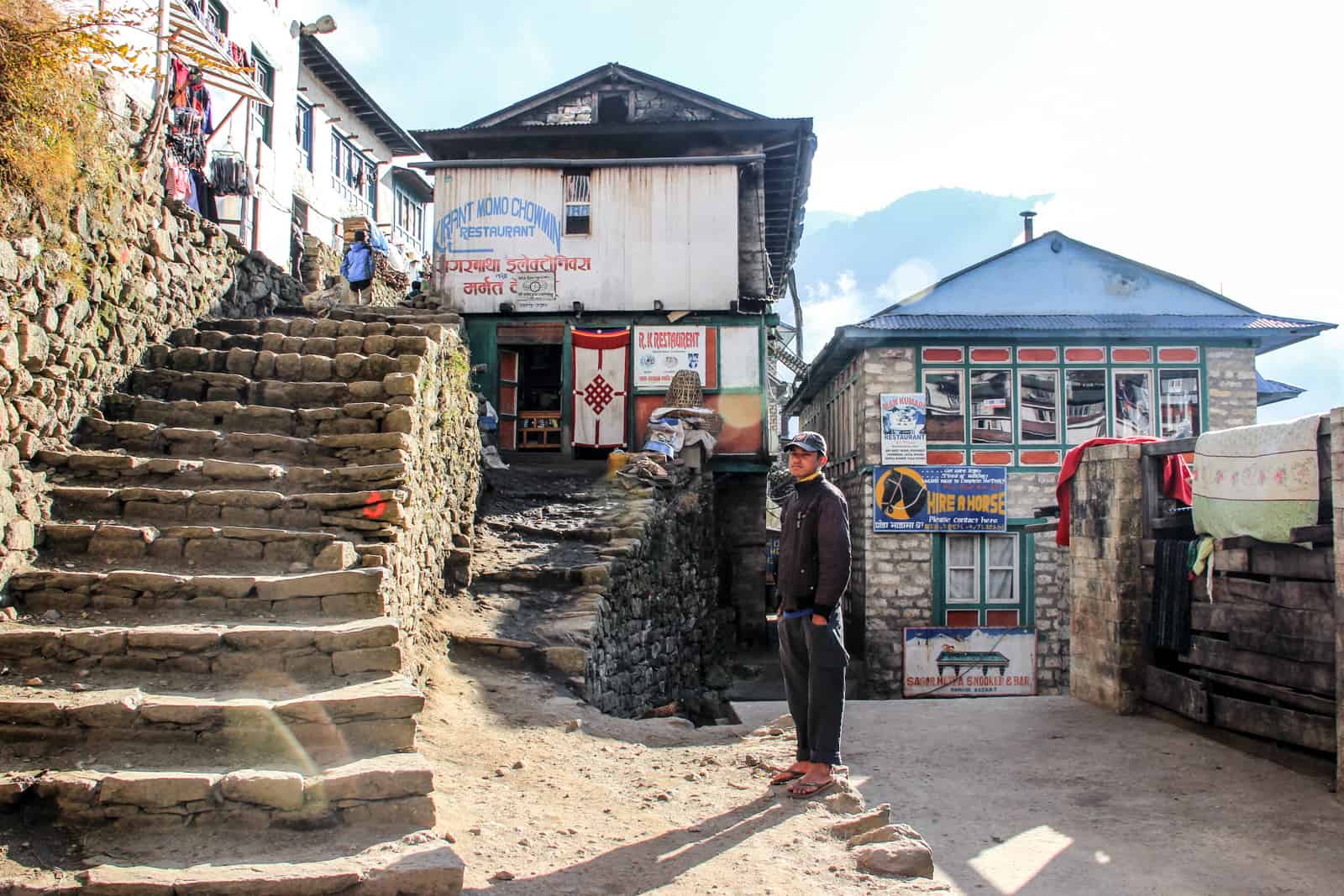
You spend two days at Namche Bazaar for acclimatisation.
Everest Base Camp Trek Itinerary: Day Three to Day Seven
Five more trek days follow, of which two are ‘acclimatisation days’. The first acclimatisation day is day three (the second day you spend in Namche Bazaar) when you trek to the villages of Thame and Khumjung, and day six of the trek when you are in Dingboche at 4,260 metres, and you trek to Chhukung village or Nagarzhang Peak.
An acclimatisation day means climbing. It’s often called a ‘rest day’, but this is a glittery term for an acclimatisation day. Sadly, it is not an opportunity for a lie-in or to put your feet up. You climb high and sleep lower, so while you are not trekking for three to six hours, you will spend approximately two hours hauling yourself up a steep hill for your body to get used to the next stage of high altitude – a painful but necessary evil which makes the forthcoming trekking days a little easier.
Your body will start feeling the effects of altitude at this stage. It’s on day four (when you trek from Namche Bazaar to Tengboche) and day five (when you trek from Tengboche to Dingboche) that you start to feel the changes in the air. Just when you thought you had regained your breath, you are off again to reach a higher altitude, a dry run, ready to make the ascent properly the next day.
It’s a heady mix of short and high climbs, but each step is one closer. Day seven is the push towards Lobuche – the final village settlement on the fringes of the Khumbu Glacier, where you will rest before making the final trek towards Everest Base Camp the next morning.
Reaching Mount Everest Base Camp – Exhaustion and Euphoria
Higher altitude, colder temperatures and a tougher climb all come together in a force you think will defeat you. You will never forget the day prior and the actual day of the last, long slog to get to Mt. Everest Base Camp. It’s day eight, and you are beyond exhausted. This becomes some of the hardest few hours of the entire expedition.
The knowledge you are so close to the base, mixed with unbeatable views, are two things that help you pull through it.
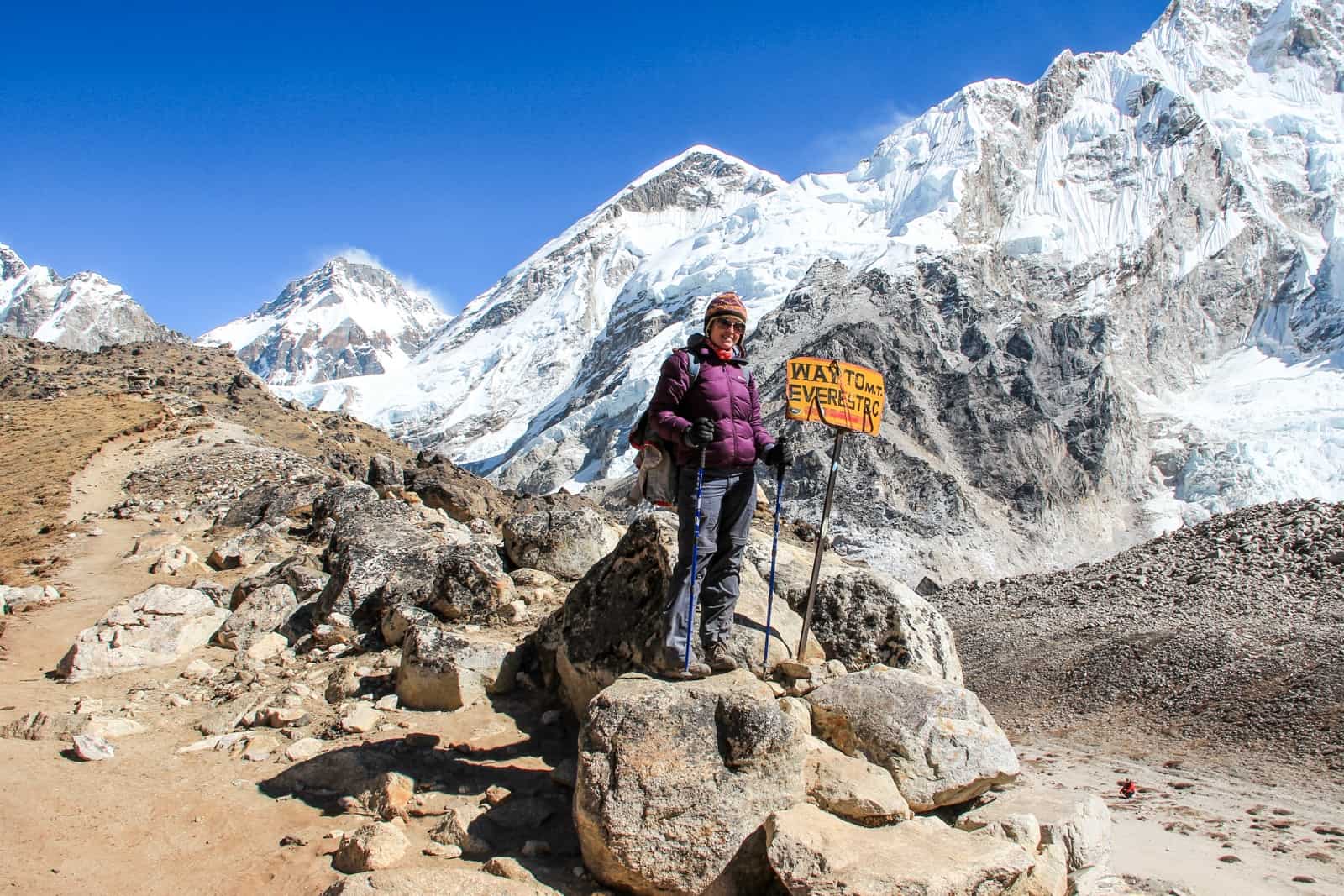
Reaching Base Camp and standing at 5,364 meters is indescribably euphoric, even with depleted energy levels. It’s like standing within a snow globe, where the magnificent snow-peaked mountains, the Khumbu icefall and the imposing presence of Everest loom before you in a striking white glow.
It’s something I will never forget, from the first glimpse of the magnificent view to the congratulatory atmosphere all around me.
Since we were outside of the April to May climbing season, we didn’t encounter the Everest camps like those in the famous photos of people climbing Everest. It was, therefore, not a land filled with people ready to go further or where a huge sign signals your end goal. Instead, you are greeted by a huge rock covered in prayer flags to pose with. Just look up, because that’s the most special thing.
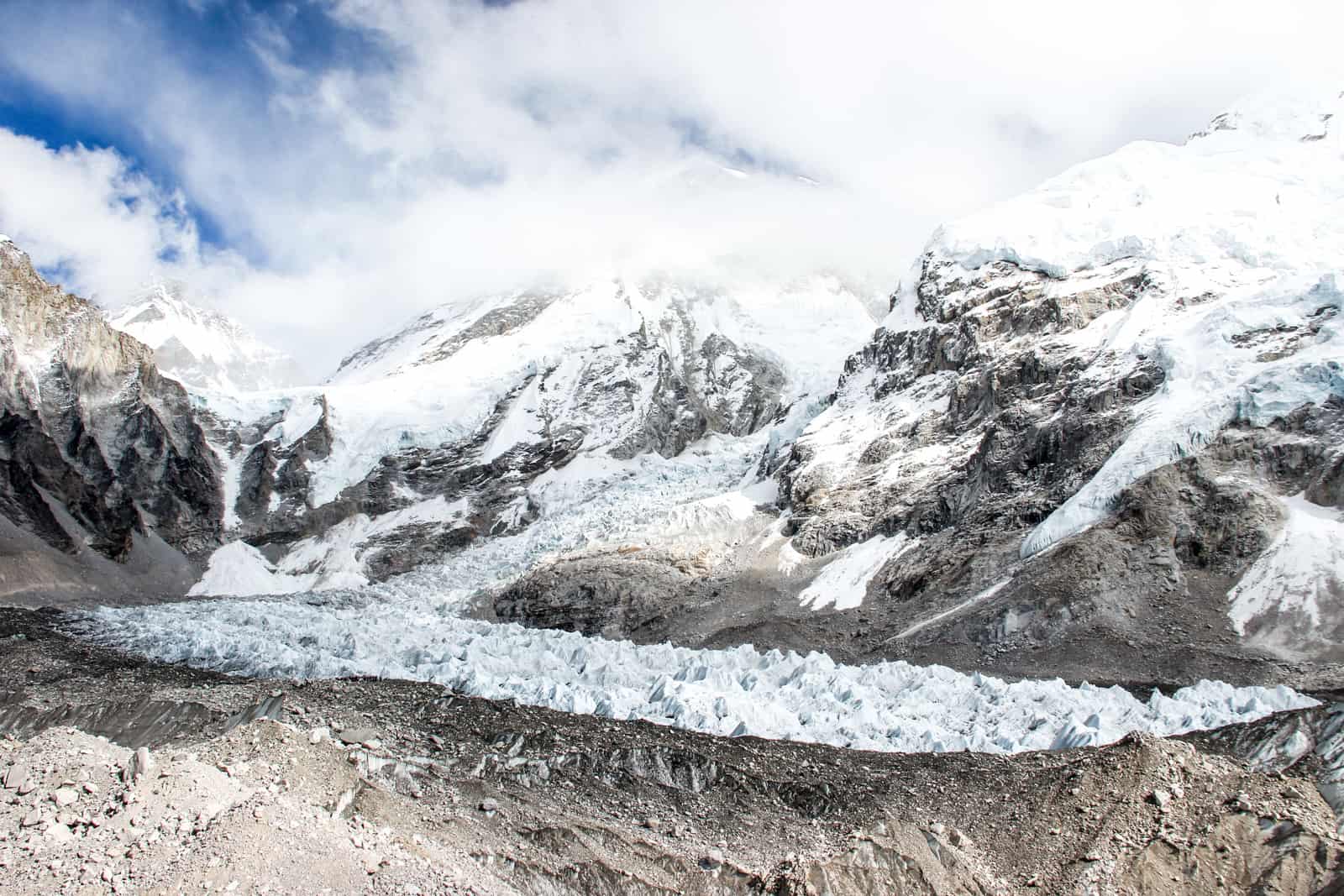
The stretch of spiky ice of the Khumbu icefall at Everest Base Camp
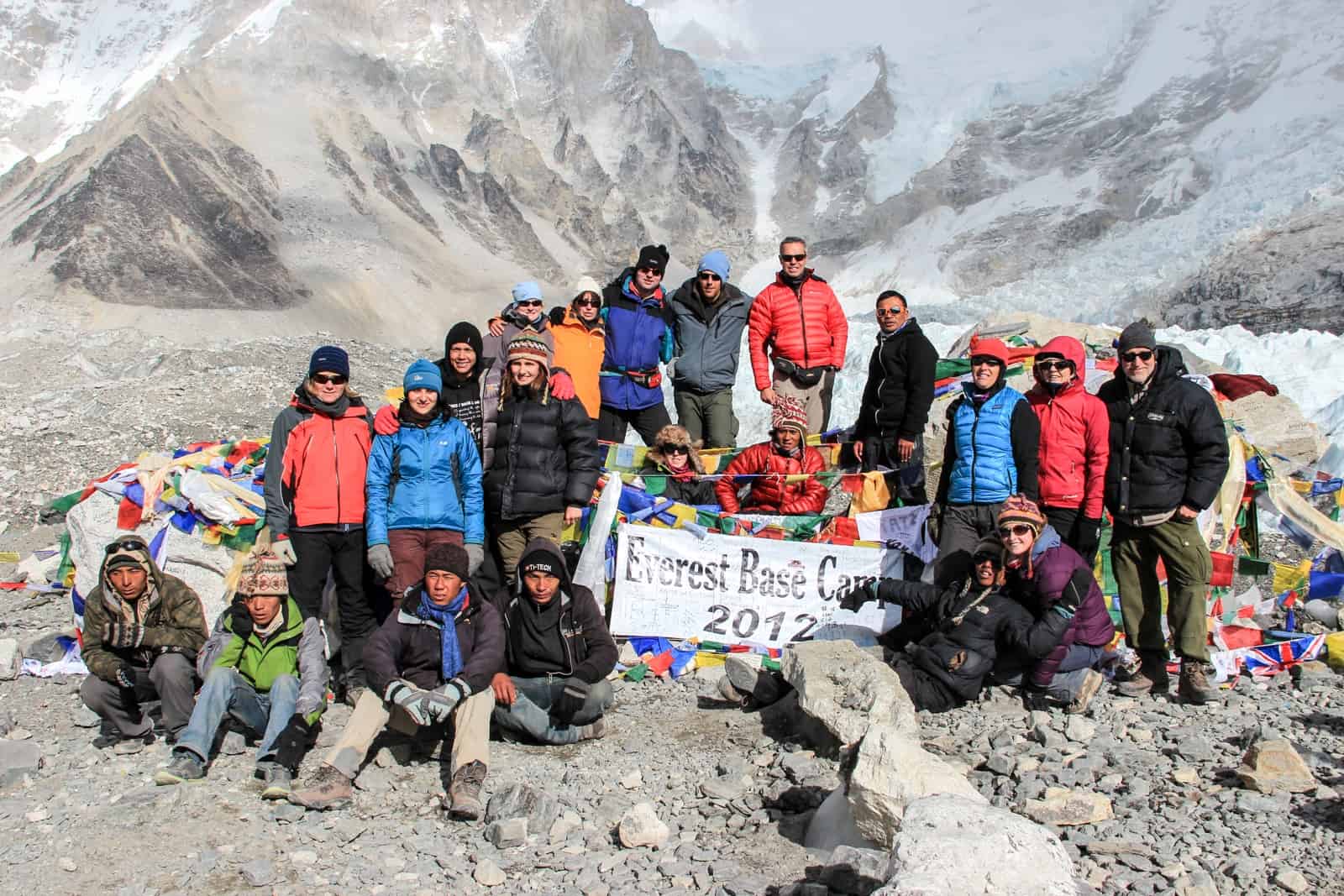
The group reaches Everest Base Camp!
Trekking Back to Lukla after Reaching Base Camp
Everest Base Camp Trek Itinerary: Day Nine to 12
The thought of four days trekking back down is not the greatest and is something you almost have to train your mind not to think about since you have no option but to get back down and on the very same path from which you have already traversed. You’ll often pass the groups on their way up, knowing how it felt in those earlier days of this great expedition.
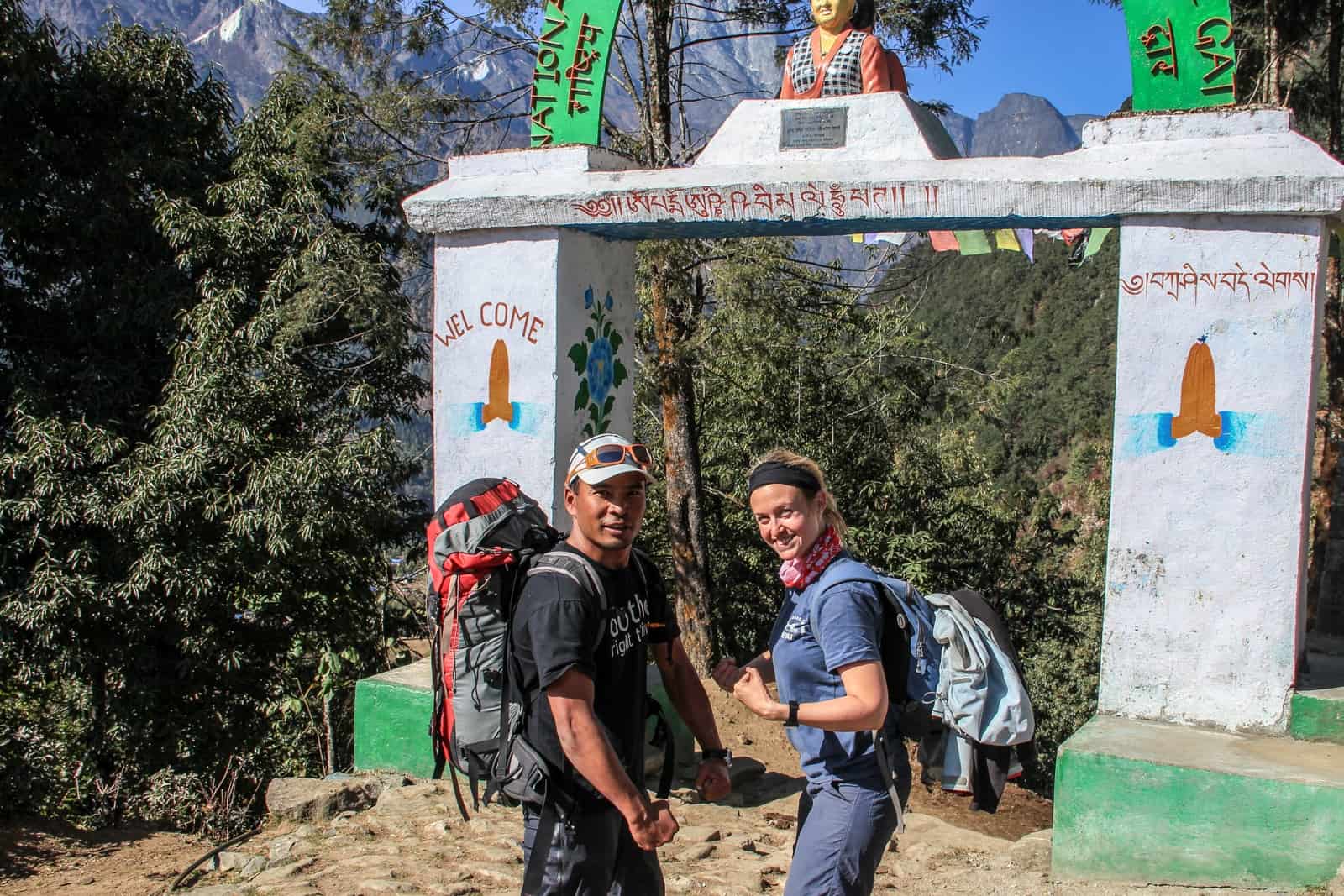
The triumphant return to the starting Lukla Gate
When the way down is tough and feels repetitive, remember one thing. A celebratory party awaits you in Lukla – a land full of happy people, happy hour, decent food, strong cocktails and a rave with your newfound friends. The Everest Base Camp trek is like a detox or a short spell of rehab – no sexual activity, alcohol or meat allowed or advised for 12 days.
Lukla is the release, and you deserve it. Further celebrations continue in Kathmandu.
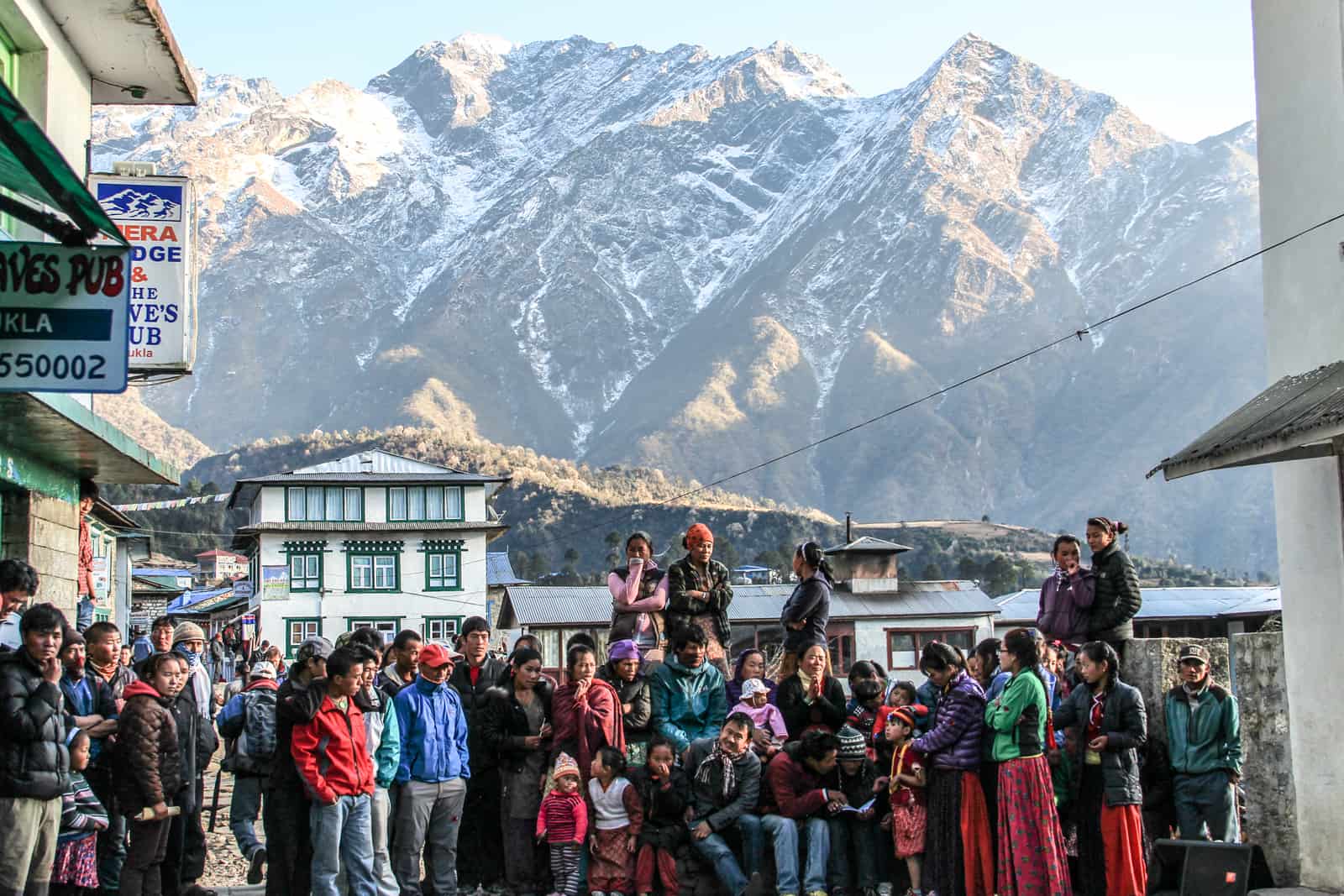
The mountain backed town. of Lukla
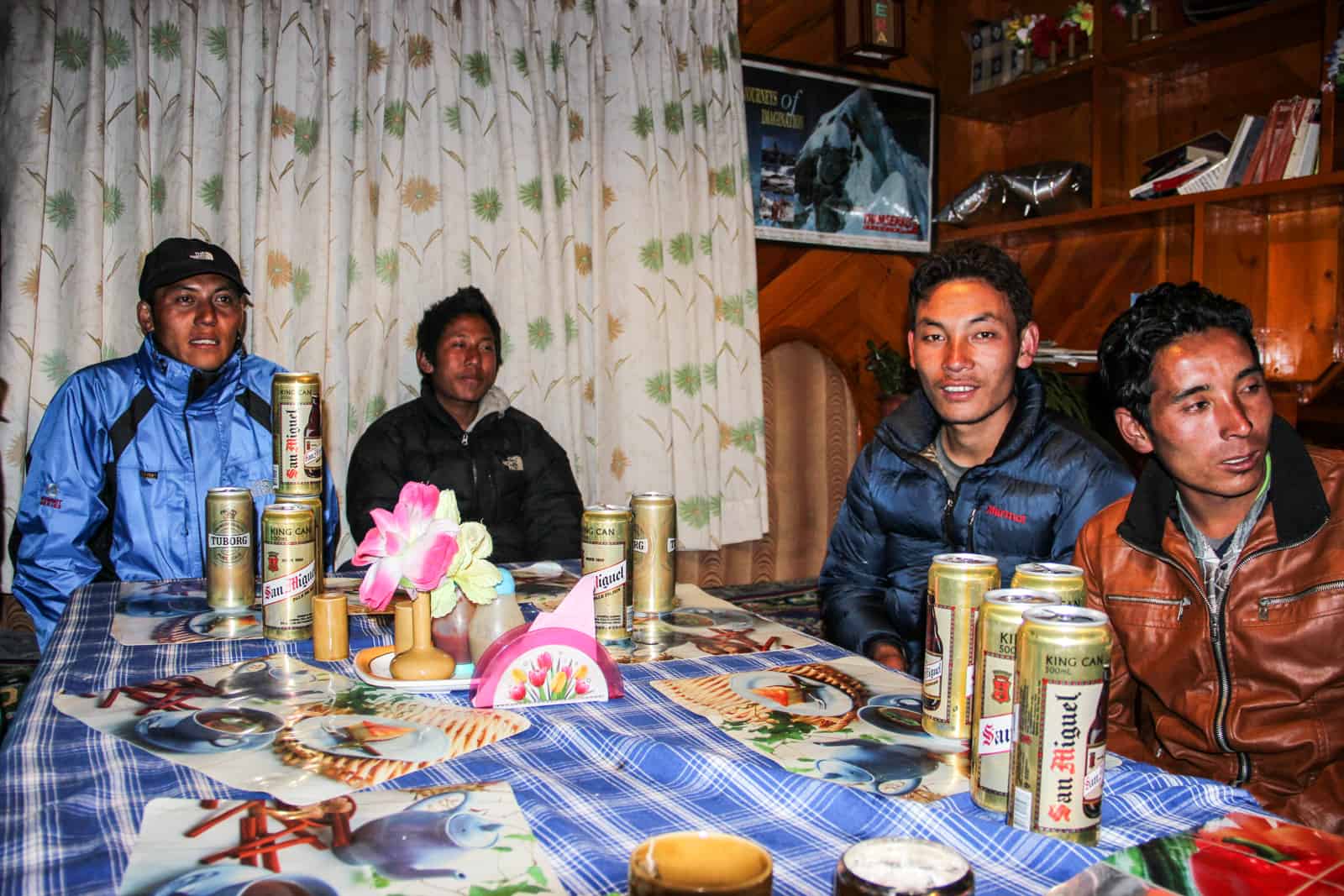
Much deserved beers for the porters
Top Tips to Complete the Trek to Everest Base Camp
Keep a Positive Mindset
The trek to Everest Base Camp is as much a test of mental agility as it is about physical strength. Despite feeling exhausted most of the time, look around you. Trekking with the magnificent High Himalayas around you, including Ama Dablam, Mount Pumori, Lhotse and Nuptse and the snow-capped misty peak of Mount Everest, you will feel as though you have been thrown into the most beautiful mountainous valley, with a 360 view of the best scenery on the planet.
Approach each climb, knowing that there’s a viewpoint so spectacular at the end that every excruciating last step is worth it. It really is.
Try to accept the uncomfortable nights in the teahouses, where your room will be made from plywood walls and the water will be ice-cold. It’s hard, and not a single night feels like a luxury. I hired a -20 sleeping bag from Kathmandu, used a silk sleeping liner, and wore as many layers as necessary. When I came across the opportunity for a hot shower, I took it, despite the cost of up to $5 for the privilege.
Do whatever it takes to make yourself feel better and try not to project too much negativity, as this can also harm the group’s morale. I found it easier to walk away from people who constantly needed to moan. Your mental stability is a crucial factor in getting you to the end goal!
Preventing Altitude Sickness on EBC?
Aversion to altitude can be severe and result in death, but in the majority of cases, it just makes you feel extremely sick. It’s something to carefully monitor and a core vital your guides will be keeping an eye on.
Drink plenty of water
It goes without saying that it is essential to drink 2-3 litres of water each day, yet it can often be easy to forget how frequently you’ve sipped. You will be told an ideal amount of water to consume daily according to how many kilometres and hours you are trekking.
To Diamox or not to Diamox?
At the time, I chose not to take Diamox tablets as I am a migraine sufferer, and I wanted to know if my body was on shut down during the trek.
I listened to all the advice our guide gave each day regarding how much water to drink – and I drank more to ensure I stayed on top of the altitude symptoms. But, two days before reaching base camp, I succumbed to altitude sickness. I woke up in the morning with throbbing headaches, which continued while trekking. I felt nauseous and weak, and mentally I struggled, and so I took the tablets for a couple of days.
The need for Diamox varies. On the Lost City Trek in Colombia, there were no huge climbs in altitude, so it wasn’t needed. When Climbing Kilimanjaro in Tanzania, I took half a Diamox tablet in the morning and evening throughout the entire trek. If I did Everest Base Camp again, I would most likely replicate this same controlled usage of AMS medication.
Daily health check-in
Every afternoon, when we reached the teahouse, we would check our heart rate and oxygen levels with a finger pulse oximeter. Logging our vitals was a part of our daily health monitoring regarding progress or deterioration.
Go Slow
Taking slow, measured steps during the trek to Everest Base Camp is as important as staying hydrated to prevent altitude sickness. This is not a race or an opportunity to show off your sporting prowess – even the most athletic can be beaten by altitude.
Go at your own pace, and don’t be intimidated by the strength of others or feel the need to ‘keep up’. It’s better to be an hour behind and reach your goal than falter at your ruthless determination.
Take Plenty of Snacks and Money
I took 35,000 rupees (approx. £275) with me for the entire trek and spent it all.
For Food at the EBC Teahouses
The short and honest story is that the food on the Everest Base Camp Trek is pretty dire, especially the higher you climb. You tire of the same foods, and the bland tastes and your loss of appetite only aids the pain. Take plenty of snacks, such as protein bars and chocolate, like Snickers – a little bit of sugar helps pull you through, as does your favourite comfort foods. Or indulge in a slice of cake from the highest bakery in the world at Lobuche, despite the hefty $8+ price tag!
Food and drink become more expensive the higher you go (due to the effort required to transport it up there), with bottled water, in particular, gaining a hefty price tag. Consider using water purification tablets or a water purification filter bottle like Water-to-Go to save money.

Teahouse food stop, typically halfway on the trekking route of that day
For Electricity, Showers and Wifi
Showers, access to the highest Wi-Fi connection in the world (which is sketchy at best), and battery recharging will set you back anywhere between 350-500 rupees / $5 to $10 or more. I had a local SIM card from Kathmandu, but the data only works for a few days since reception quickly fades, especially around the 4,000-metre level.
For Tipping the Porters and Guides
You will need to carry extra to tip the porters on the climb, as you will say goodbye to most of them in Lukla on the last morning. This is normally collected as a group tip that amounts to around $5 per day, per person – around $50-$60 altogether.
Keep this in a waterproof and protective pouch/wallet. We tipped our main guide at our final celebratory dinner in Kathmandu.
Bring US Dollars With You
It is advised to bring US Dollars with you into the country to exchange, as ATM fees in Kathmandu and Lukla are high, and often, the ATMs don’t always work. The last thing you want to do is withdraw money multiple times with multiple fees for a big trip like this. Bring this large sum of pocket money with you so you are ready to begin the trek with minimal stress and adequate supplies.
Preparing and Packing for Everest Base Camp Trekking
- Braving minus temperatures can be gruelling, especially at night. You can hire a four seasons sleeping bag (or simply ask for a -20) and a down jacket from a whole host of trekking shops in Kathmandu – these two items became my lifeline to a good night’s sleep.
- Good fitting and already broken-in trekking shoes. I bought my trekking shoes at home to wear them in before the adventure started and purchased walking poles in Kathmandu, which came in extra handy on the steeper parts of the climb.
- Walking Sticks. I don’t usually use walking poles on a long trek but for Everest Base Camp walking sticks were invaluable, especially on parts of the track where the soil was dusty and rocky and therefore more slippery.
- Do I need to bring enough toilet paper for the entire trek? No. There’s no need to pack a few toilet rolls, and it’s essential to save as much space as possible in your backpack. Bring one roll or a flat packet of soft tissues as a start, since toilet paper is easy to purchase along the way and not too expensive.
The rest is down to the art of layering:
- Thermal long-sleeved top and thermal leggings for when it gets colder at a higher altitude, and you can use them as a base layer.
- Comfortable trekking trousers. I had the ones with the zip-off leg compartment as the first and last days can see a bit of sun and warm temperatures. Don’t buy trekking pants that are too tight, as you will need space for layering, especially later into the trek.
- Three to four t-shirts and a fleece – the simple items for layering and easy removal.
- Gore-Tex and/or windproof jackets – for wind chill and an extra layer over your down jacket.
- Hat, scarf, and gloves. Insulated gloves. Remember, it’s better to be too warm than suffer the cold through lack of proper clothing.
- Underwear: Enough to last as there is no laundry service, nor will you be anywhere long enough to do laundry.
Packing Tips
- Practice packing before you leave to ensure you won’t be in a panic in the hotel room the night before.
- Don’t leave purchasing the most important gear until you get to Kathmandu. By this, I mean insulated items like thermals, a down jacket and comfortable hiking boots. Shopping in Kathmandu poses a risk – you have to sift through a lot of low-quality or fake gear, and these are things that are essential to try and test ahead of time.
- Practice carrying your daypack with you on the pre-hike warmups at home. That way, you will also train yourself to carry your clothing and other essentials and at least two litres of water on top!
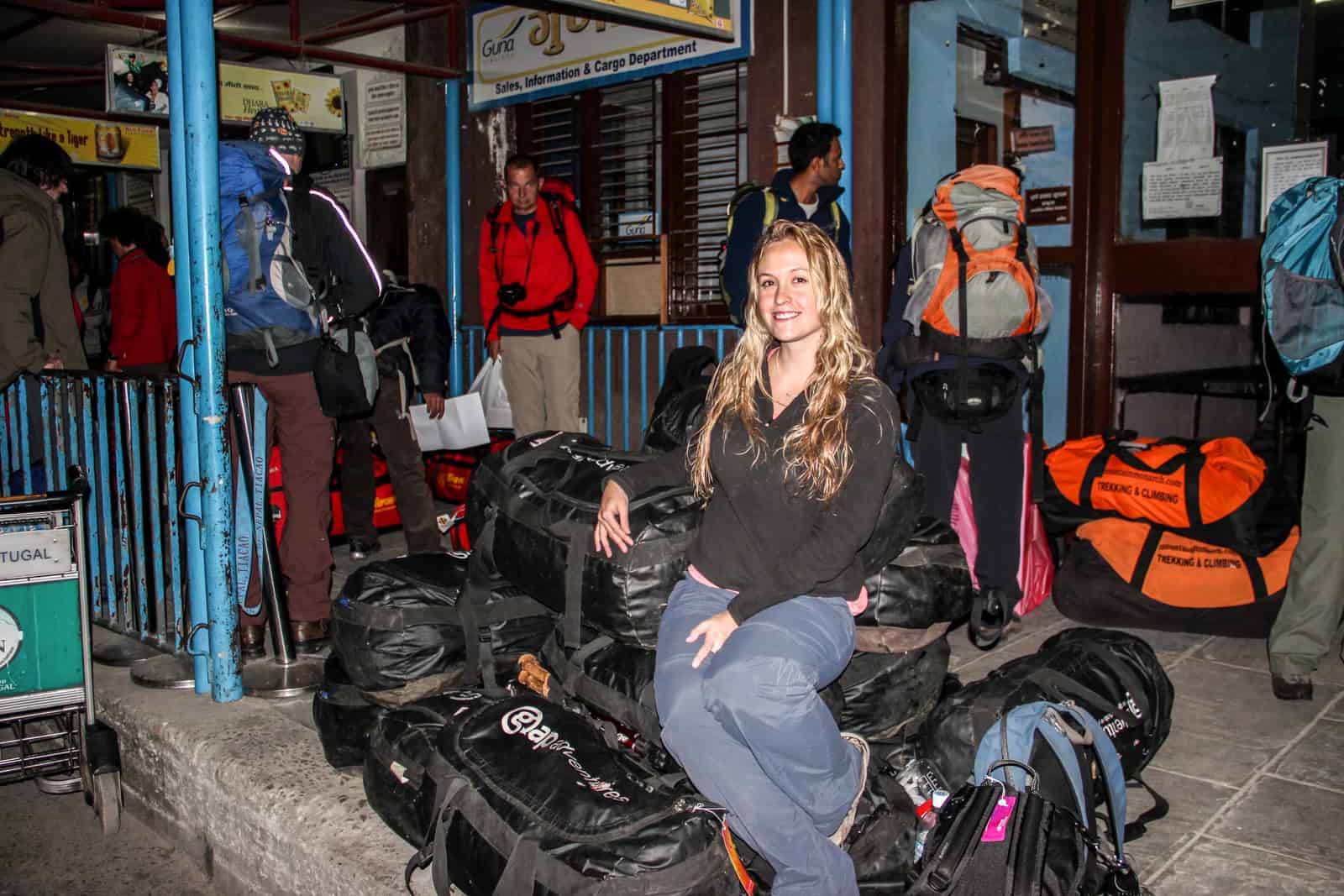
This is the bag the porters will carry during the Everest Base Camp trek.
What Travel Insurance to get for Everest Base Camp Trek
Getting travel insurance that includes trekking to a high altitude is crucial. More specifically, you must have a travel insurance policy that covers the usual, such as loss, damage, in-patient medical treatment and repatriation, but also includes mountain ascents and mountain rescue.
Check the fine print since many policies state a mountain pass limit, commonly “up to 2,500 metres” or “under 5,000m”. You may need a separate insurance policy or an activity/sports add-on that includes ‘trekking up to 6,000 metres.
For trekking EBC, you will need an insurance policy that covers:
- Treks up to the height of at least 6,000m.
- Mountain Rescue by Helicopter/helicopter evacuation.
Thinking About Trekking to Everest Base Camp? Do it!
Reaching Everest Base Camp isn’t just a light-hearted trek. It’s a mini-expedition that will test you in more ways than one.
But in that period of time, all of the pain completely disappears, leaving you to revel in what will become one of the greatest achievements of your life.
Between the pats on the back, the hugs and the handshakes of congratulations, you’ll lose yourself in complete silence as you marvel at the spectre before you – the top of the world. Not many people can say they stood over halfway towards that.
And if you don’t make it that far, you will still have traversed one of the most beautiful trekking routes on the planet.
Everest Base Camp Trek: Snapshot
Book yourself on a small adventure group to trek Nepal
- I booked the 15-day G Adventures Kathmandu to Base Camp small group tour, which includes the 12-day trek and time to explore Kathmandu either side. This cost includes the flight to Lukla, all accommodations and sherpas.
- Travel to and from Kathmandu at the start and end of the trip, and all food and drink costs during the trip are not included.
Trekking route:
- Way up: Kathmandu – Lukla – Phakding – Namche Bazaar – Tengboche – Dingboche – Lobuche – Gorak Shep.
- Way down: Pheriche – Kengjuma – Monjo – Lukla – Kathmandu
Budget:
- You should budget around £300 for food, drink and souvenirs on top of the trek cost.
Pack:
- Four Seasons sleeping bag, trekking boots, down jacket, windproof jacket, four t-shirts, one pair of trekking pants, thermal layers, a fleece and a hat, scarf and gloves
Constantly updated with the help of authorised tour guides on the ground, alongside access to regular tourism updates via tourism groups and businesses, it ensures that this article remains one of the most comprehensive on the web. Any plagiarism of this Everest Base Camp Trek blog or any of its descriptions used on other sites and blogs without attribution is not information authorised by myself for use. Know your source.

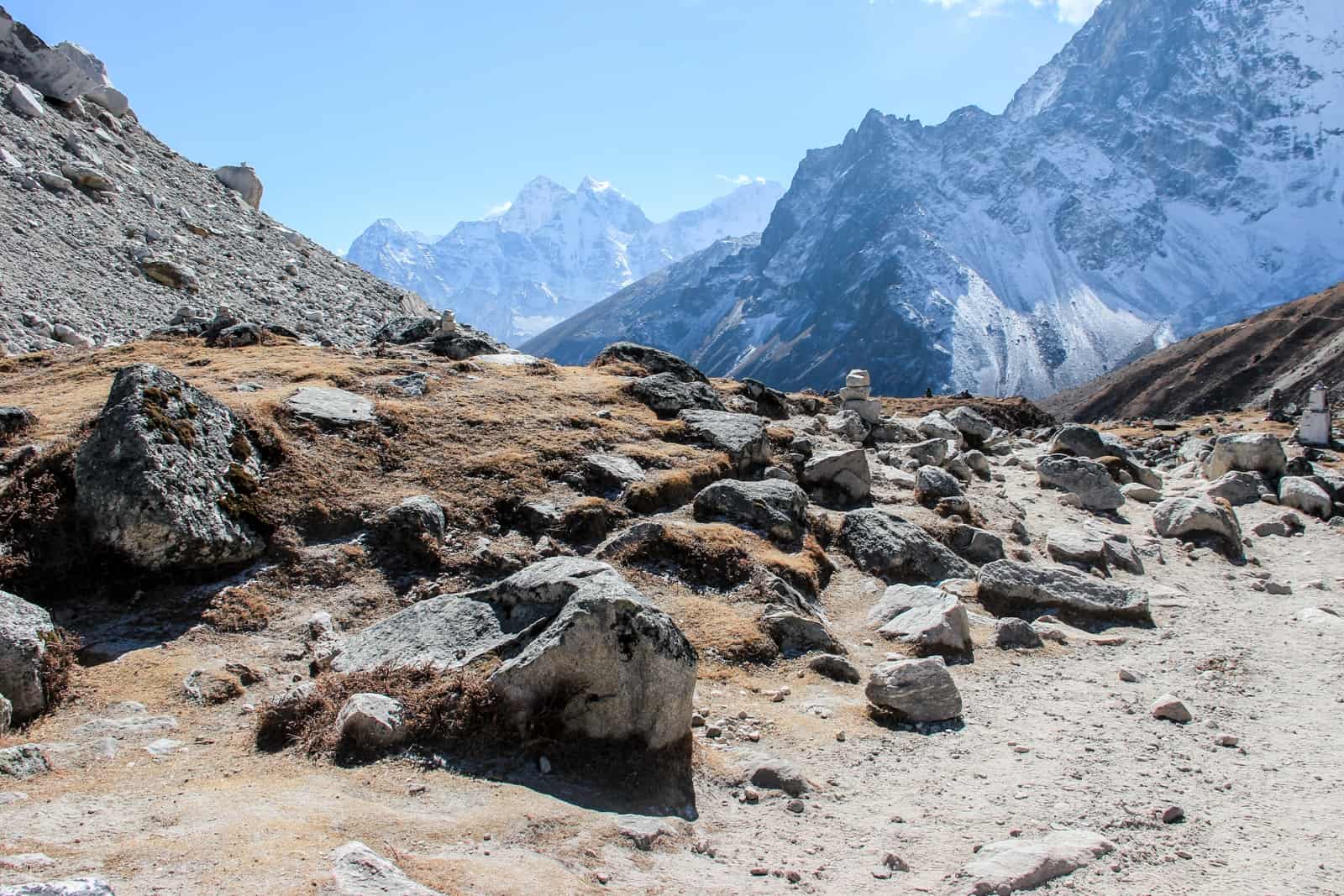
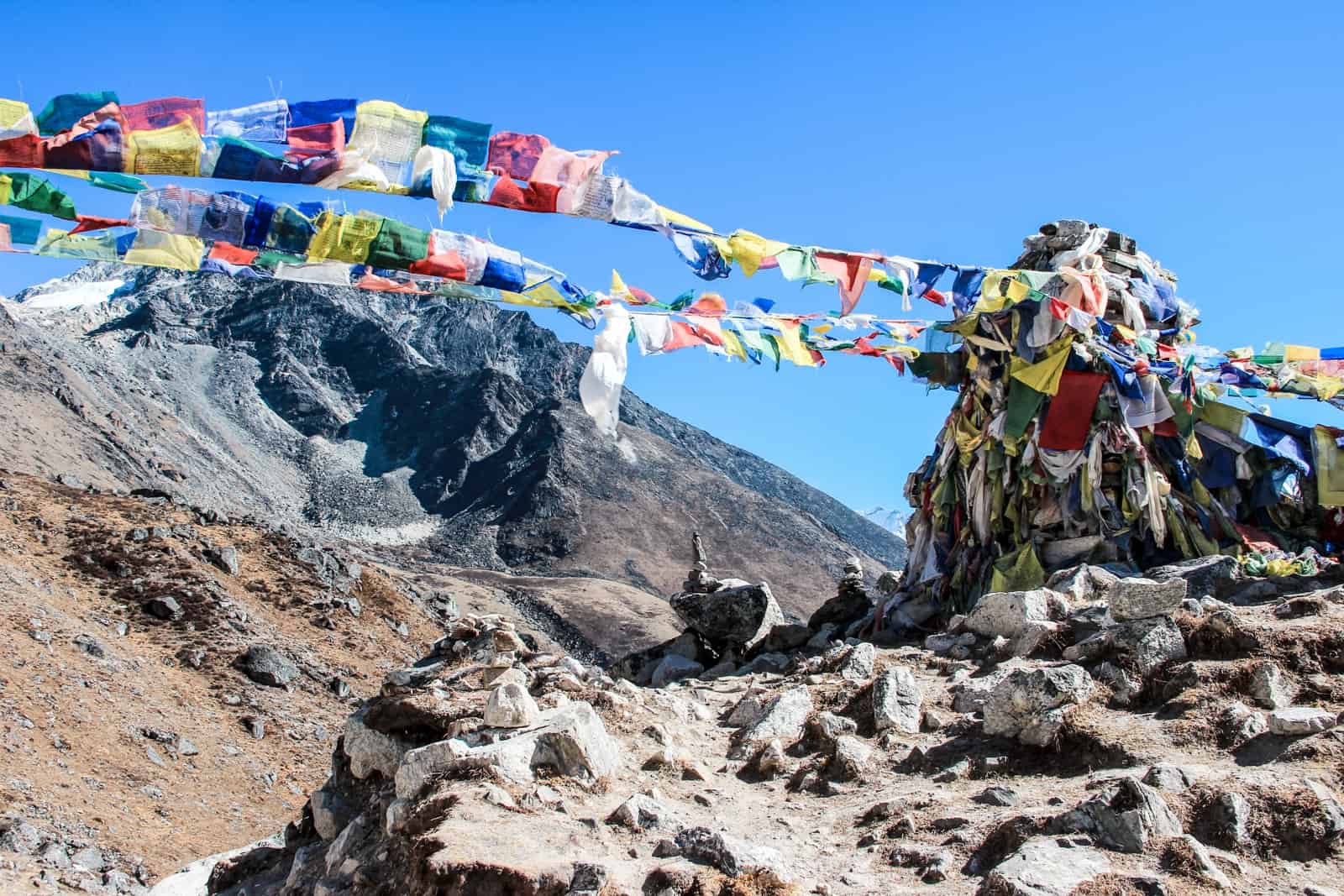
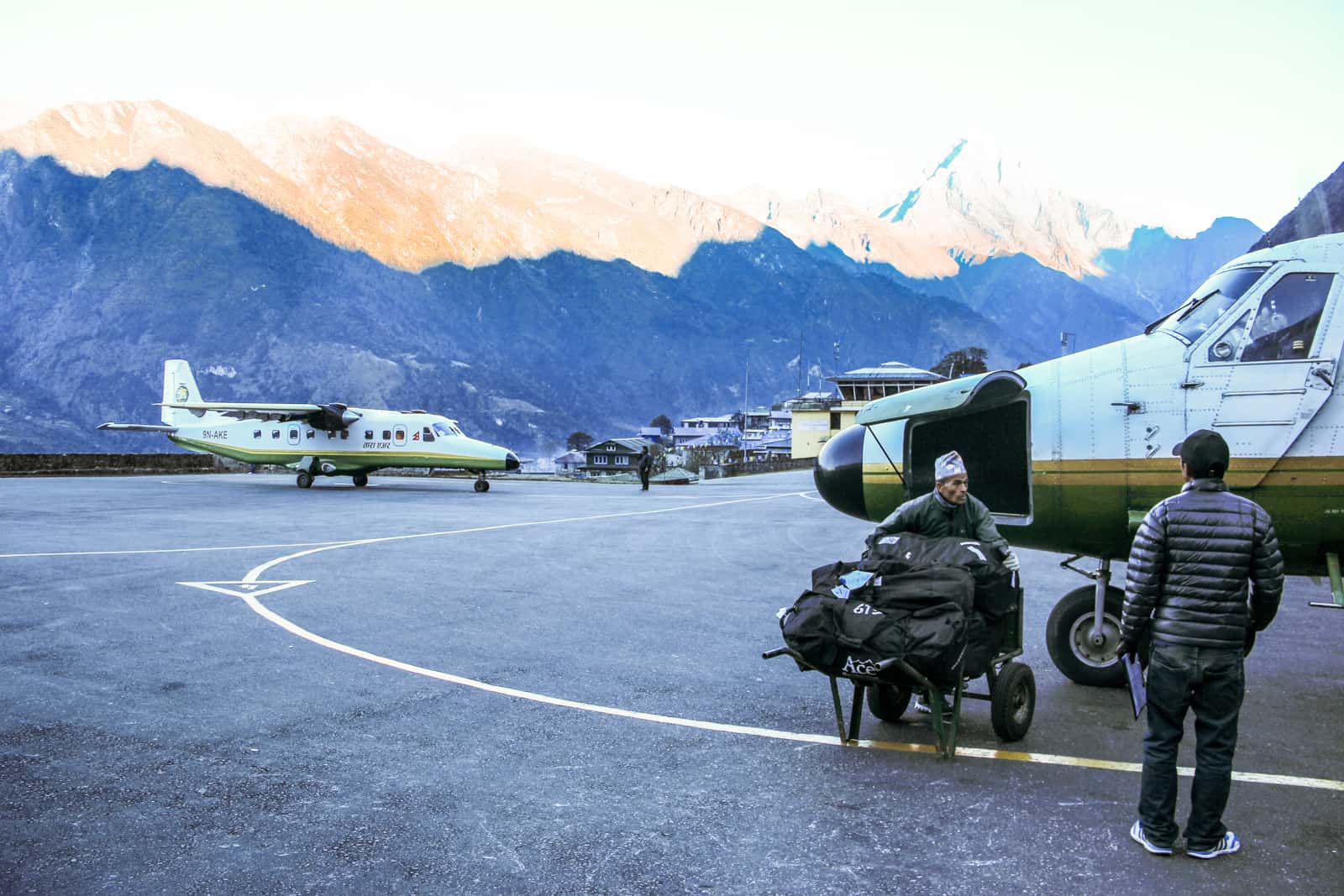
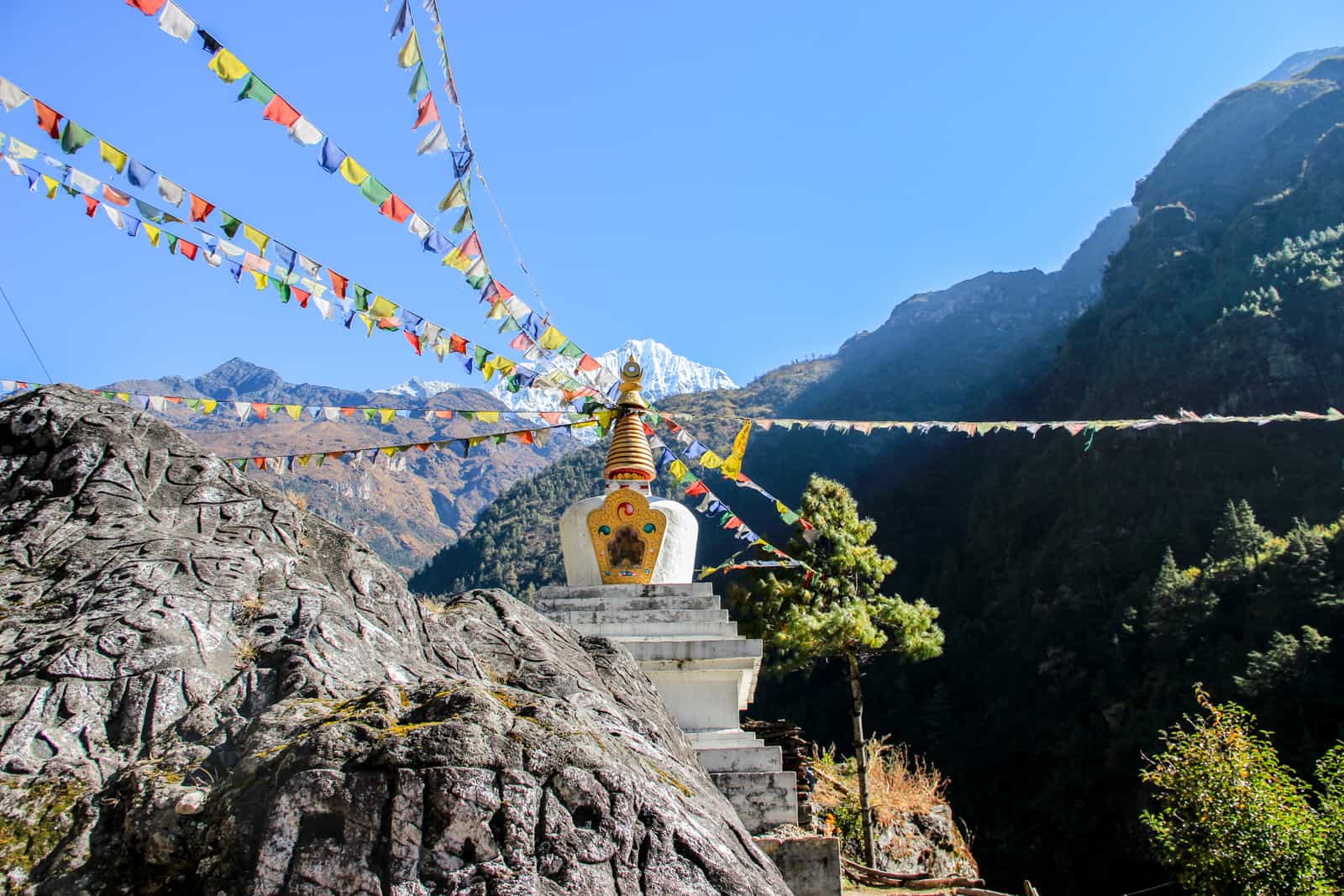

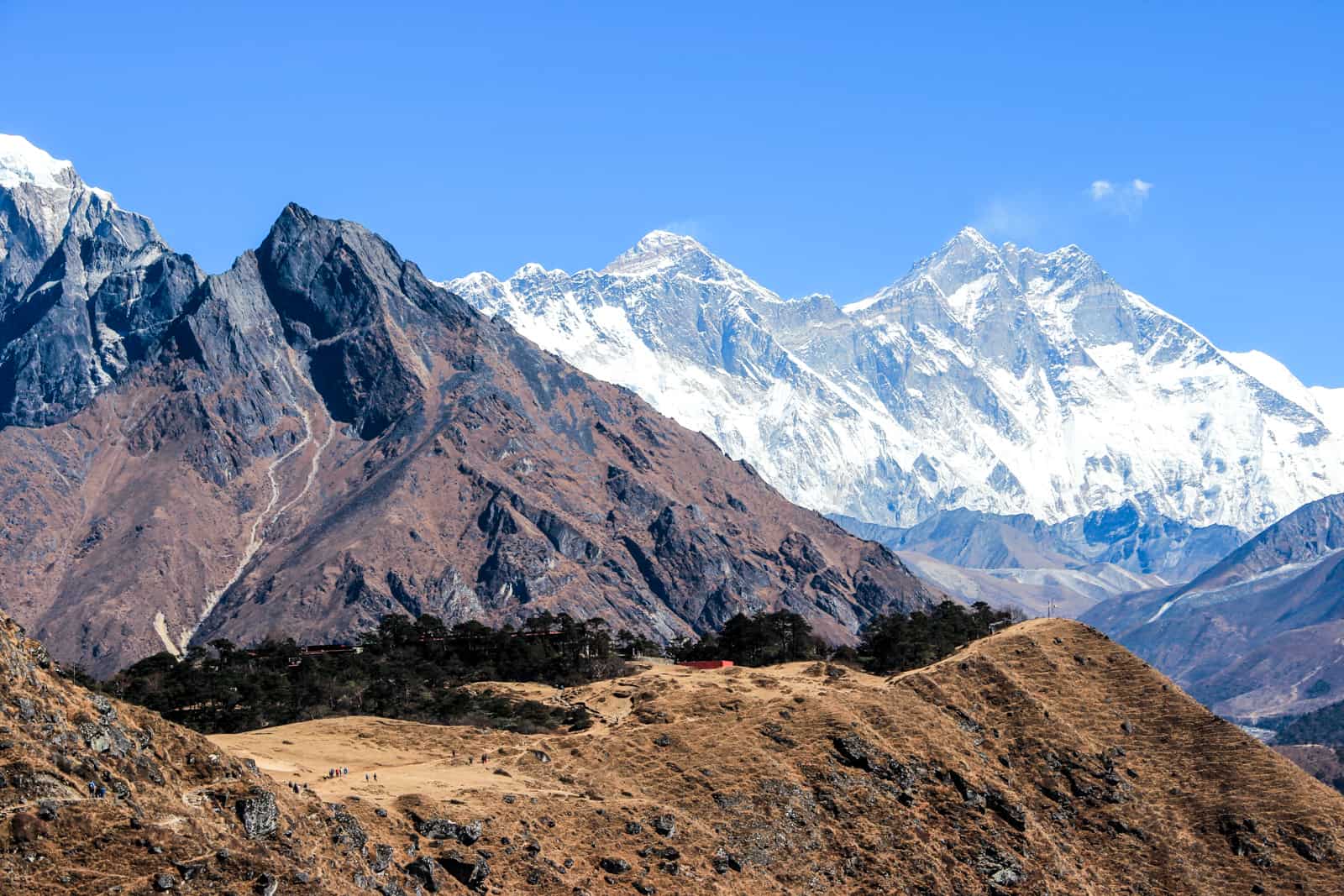
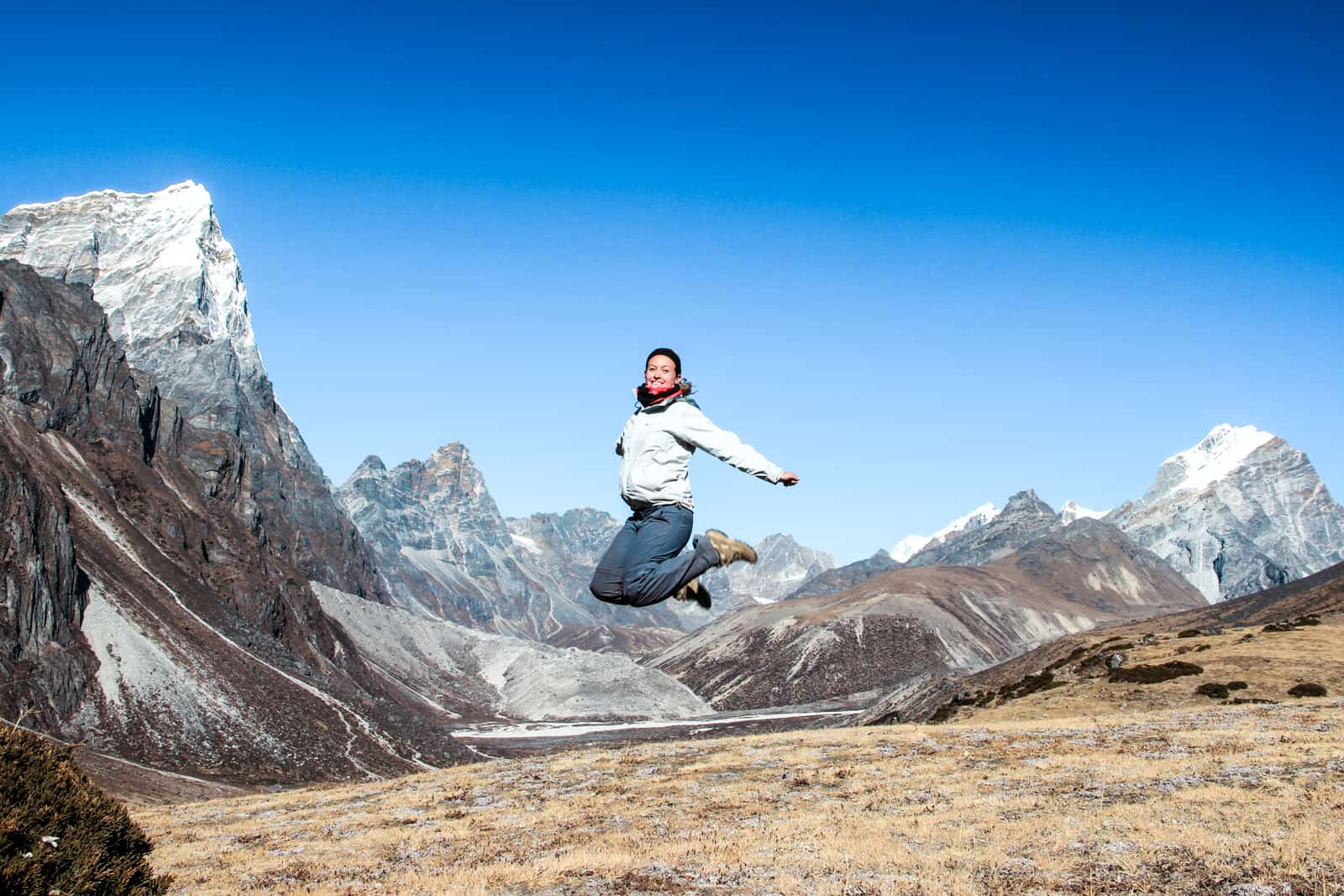
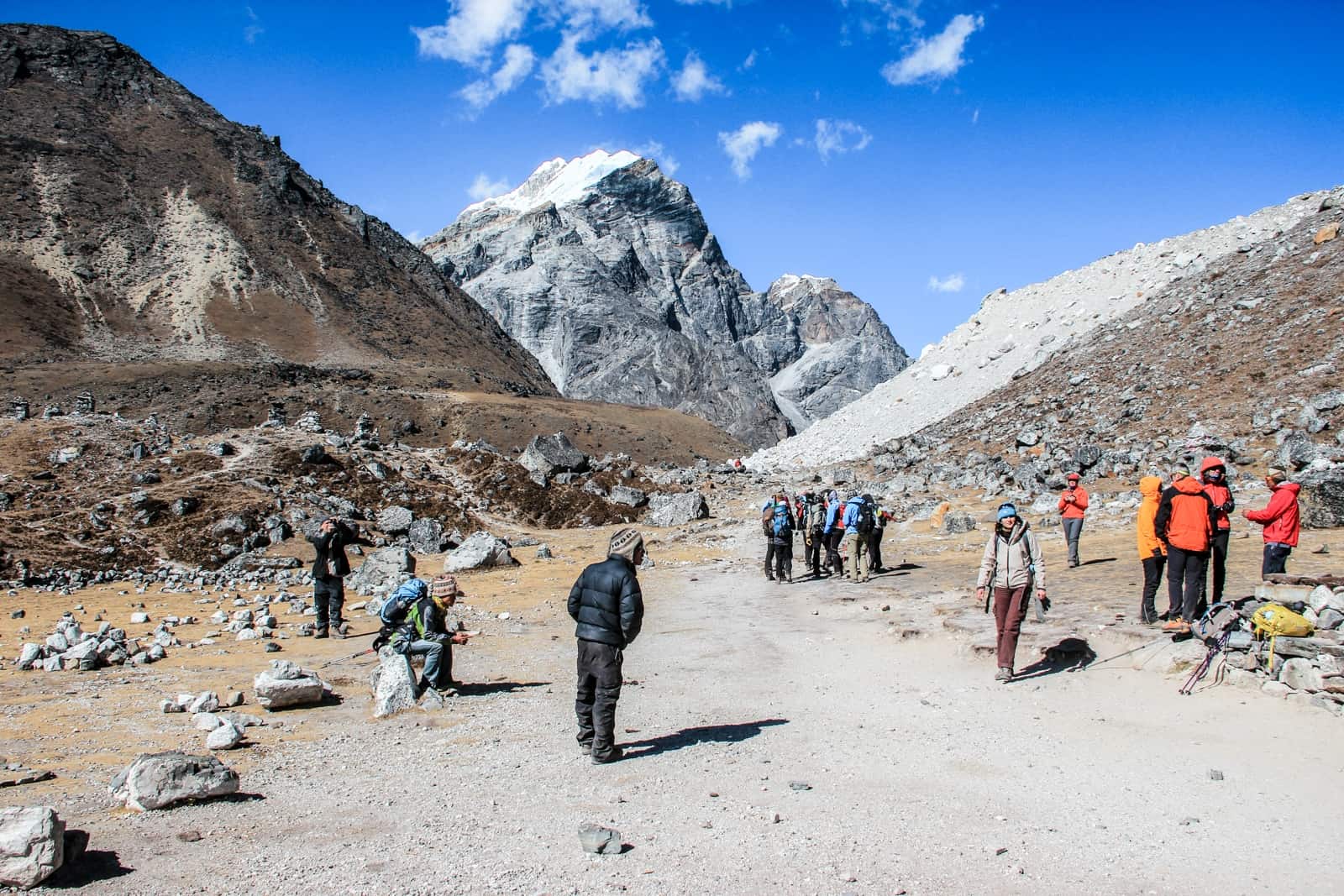
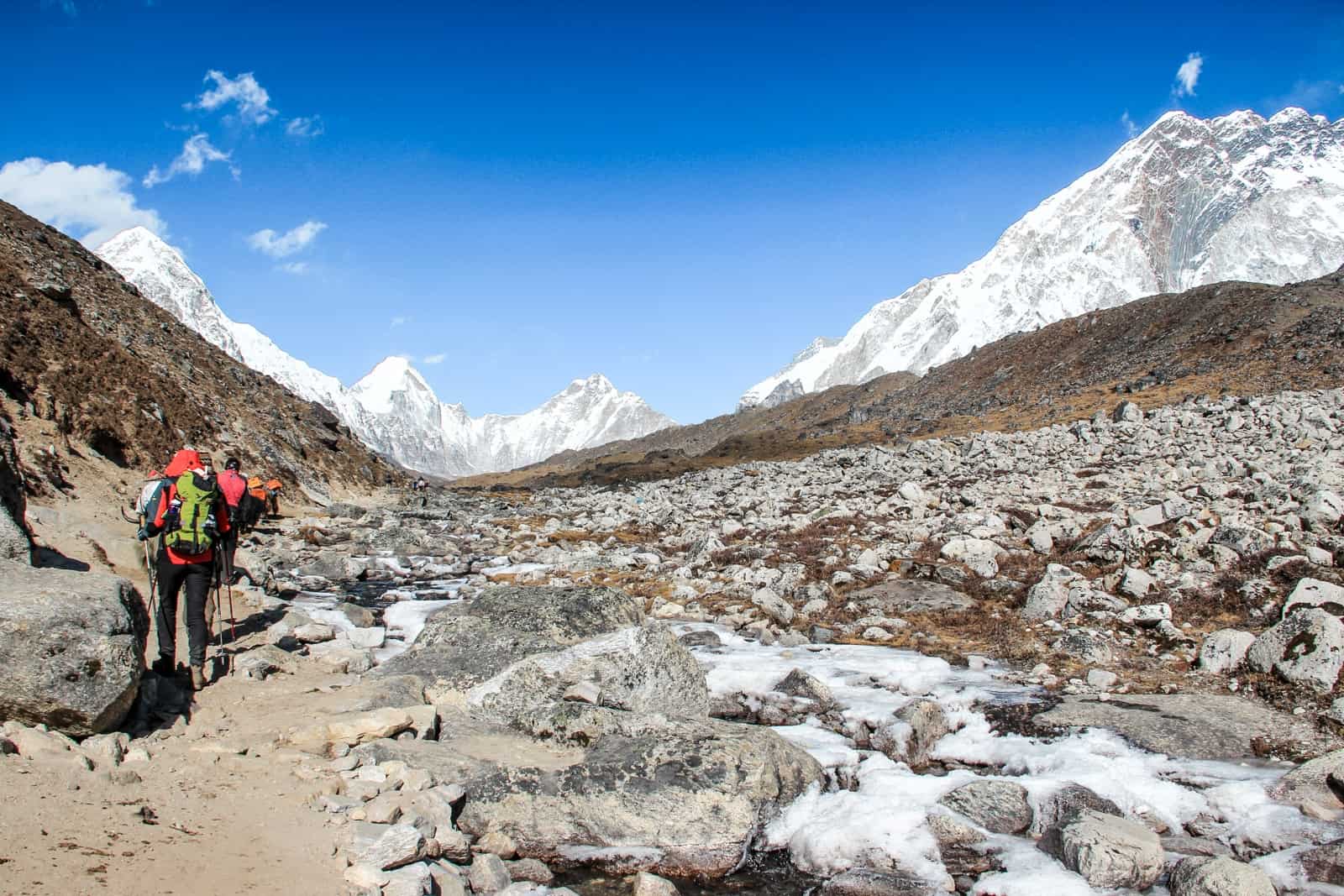
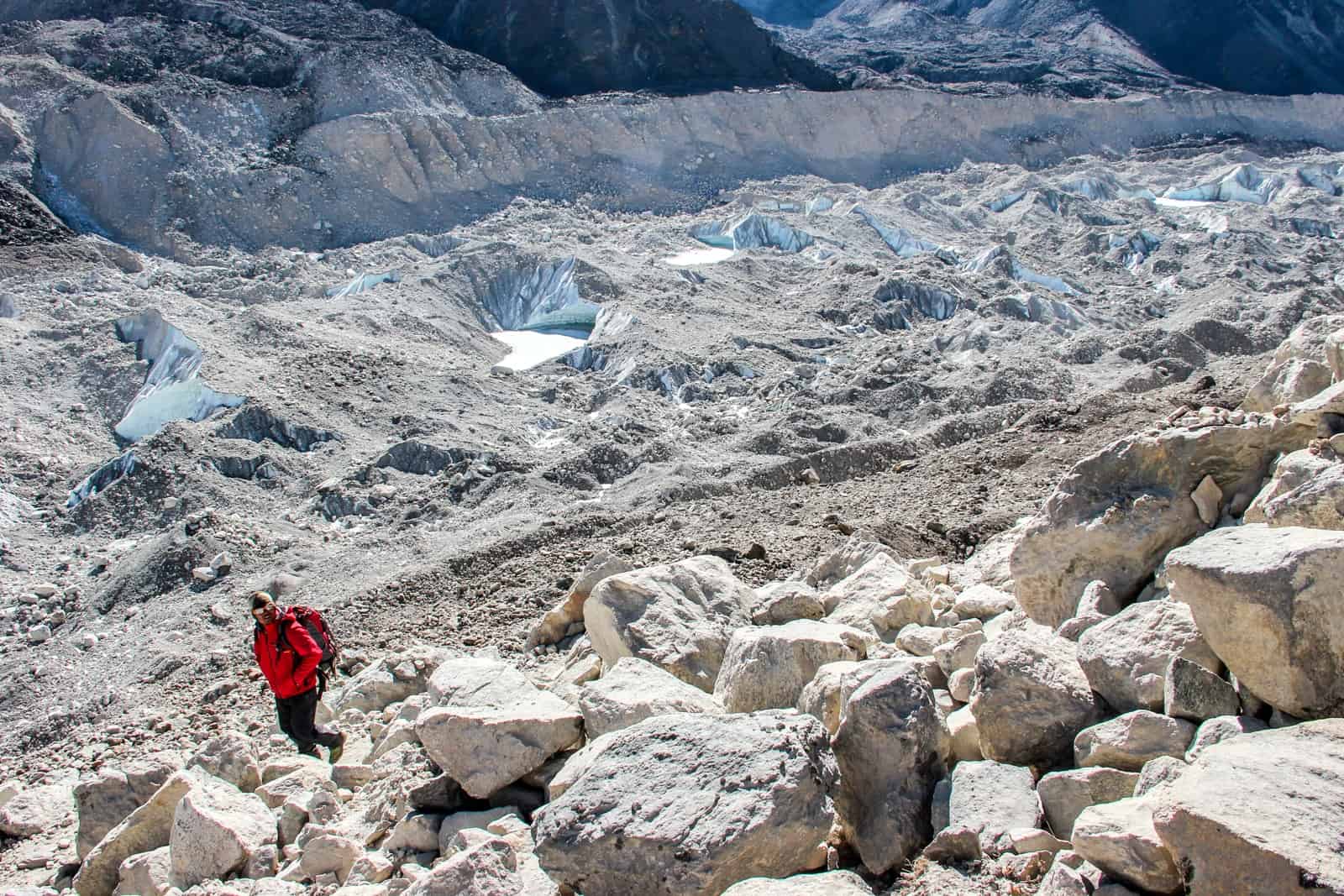
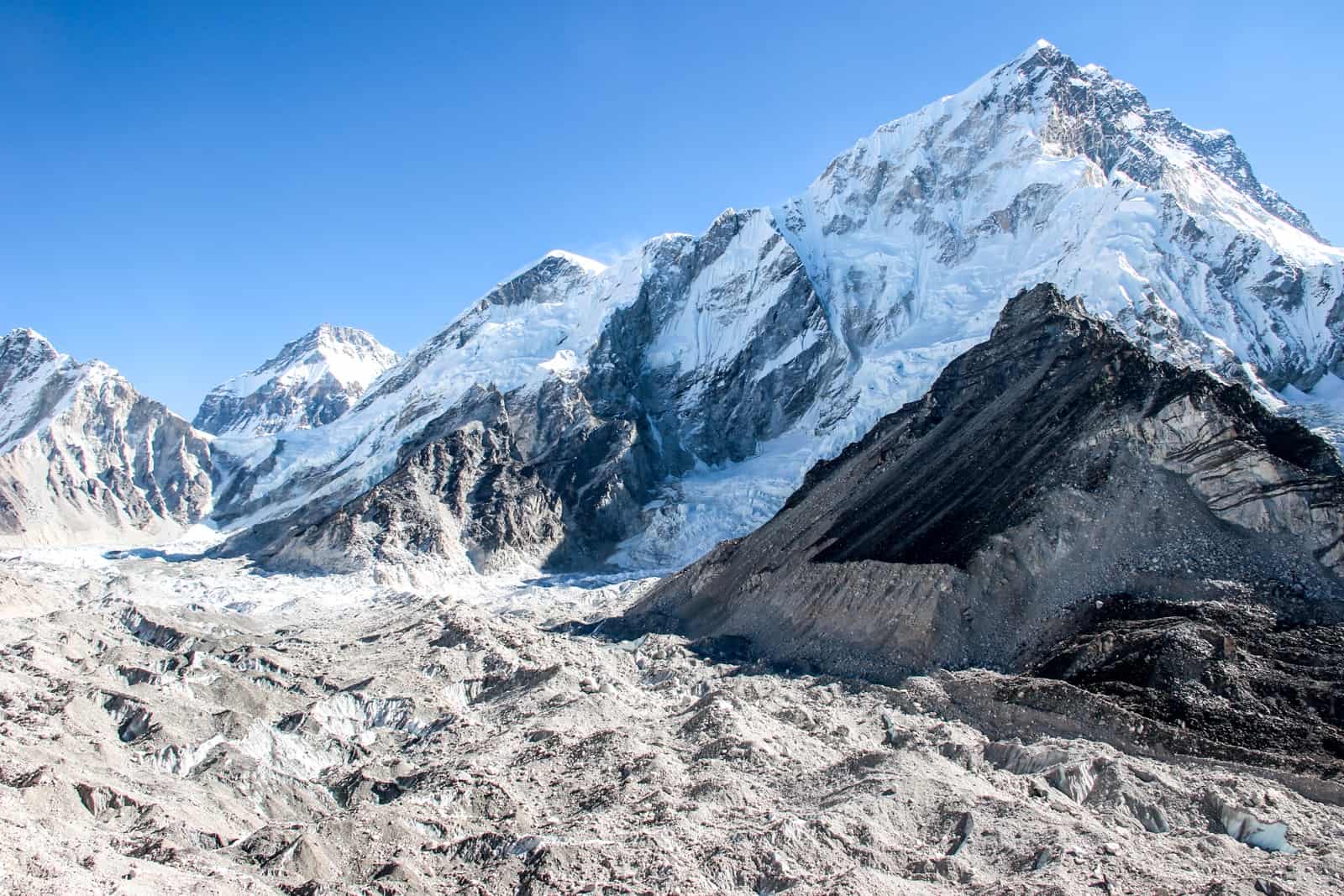
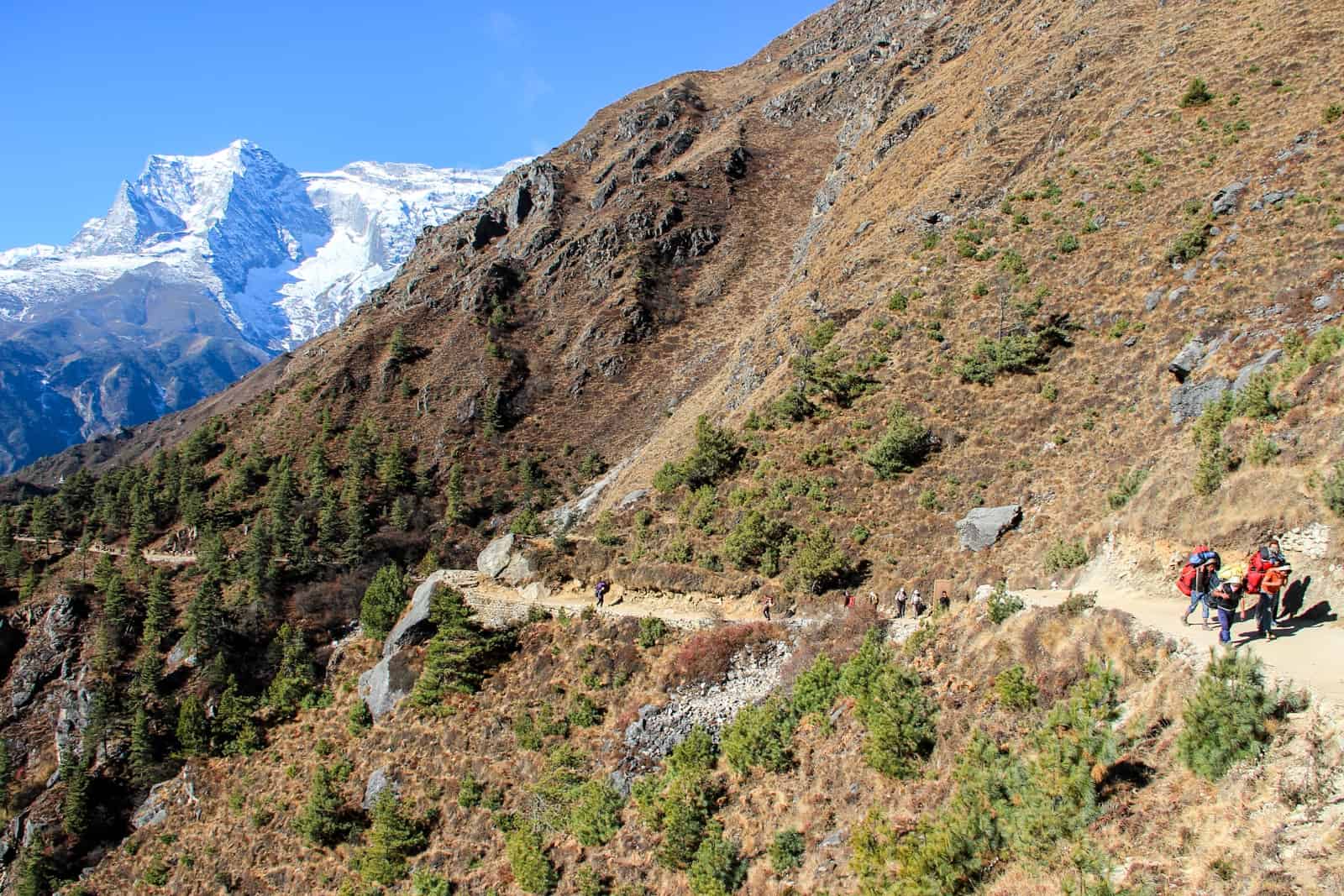
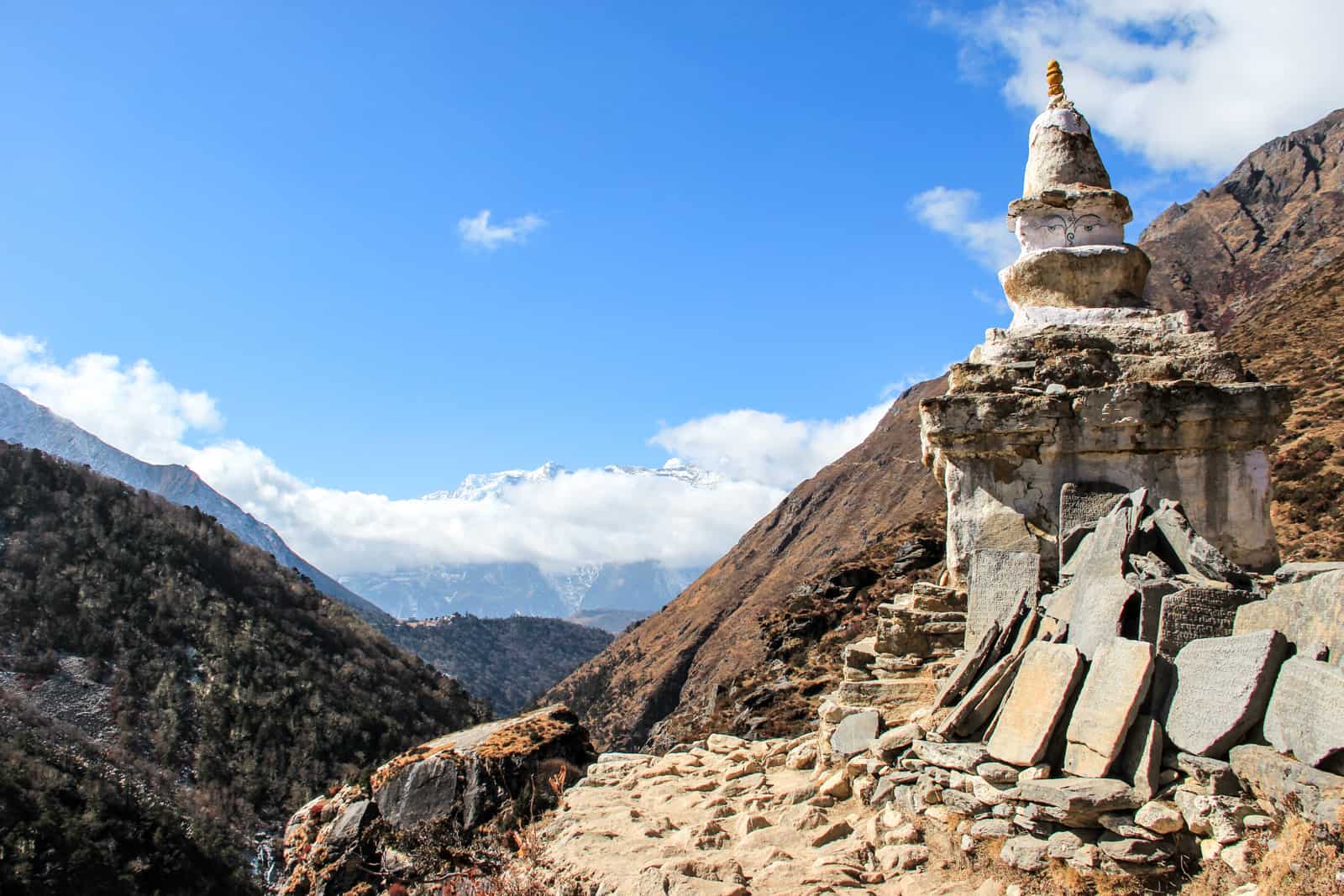
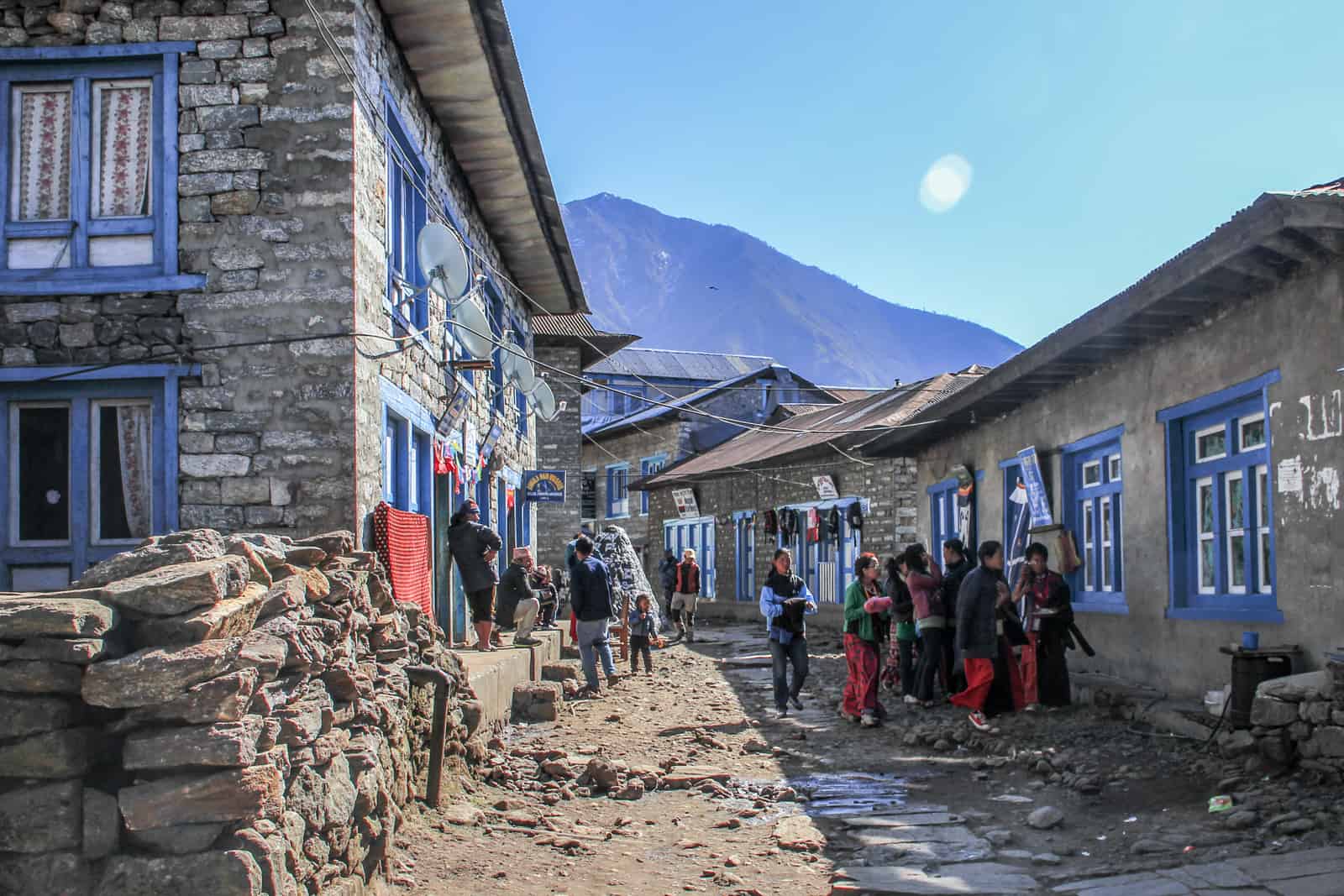
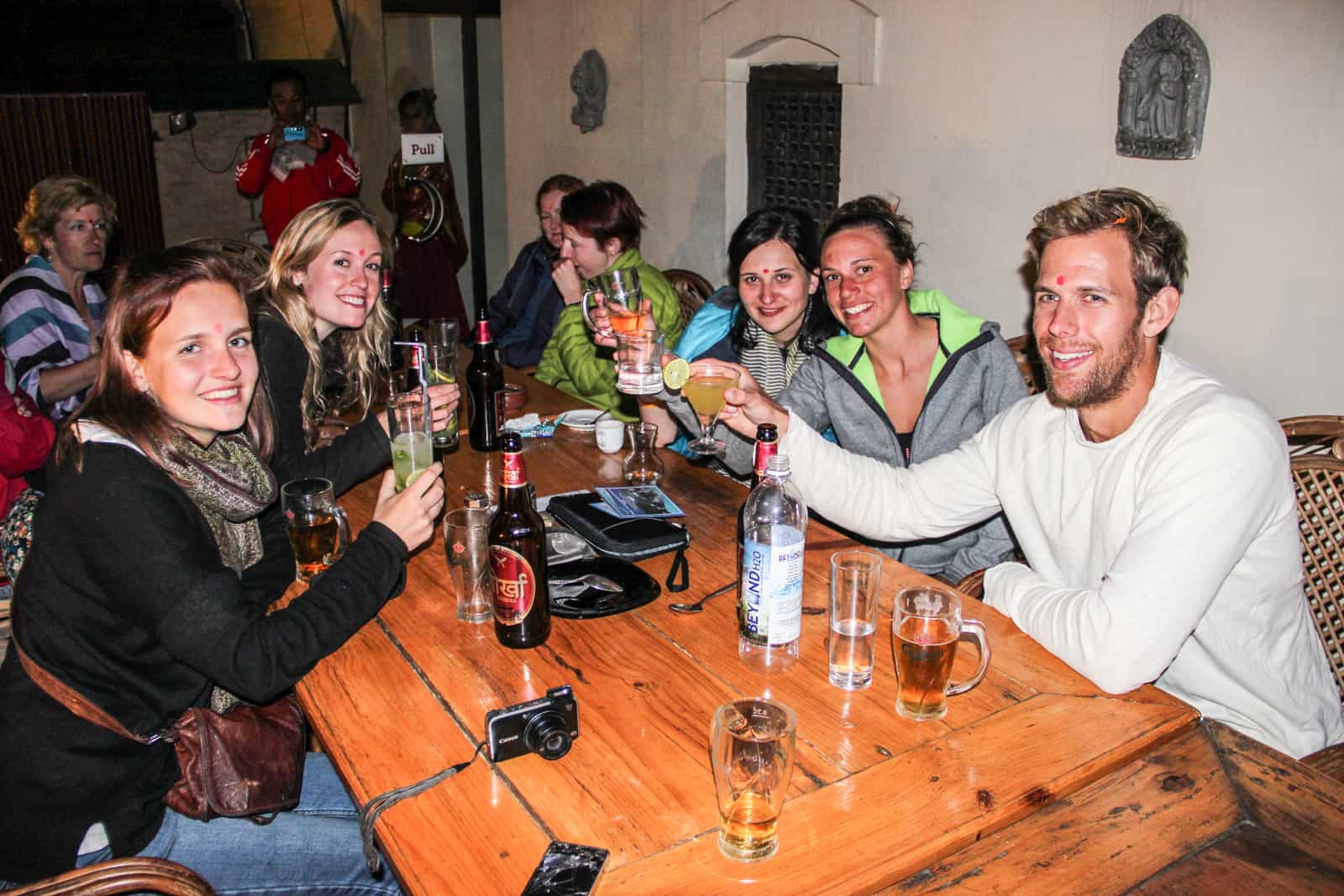

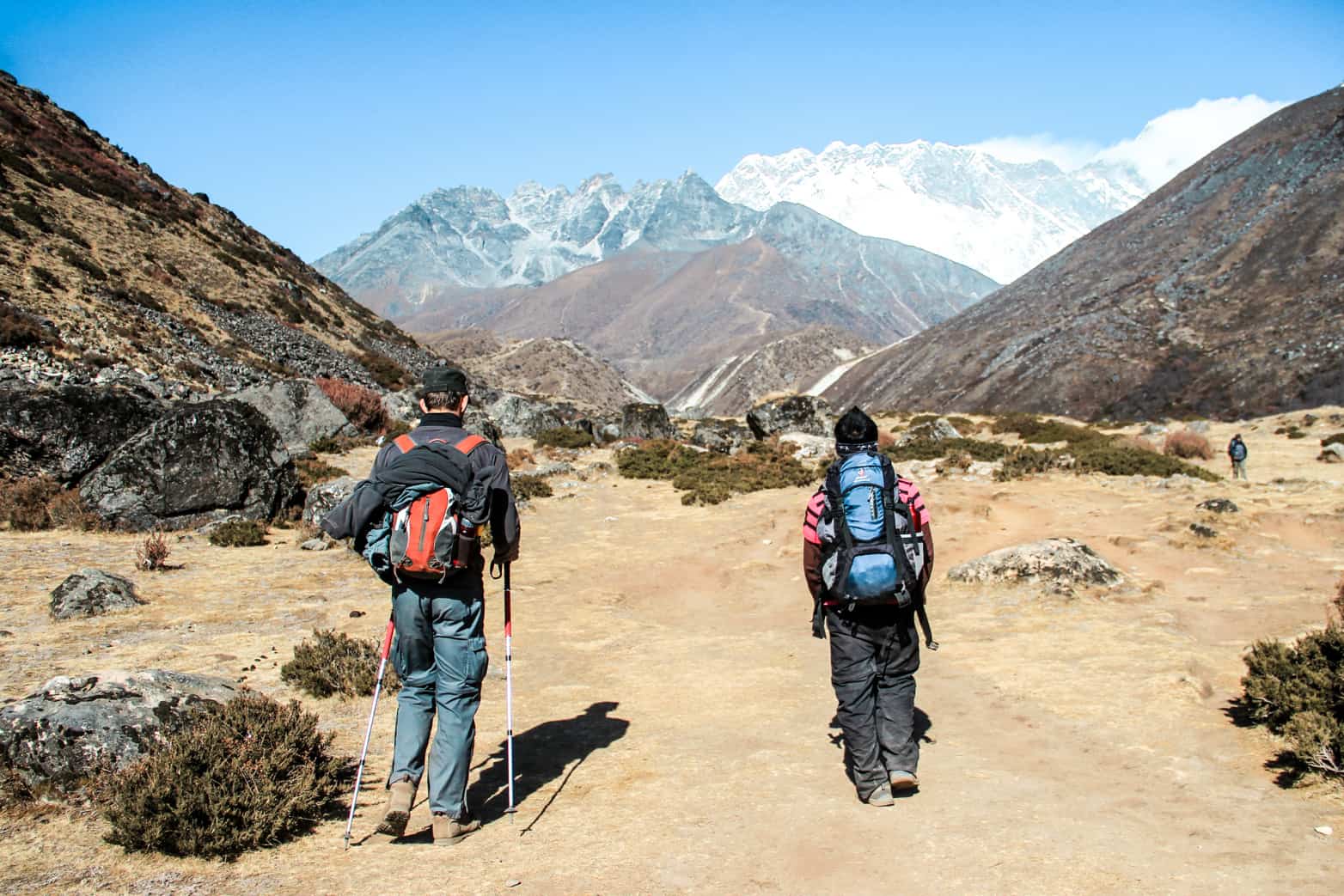
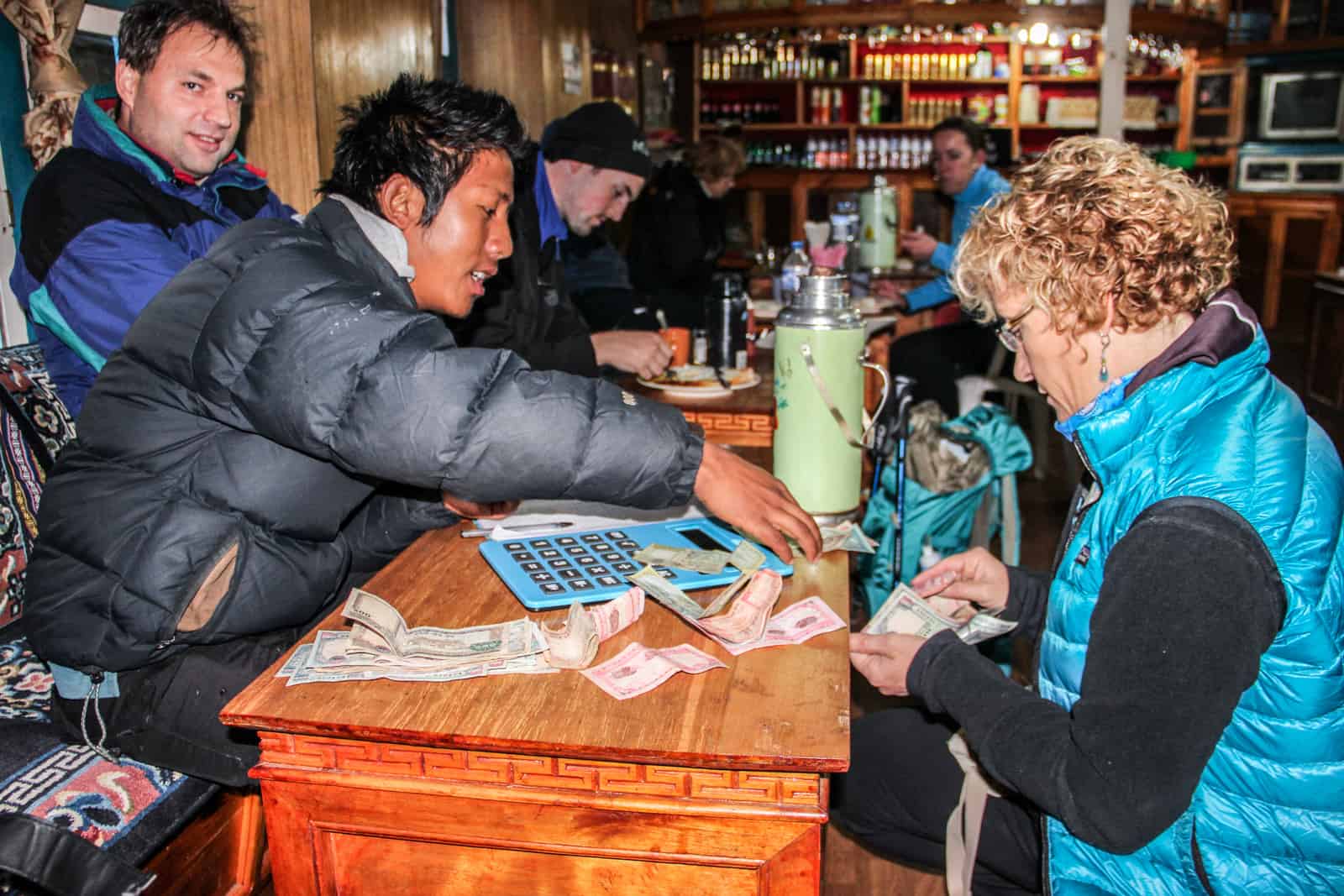
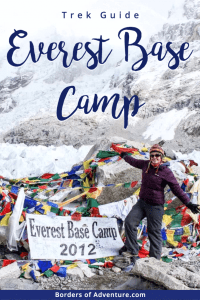
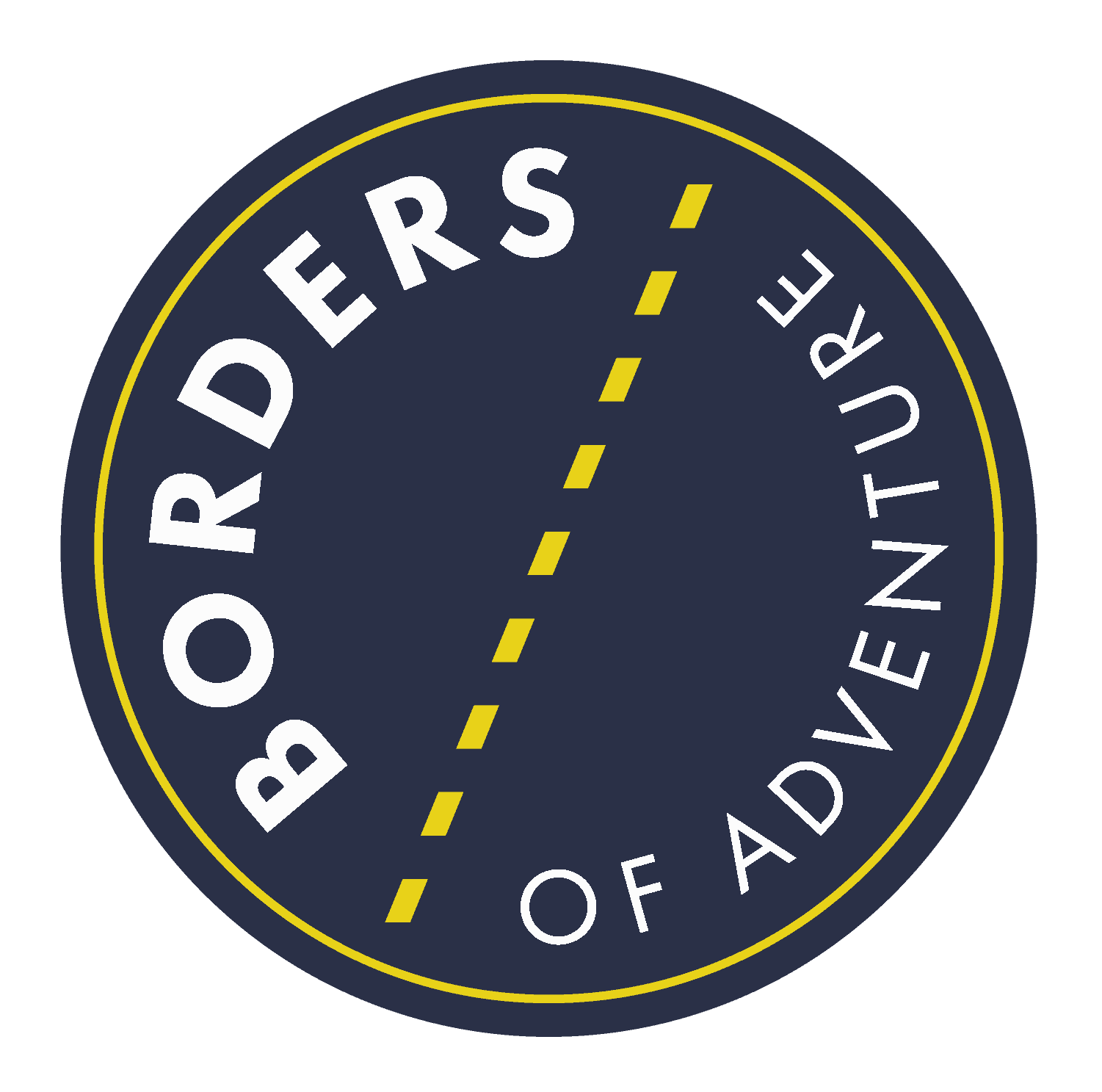
Jenisha says
Such an informative guide on the Everest Base Camp trek! Your tips on preparation, what to expect, and the daily itinerary are so helpful for anyone planning this iconic adventure. The personal insights and practical advice, especially regarding acclimatization and altitude sickness, are crucial for trekkers. The journey to Base Camp is truly life-changing, and your post gives a great overview of what to expect every step of the way. Can’t wait to embark on this trek myself!
Mel says
Hi!
Very informative, thank you.
I was wondering regarding money – if it best to take out the money prior for food on the trip, or to use card? What would you recommend?
And for charging facilities, if needed, would an adapter be needed?
How did you find the terrain coming down for the last four days of the trek?
Thanks!
Becki says
Take hard cash and an adaptor. You’ll be relatively off grid for the whole time, and mountain huts typically have basic facilities. The terrain coming down is the same as the terrain going up – you trek back on the same path 🙂
Antonio da Silva says
This article was not only very informative but also extremely well written. It kept me interested and excited to read more. Thank you! I can’t wait to take on this adventure. I have considered asking a close friend to come along (my wife is, unfortunately, not physically able and my children are still in the age of single digits) but lately I am pondering on doing it alone – I would still join a group expedition, of course, but with people I do not know. What are your thoughts regarding this? Would you recommend doing the trek with or without a friend or loved one?
Becki says
I joined a small solo and loved it. You gain instant camaraderie with other trekkers when you are all experiencing this once-in-a-lifetime trip.
Harrry Sharma says
This article is very helpful for those travelers who want to visit Everest Base Camp Trek Nepal. If travelers want to do a high-altitude trek in Nepal travelers know about what are the required preparations.
thanks for sharing this type of helpful information.
Jordan says
Great account of your journey to EBC!
Reading about your experiences in detail almost made me say ok been there next adventure. We (college son and I) head to Kathmandu next weekend. Starting to pack duffle to figure out what we are missing.
Long range forecast has many days of 50% chance of rain. Does anyone use boot gators? Not expecting snow to EBC but wondered if they might help if we are trekking though a lot of rain or if they are not used?
We have several days in Kathmandu ahead of the hike, any recommendations for that city? I have the trip advisor list but wondered if you have any opinions on that city. Thx.
Becki says
How exciting, Jordan. And do let me know about your experience after as people are also sharing here!
None of us had boot gators – it’s not an ultra-technical climb in that sense, where you need extra equipment. Just really good boots with great grip, layers and waterproof layers. Walking poles will be your best bet on more slippery terrain because of rain.
Kathmandu is one of my favourite cities in the world. My tips are to get out of Thamel and randomly explore. Just wander the streets, meet the locals, but masala chai from a local cafe (and contribute to local economy). Second, visit the outlying temples as they are totally worth the excursion and lastly, take days trips to Patan (Lalitpur) and Baktipur.
Sumuna Theeng says
Congratulation for your achievement and thanks for sharing your experiences. After reading your article, Everest Base Camp trekking needs lots of courage. This article is the best guide for them who are dreaming for Everest Base Camp trekking.
Elaine Barnes says
Hi Becki, I’ve been doing alot of research on various websites etc to prepare myself mentally for doing EBC trip via Gokyo Lakes this April (2019) Your write up has been the most informative by far and congratulations on your amazing achievement! Looking at the dates it’s been a few years ago and no doubt you’ve carried on with more adventures 🙂
I’m prepped on what to pack, read up on the altitude effects etc (not to be taken lightly I read!) However, silly as it seems, I’m also concerned about the loo situations (as previous readers have also stated) but within the tea houses not enroute. The basic loos don’t worry me, nor popping behind a rock! It’s the middle of the night scenario when it’s freezing cold, the loos may be occupied or a walk away from the room and you’re BUSTING!! I’m approaching 60 and my bladder isn’t as it was haha! How practical would it be to invest in some of those disposable portable bags/loo thingys that are around for camping/trekking/long car journeys etc? They profess to be environmentally friendly. Can you dispose of them at the tea houses ie do they provide bins for rubbish? Usually you flush the gel inside down a toilet and dispose of the bag, but there are no flushing toilets I believe. I’m not sure I want to be carrying a few bags of unnecessary weight if you get my drift!
I’m not sure if this thread is still active? But hope to get an answer from anyone!
Thankyou in anticipation.
Elaine
Becki says
Hi Elaine,
Many thanks for your kind words! The forum is always open and the post is always updated. There was always a toilet in the teahouses so there was no need to go outside during the night – just a few steps from the room. I have a weak bladder too so I understand the concern. If you feel better taking something extra then check out TravelJohn, which have a biodegradable pouch. I used to carry a couple on my travels when camping or for emergencies! There’s also rubbish disposal at the teahouses.
Good luck with your trek! Look forward to hearing about your experience!
Eugene says
Hi Becki. This is so informative, just what I was looking for. I am planning to do the EBC in November and am trying to gather as much info as possible. I am in my late 50’s but still run at least three times a week. Previously I did some trekking in the Dolomite’s and Chamonix, plus a via ferrata (very dangerous); so hoping that I will be okay with doing the EBC.
I will definitely take up your altitude acclimatization and dietary suggestions on board. Many thanks.
Becki says
Eugene – sounds like you are already prepared fitness wise and raring to go. There’s no via ferrata on EBC so you will be fine.
I wish you every success with your Everest Base Camp trek experience. Be sure to come back here and let me know how it went!
Anthony T says
Hi Becki,
Congratulations and thank you for sharing your experience with the rest of us. After reading this I am more than determined now to just go ahead and do it. Did you take any music with you? How did you access the internet? Is it advisable to listen to music while trekking or should you put 100% of your attention and focus on getting to your destination each day? Also, are there any toilets along the way? What happens when you are in the middle of a trek and feel the need to go? Did you do any altitude training, is it required?
Many thanks
Anthony
Becki says
Hi Anthony. Some people take along music on their phone, although this is also a battery drainer and most of us just talked to one another and enjoyed nature. One of our guides was also a singer, so we had a lot of fun with him learning Nepalese tunes. It’s up to you how you want to trek – with music or without – but you are in an incredible landscape and with new people, so there is plenty of distraction.
Learn to live without the internet for a few days – it’s limited and where you can get wifi, it is expensive.
Toilets are in the tea houses, and where trekking for hours where there are none, then the usual call of nature applies 😉 We are all human.
Altitude training is a personal choice. Trekking practice and prep is absolutely recommended, and altitude trek days (as mentioned in this article) are also factored in during the climb.
Good luck and enjoy!
Kevin Boylan says
I just returned (September 2016) from completing the Everest Base Camp trek and I will tell you that it was, unquestionably, one of the great adventures of my lifetime!! I first visited the area nearly 50 years ago when I was backpacking through India, Nepal and other parts of Asia. I thought at that time that I would like to trek in the Himalayas, but it took me all these years later to make it a reality. And I am so glad I did!! Whether doing it as a 25 year old or a 70+ year old, there are common experiences that all EBC trekkers shared. You will be physically challenged, cold, sleep deprived, suffer loss of appetite and endure gastro-intestinal issues. You will also meet some of the most remarkable people on the planet (Sherpas), see sweeping vistas and majestic mountains that few have been privileged to enjoy, and have an exquisite memory that will endure long after the discomfort has been forgotten!!
For those that have completed the journey……..congratulations. For those who are contemplating the trek…….you have the experience of a lifetime awaiting you.
Kevin
Becki says
Congratulations Kevin, and thank you for posting lovely words of encouragement for others!
Jackie says
Very interesting post! I’ll be heading to EBC coming November. Am from Malaysia, a tropical country (sunny/hot & rain throughout the year). Do you mind sharing the kind of clothing you brought along, ie fleece, down Jacket, etc? Sunglasses, gaiter essential?
Naga says
Congratulations Becki. I just read a travel report in The Gaurdian written by a lady to EBC who had to be picked by emergency heli after 2 nights stay at Namcha. Altitude sickness really matters. However your atticle bolsters me with positivity that it can be acheived.
Other day I researched about Mt. Kilimanjaro and today in EBC and I am hoping to do EBC first and definitely Kala Patar (5545 m) on way back after ECB (5364 m). Mt. Kili is higher at 5895 m and hope to do it later. On my Kenya trip in Dec 2014 I have been to Masai Mara and seen Mt Kenya at the equator in Nanyuki, it is amazing to see the lofty mountain peaks and the thrill to reach their summit would be amazing.
I am hoping to climb in exactly 2 months on Sep 11 the volcanic Mt. Ngauruhoe also known as Mt. Doom in The Lord of the Rings movie where Frodo drops the ring in the volcano. It will be beautiful one day hike, the best hike in New Zealand- Tongariro Alpne Crossing of nearly 16 km which I highly recommend if you have not done it. Later in November I am climbing Machu Pichu and the Huyana Pichu. I read about altitude sickness in Peru, Bolivia as the cities I am going are on high altitude (Cusco, Puno, La Paz over 3000 m) and am wondering what training I could take. I run regularly and did 21 to 25 km in 3 consecutive Sundays recently and I live 600m above sea level on a hill which is laughable comparing to the holl towns in Nepal. Would you recommend to stay in Nepal for a week before going on the trek? Any fitness training or breathing exercises?
Am hoping to do EBC trek on late Dec 2017 to coincide the new year day/my bday at the EBC. I have found the tour groups have option on those days. How was your experience in November, with the weather?
Thanks a lot for your inspiring article.
Cheers 🙂
Naga
Becki says
I absolutely recommend staying in Nepal – before and after the trek. It is a very beautiful country that deserves much more time beyond its breathtaking treks.You may also be tempted by Annapurna also 🙂 However, I do wanted to do another trek soon after but found that I couldn’t… it takes more out of you than you realise. Have it in mind, but don’t book anything after your body has recovered from EBC.
You can see by the November weather that conditions were not to hard, but pack sufficient layers and a good down jacket, and you will be prepared for all scenarios.
Good luck with your adventures!
Naga says
Thanks Becki. Definitely I will plan to spend some time before and after the trek to explore Nepal. Cheers 🙂
Ann says
I’m off on Friday week the 15th. Struggling with 10/5 kilo limit!
Good luck Dipali maybe we will pass on the trek. Biggest trek for me too ????
Dipali says
Hey me leaving on Thursday for EBC frm Mumbai.. just the right time i got to read ur experience Becki… truly motivating and i got a fair idea of what to expect.. Congrats Becki on ur achievement…all set for the biggest trek of my life..
Becki says
Best of luck to you!
Amanda says
Hi Becki,
I’ll be heading to EBC next year, but am just reading up now to get an idea of what to expect. Your article was very informative! What time of year did you go, if it wasn’t the April/May window? I’m wondering how your weather will compare to mine…
Thanks!
Becki says
I went in November!
Anna says
Hi, and thanks for the great info on your trek. I have a couple of questions relating to hydration and *toilets* (sorry!! Gotta ask though…) If you’re advised to drink lots of water for general hydration and AMS prevention, and given the treks are hours on end, how did everyone manage full bladders? I’ve heard some people are drinking 4-5 litres or more. Are there pit stops along the way? This will be my first trek ever, so my question may seem silly, but it’s genuine.
Becki says
Many tea houses along the way or… you go by the call of nature and find a bush! 🙂
Peter says
Hi Becki and for the readers. I was evacuated out of Namche on the way up, with pneumonia. I return for a second shot on 05MAY16. Learning points for me were to make sure you get your insurer to arrange the evacuation that way you will not get ripped off and they will pay the full cost. My insurer/s paid all evac and hospitalization costs anyway. In short form: take the Diamox two days prior and throughout. I took lots of risk reducing equipment and this is not needed. The Yaks were fine, there were no earthquakes, the sky did not fall on me, I didn’t fall off any suspension bridges, I didn’t get poisoned. I did not need my HF, VHF and UHF radios, walk-talkies and EPIRB. I did not need a change of clothing every day, pajamas, Ugg Boots, spare hiking boots, 3 cameras etc etc ad nauseum. You will get mobile coverage most of the way. You can buy everything super-cheap in-country. You do not need 14 kg on the Yak and another 14KG on your back. Minimal weight, as everyone is telling you is the way to go. My new backpack is less than 1 kg in weight, empty. THIS TIME I will take about 10kgs for the Yak and 4 kgs (including water) for my backpack. Day 3 to Namche is hard but certainly not unreasonable. Enjoy the walk and don’t take too many photos; you will miss the view. Unforgettable and will be even more so in MAY.
All the Best – Peter
Win says
Tnanks for all the great info, Becki. I leave for EBC March 9th from Dallas. I’m not a huge photography guy and I’m wondering about just taking my iPhone 6+. What do you think?
Becki says
That should be fine… just always remember to keep it warm. My iphone falters is colder temperatures more so than my DSLR. Worth carrying a battery pack too!
alka says
Hey Win! I am also from Dallas and a group of us did the EBC hike in Oct 2014. It was awesome! My husband carried his DSLR using a camera harness. That was very helpful. That said it is very much an additional weight to carry! iphone should be fine too. But it is an absolutely incredible experience.
Andrea says
Hi Becki,
I have thoroughly enjoyed reading. I’m off to EBC on Apr11, and I climbed Kili in Jan2014 with limited trekking experience (incredible–please go– I highly recommend the Lemosho route– less crowded until the higher camps–ample time to acclimate–breathtaking views!!). I took an inflatable sleeping pad to Kili which I never used. Can you comment on whether you’d recommend a sleeping pad for the tea houses? I’d love to lighten my load for EBC and allow more room for snacks (took very little for Kili– huge mistake!). I was in only decent shape for Kili and focused my training more on longer walks at a comfortable pace and hill workouts to get my body used to the long hours of being on my feet. I had mildly sore calves from the steeper sections, but otherwise physically, I was fine and mainly suffered from the cumulative exhaustion of only sleeping a few hours a night. I did take Diamox and plan to do so again (I drank 6-8L water a day which I believe made all the difference in the world). Were there any physical preparation activities or workouts that you wish you would have done more of?? One last question: I’m a shopper when I travel, and I love buying items to support the local economy as gifts to loved ones back home. I’ve read that the weight restrictions for luggage are pretty strict for the Lukla flights. Did you have any issues with this? I’m trying to figure out how to pack the essentials and yet leave room for items that I may purchase in Namche Bazaar. I’m thinking I may need to just plan on shopping in Kathmandu. Thanks for any advice!! Hope you’re still trekking 🙂
Becki says
I didn’t take a sleeping pad, no. They tea houses were pretty cosy, and more so when you take the full-on heavy duty sleeping bag.
I am not a huge diamox fan unless it is absolutely needed. We were advised not to take it from the very start, as it is important to listen to your body and let it adjust in it’s own time. EBC can be dangerous if you don’t keep aware of how your body is reaction, although the guides are 500% aware. It was my guide who advised me to take diamox approximately two days before we reached EBC, to ensure I could make it through.
I was luckily that I was on the road a while before EBC and did a LOT of trekking in China – hours long hikes ranging from steep steps to general climbs. If I had been at home, I would have certainly tried to do as many long and challening walks and hikes as possible to train my body for the strain. Nothing can prepare you for the mental test of a hike like this, but that is something you work on as it happens, and with the support of the group as a whole.
Our luggage restrictions were 10kg for the main bag the porters carried. I am sure you can fit a few gifts from Namche in there, as we did, before shopping in Kathmanndu. Most of the gifts are small and light – trinkets and such.
I wish you a grand adventure and the best of luck. Do come back here and tell me all about it and share with the group 🙂
Ann says
Hi Andrea
Good luck with EBC – I go on the 15 April Maybe we wil pass on your descent my assent!
Ann
Becki says
That would be cool if your paths crossed!
Andrea says
Good luck to you too!!! I’ll keep my eye out for ya 🙂
Ann says
Hi Becki
Thanks for a great honest post. I am off to EBC on April 15th,less than fours months time. Excited and a tad terified! Gym 5 mornings a week at the moment! Six after Christmas or walking with weighted pack on 6 day, depends on weather
Have you done Kili yet?
I did it a few years ago and am told that EBC is way harder
Adrian says
This was very informative. I am thinking about going next year and I have asthma too. Thankyou
Tina Wintour says
Hi Becki, I thoroughly enjoyed your EBC trek report. My husband wants us to do this with a small group from hiking club. They have climbed Mt Kili but we are novices. We are super fit, compete in Kokoda Challenge -96 km 2 years in a row and will compete next year. It is over difficult terrain and we have completed in 28.30 hrs and 30 hrs. It’s not fitness that worries me. But scared of dangerous looking high passes that I could get vertico and freeze and not be able to pass that point. Did you have any of these moments on the trek? From your account it is a very physical and mental drain due to altitude. So being fit is one thing being a bit of a coward can stop me from saying yes to this amazing adventure. I will turn 60 in Nov 2016 when we plan to go. I am really keen to get your answer.
Cheers Tina
Neal says
You really do NEED to be in top shape on this trek. It’s so much more comfortable when you’re very fit. Hike 5-10 miles 5 days a week, with a pack. Try to get some training at elevation too. All this will definitely aid you on your trek.
Peter says
Hi Becki, I’m going up in early NOV15 and thank you for the information – really helpful. I don’t travel ‘light’ and I have repacked about forty times. I have one pack for the porter of 11KG and one for me with 12KGs. I will probably lose 10 kg of this enroute so it will get lighter as I get higher and I intend to spread the weight ‘hurt’ between the Porter and me as we go. All are what I consider essentials and include survival stuff in case of earthquake/avalanche and getting separated (I’m the aviation safety guy so risk management is in my bones – unfortunately). Also a water filter, MIL SPEC mobile phone, lots of power banks etc. Ironically the Lukla bit doesn’t bother me, I have my 12kg in a 50L Osprey pack that is very comfortable. Did you see any other people carrying this weight themselves for the distance? Is this insane or reasonable? 10KG is not heavy at sea level but I suspect after 6 days of climbing stairs to the roof of the World things could be different! But what can a Bloke leave behind!!!!
Warm regards Peter
Becki says
Peter, while I commend your strength and packing skills (not to mention organisation) I do think you are slightly insane, yes 😉 We gave our porters a bag of around 10kg and carried a day bag with essentials – snacks, water, extra layers etc. The only people I saw carrying huge weight were the people without porters. My suggestion to you (in all seriousness)is to lose some of the extra baggage… it gets real tough up there the higher you climb. I wish you luck – a guy can always leave more behind 🙂
Graeme Cowan says
Good day Becki , firstly my compliments on an impressive account of your EBC trip and its successful conclusion . Couple of questions if you would be so kind ,..I am booked to go this November , 4 weeks time approx , my boots are a very lightweight Asolo creek which are more shower proof than completely waterproof but remarkably comfortable. Did you have to trek through deep snow / ice ? I am trying to determine wether these boots are suitable for those conditions so your input would be valued thanks . Lastly I understand it to be very cold at nights in tea houses , did you find you just kept on your kit that you had during day ?
Becki says
Hi Graeme. There wasn’t deep snow when I went but there were icy, light snow patches near to the end, so I would recommend waterproof covers for your shoes or investing in harder wearing hiking shoes where you can wear more layers.
The teahouses can get super cold, hence renting a VERY warm sleeping bag in Kathmandu. The higher you climb the less frequent the showers, or they cost more per usage. So yes, sometimes, you may find yourself unwilling to take off those warm layer for a day or three! I slept every night in my first couple of layers/outfit and QUICKLY changed in the mornings!
Good luck to you – it will be an experience of a lifetime! 🙂 Do check back in here and Let me know how it goes.
Ashish Sharma says
Hi Becky,
Thanks for sharing such an encouraging and detailed account of your EBC trek. I am sure this post must have inspired thousands, if not millions. I am lucky I read it and I too feel inspired to take this trek sometime next year. I always thought its either “The Summit” or nothing, thanks for breaking my notion that EBC also is something far more achievable and still rewarding.
However, I have few doubts and it would be great if you can help me clarify them.
1. How much does the overall trip cost? From Kathmandu to Kathmandu including all pre and post expenses related to this trip. For eg you would have bought/ rented footwear, heavy clothing, trekking equipment, medicines, rucksacks in advance may be. Just want to plan a budget and save accordingly.
2. Is this trip dangerous in any aspect? Actually my wife is little wary of this idea when I expressed her my desire to do this. Her main concerns are extreme temperature, difficult terrain and fear of natural disasters. Is that so? Sorry if I am sounding like a small boy but fact is I have never done any kind of trekking. I stay in a city where there is pleasant climate all year round so I don’t know what extreme temperatures are. I have a 9 to 9 job and a pretty mundane lifestyle. I am Ok Ok in terms of fitness. I do some bit of gym, treadmill, some weights for 30- 40 mins, 2- 3 times each week. I am 35 years and 5 kg overweight by the way.
3. I also have tendency to catch cold easily and that is something to worry too.
However, in light of what thrill you get after doing this and the magnificent sceneries, I am tempted to do this but I am a family man too and cannot risk my family’s future too. Don’t want to trek an expedition when family at home is constantly worrying and is not comfortable.
Hope you can understand and advise accordingly. Once again thanks for sharing such a detailed account with loads of practical advice.
Alex B says
Becky, do You think there’s certain age preference for such trip, trekking up to 5 000 meters ? Or it entirely depends on some ones health state?
Becki says
I wouldn’t say so. It’s about a good level of good fitness and if altitude will affect you. There was a guy in my group recovering from cancer and he made it and his friend (also in his late 60’s), didn’t. There is no general rule. Some of the world’s best explorers were/are at an age where one wouldn’t think it possible. 🙂
Alex B says
Thanks You for quick response) And what kind of particular fitness would You advice for such challenging trip to a person, living in Wisconsin?
Natasha says
Hi, I’m going to be doing the EBC trek next month with gadventures and I was wondering what kind of camera you took with you? I would really like to bring my DSLR; however, after reading your article I’m wondering whether it would be better to take a smaller camera instead due to the weight and bulkiness of the DSLR. Do you think it will be ok? What did other people bring when you went?
Becki says
I have a Canon 600d.. a fairly chunky SLR. However, there are now smaller cameras, especially the mirrorless range, which has the same high spec but are lighter to carry – something I am considering switching too myself. Other people on my trip had a mixture, SLR and simple handheld cameras. Depends if photography is your profession, hobby or whether you want average pictures for the memories. Only you can decide that. 🙂
John says
I debated on this as well. I really wanted to take my DSLR with a few lenses, but with the weight restrictions I decided to go mirror-less and take a Sony a6000 with a 16-70 lens and a Canon SX700HS P&S which zooms out to 750mm. I took that combo snowshoeing in Yellowstone as a trial and it worked pretty well. As Becki said though, it really comes down to a trade off of how nice of pictures you want/need vs how much stuff you are willing to carry. Check out the PeakDesign camera clip. It great for keeping your camera handy in front of you.
Kevin says
Sakari I disagree with you as well and agree with Becki…9 days is definitely not recommended by anyone to ascend almost 3000m in altitude. Infact, the medically safe guideline for ascending is 300m per day with 1 day acclimatization for every 1000m and even the 12 day program goes a bit faster than this.
Just because this worked out well for you does not mean it will work for the majority. Some people, such as yourself, are perhaps not only in top physical conditioning but also have the genetics to acclimatize very fast. Most people do not acclimatize well and are not athletes.
I personally saw a girl evacuated by helicopter at Dingboche despite taking Diamox. It was quite scary, AMS is not a joke.
Giving this type of advice to others is not a responsible thing to do as others may think it’s no big deal.
Becki says
Thank you Kevin. Great additional info.
Becki says
I went in November. It’s advisable to buy all your clothing outside of Kathmandu. A lot of it is fake and not the same high quality. Hot water is not available everywhere, no. When you do come across it after a few days you will certainly have to pay for it!
Brent says
Congratulations on reaching EBC! A friend and I are leaving from Canada in 4 days and can’t wait. The only thing that really concerns me ( altitude concerns me but I understand I can’t control that and just need to be smart and safe) is if my fitness level is going to torture me. I play rugby and soccer twice a week most of the year, but don’t do any other real physical activity. I’m not a gym rat and not a “runner”. I consider myself above average athletically but nothing too special. Do average joes make this trip??
Becki says
You are not an average Joe. You have a level of fitness beyond most others. I hope your trip was incredible!
Becki says
I disagree. For many people this will be their first big trek and it is a huge undertaking (for avid hardcore trekkers, not as much). Plus I know many people who have fallen seriously ill with the altitude. 10 days in total is not the recommended amount of time (professionally and medically) to do this trek and there is no way I would promote that, for safety reasons.
Kevin says
What a trove of information here 🙂 Thanks for sharing the details of your trip, it was really helpful at putting my mind somewhat at ease. I am an avid hiker but was not quite sure what to expect. I’ve hiked to 14,252 ft (4300 m) here (White Mountain Peak in Central California) and after 13,000 ft or so I was quite weak and it took everything I had to make the summit… however I did the entire 14 mile trek to the summit and back over a 6-7 hour period so no acclimatization. I am thinking EBC will feel much better as it’s much slower paced.
Last weekend I summitted Mt. Baldy here in Los Angeles at 10,064ft, 14 miles in about 7 hours or so with 4000 ft of elevation gain. I have really weak knees so at times it was brutal on my knees. Besides that I was somewhat fine but I
I do hike 5-6 miles every weekend but at sea level, the biggest wildcard for me is the extreme altitude and the impact of the uphill and downhill sections on my knees. How extreme are the inclines?
I am crossing my fingers that I will make it. If I do not then at least I tried my best 🙂 Did you also get to the top of Kala Pattar? Thanks again for sharing.
Becki says
You sound like a hiking pro already and I think you will be fine! Good luck, and I look forward to hearing all about it!
Kevin says
Hi, just got back from EBC and Kala Patthar and thought i’d post some feedback.
As I had posted earlier I am an avid hiker and consider myself fairly fit. However this trek kicked my butt!! It is NOWHERE near as easy as internet posts elsewhere make it out to be.
A culmination of factors make this trek a pretty tough exercise – extreme altitude, extreme cold and chilling wind, long days, glacial uneven terrain nearing EBC, steep inclines and declines.
I took Diamox when I reached 4000m in elevation and it was extremely effective, however it is very dehydrating and it’s difficult to consume lots of water when it’s freezing cold so that can be a little dangerous.
I did not find the Namche hill too bad, but the hike to Tengboche was tough with a 500m downhill descent to the river followed by a 800+m ascent on the other side!!
Another tip – I did Lobuche to Gorak Shep and immediately after did Kala Patthar as a mid-day hike, it’s much easier this way as the sun is up and the wind is milder. An early morning sunrise hike to Kala Patthar is more difficult and I have heard that the pictures with the sun in your camera is not great. Doing it mid-day resulted in some spectacular pictures from the summit as the sun was overhead.
I did EBC early morning next day and did not have to start at an absurdly early hour. After EBC I trekked back all the way to Periche which wasn’t too bad as it’s an easy downhill hike except for the killer hill near Dugkhla.
Congrats Becki for completing the trek and for sharing your experience which helped me be a bit more prepared.
Becki says
We only had the option of doing Kala Patthar early after EBC. I certainly was in no physical state to complete that. Not even the fittest guy on our trip was!
Huge congratulations Kevin, and thanks for posting about your experience and that parts you found challenging. Always insightful to hear other peoples’ stories.
Stuart says
…sounds amazing (and damn hard work!) Its high on the list of things to do – but before I get too excited about the possibility of setting off with my trusty boots I do have a question. I have a weak knee (ligament damage back in the 1990) – its never let me down yet on a hike – but will not take significant twisting. My main concern (not withstanding attitude!) is the terrain – lots of loose rubble surfaces or leaping over obstacles would be something I would be worried about. Any info on the terrain would be useful (I am aware you have no idea how much my knee will take and so cannot judge if the terrain is going to cause a problem – I am just trying to make a more informed decision – so any general comments would be useful). I will be ringing Gadventures for their view. All the best with all your travels…
Becki says
There is some loose rubble but not all the time. It’s more a mixture of up and down and steep climbs on grass, solid gravel and pathways. It’s very tough in parts for sure.
Krystinalovestotravel says
Great info! My husband and I just got back from Italy but I always need a travel adventure to look forward to! I love nature and would love to do this within the next couple of years. This has been very informative. 🙂
Nadia says
What a very interesting read that was. Congratulations. I wish it was something we’d done when we were younger. We are going to Nepal in a couple of months to celebrate my 60th birthday and have booked some short treks from Nagarok, where we will at least see Everest 🙂
Becki says
Forever young and adventurous. I hope the treks in Nepal ignite a desire to do EBC or ABC. Have a great time! 🙂
Joanne says
Hi there, thanks so much for the interesting read. My hubby and I are currently considering this trek and have no previous experience. I have no doubt the feeling of accomplishment is immense and it would be breathtaking to see Everest in person. My question is about the experience in the days leading up to base camp – what is it like – is it interesting scenery, is there lots to see or do? I know that sounds a bit daft, but my worry is that we will just be walking through bleak terraine to get to our goal and then coming back again. Did you find the whole experience to be a positive on?
Becki says
The scenery throughout in INCREDIBLE. I promise you that 🙂 Getting to EBC counts as one of my most treasured travel experiences, even if sometimes it was really tough!
alka nand says
Hi Becki,
Thanks for the informative and realistic account of yr trip to EBC. I am so impressed with your travels and hiking and so envious! We will be doing the trek this Sept/Oct with Unique Path Trekking. I had 2 concerns and would be eternally grateful if you could help me on them.
I am 53 years old and have been hiking for several years but of course nothing as crazy as this.
1. I feel realllyyy reallyy cold and we live in Dallas so don’t really have to face harsh winters. I was wondering what kind of jacket you used? I was planning on taking a 750-800 fill down jacket but they seems so light! I am not sure they will keep me warm even if I layer it with fleece and thermals underneath. Shd I go for a heavy ski jacket or will it be a hindrance while climbing?
2. We recently climbed a fourteener in Colorado and it was really tough but we did it without diamox. I have herad that Diamox is only effective if u take it a couple of days before the hike. You have mentioned that u took diamox at the higher altitudes. Was it still as effective? I would also rather try to do it without the diamox and take it only when necessary if that is as effective.
I am sure I will have more questions for you if you dont mind 😉
Thaaaanks!
alka
Becki says
Hi Alka,
I get really cold too. I had thermals, a t-shirt to layer, a fleece, down jacket and a wind-breaker/waterproof jacket. It’s best to layer up so you can layer down when you get too hot! Most of us used this system, and some had thicker wind-breaker jackets than others (which are kind of like ski-jackets). If you are really concerned, bring a down jacket AND a ski jacket. You can never be too sorry and on the last few days getting to EBC it is really cold! My ski jacket packs down pretty well.
Although remember you are warming up through trekking!
I never wanted to take Diamox. I think it is dangerous to mask what your body is trying to tell you. However, around three days before heading to EBC my migraines really kicked in and my guide told me that Diamox would be the best thing for me – just for those two days leading to EBC and for a couple of days after coming down. I was absolutely fine and it helped a lot. Plus the guides are VERY well trained to look out for you. Take it as pre-caution, just don’t fall foul to being addicted to it from the start like some people are.
Good luck and you know where I am if you have any other questions!
alka nand says
Great! Really appreciate the responses – Thanks!
Paddy Kirby says
Hi Becki,
My wife and I are doing EBC in November, your article was very informative I loved it, we are going to the gym three mornings a week and going for a 10-15 km hike on weekends so I hope we will be ok, I CANT WAIT to go.
Cheers Paddy
Becki says
Good luck, Paddy! I wish you both the best adventure of your life. Enjoy!
Ceri Williams says
Hi Becki,
I really enjoyed reading your account of your ascent to base-camp. This is something that I am thinking about undertaking in the next year or so, I was wondering if you could tell me what organization/company you used to book the expedition. There are quite a few and I’d like to ensure I pick one that is reputable. I’d be grateful if you could help.
Many thanks and good luck with the rest of your travels.
Ceri
Becki says
Hi Ceri. I used g Adventures! Good luck with the trek – it’s a true adventure! 🙂
Ceri Williams says
Great! Thanks you so much! 🙂
Gerda Kollmann says
Hi Becki
I was so excited to find your fabulous information. My daughter and I will be doing EBC in 3 weeks time. You have put my mind at rest about so many things. I was stressing that we hadn’t trained enough. I have climbed Kili twice, and didn’t have time to train for either climb. I managed fine. But my knees really took strain on the way down. This time I have been walking with strap on weights on my ankles and 10kg in a backpack 4 x a week. We are also fortunate that we live in Johannesburg, SouthAfrica which is 1600m above sea level. It looks like we will survive after all. Thank you for sharing your experiences.
Becki says
You’ve climbed Kili twice!!? I salute you! You will be absolutely fine and it seems like you are used to the experience. Have a fabulous time and i wish you every success.
Ian Bayne says
Hello Gerda,
I am thinking of taking my family in two years time. I would love to hear about your experience when you return. I also stay in Johannesburg.
Good luck!
Linda says
Hi Ian
We’re originally from Jhb, now living in Perth, Australia. Planning to do EBC trek in Nov 2016, as a fund raiser for charity. Our neighbour has done it 3 times and says Nov, is the best time.
good Luck
Becki, thanks for sharing!!
Linda
Eirik says
I just came back from basecamp and I must say that it was surprisingly easy. I did not in any way physically prepare myself , and I can honestly say that pretty much anyone can do it. I’d suggest you go with g-adventures if you want a good and professional agency. 🙂
Amber-Jane says
Hi Becki!
I am looking at booking with gecko adventures for this nov and just had some questions about backpacks and sleeping bags.
What size day pack (in litres) seemed suitable? And would you suggest hiring a good sleeping bag is the way to go rather than purchasing and taking over?
Thank you!! 🙂
Becki says
I normally carry a 10-15 litre daypack. Don’t take anything too large or overpack it, as you will be carrying this with you for the entire time! I hired a sleeping bag as its bulky and not something I wanted to carry with me before and after. Hiring is also more cost effective since a -20 is not something you are always going to use 🙂
John says
Wow. Only 10-15L for the daypack? Some people say they can get by fine with a ~15-20L daypack and some people say you need a 35L pack. Its interesting that there are sort of the two extremes. I’m going in April so I’m trying to sort this out. Thanks for the info
Laurel says
Your post makes me soooo excited, but also scared, as it looks like I’ll be doing this in just over a month – completely unplanned, but I am a regular hiker, so hoping that helps. I’m sure I’ll be contacting you with questions, but a very helpful/inspiring post. Thank you!
Becki says
Can’t wait to hear your story and your experience of this incredible hike! Just drop me a line with any questions, always happy to help a fellow adventurer 🙂
Chloe says
Hi Becki,
This is such a great insight into the trek, so thank you for that.
I just have a few concerns as i am booked to climb to base camp in April/May this year and i have recently been told that i have asthma. It scares me that i wont be able to make the climb.
I have inhalers and i am active. I have been training and trying to get fitter just to make it easier on my body and lungs. But it still concerns me as i would hate to not make it.
Can you please give me some tips on how you handled the amount of exertion, exercise, altitude, dust and the cold with your asthma.
Thank you in advance 🙂
Becki says
I’ve had asthma since I was 18 months old, so if I can do it… so can you!! I’ve always been active which has helped keep my asthma under control significantly.
I informed my guide so that if anything happened, people were aware, and I also just took things at my own pace. This is really important – to not try and keep up with others. I stopped when I needed to, rested when I felt I had to get my breath back and sometimes needed help.
I suffered more from the dust, which resulted in a terrible cough and me losing my voice, and headaches from the altitude, more so than I suffered with my asthma. In fact, that was the least of my worries when things got tough.
Take it slow, find a pace both with your walking and your breathing, take your inhalers regularly, and ensure you have all the right clothing to keep warm.
Us asthma sufferers can still achieve great things and I wish you lots of luck and happy adventuring to this incredible part of the world 🙂
Chloe says
Hi Becki,
Thank you so much for reply.
It’s a nice little boost in confidence that i can do it too!
I think it’s just a bit daunting at the moment, but if do what you say and just listen to my body and be prepared then i’m sure i’ll make it too.
Thanks again,
Chloe 🙂
Tim Nicholson says
The walking distance is short each day on the way in. The hard part is the elevation. Also we had alot of downtime and the tea houses are cold. Even in the dining area, but we were there about 2 weeks before peak season…. so maybe then they keep a fire. … with us it was lit one time at 5 and that was it…. no more fuel added.
Jacq. says
Thanks for this informative and detailed account! I am hoping/planning to trek in October of this year and have been scouring for ‘honest’ and ‘real’ accounts of the trip. Yours helped put my mind at ease (well, maybe not at ease) and made me feel like I could actually do this!
Andy says
Thank you for that it has put my mind at rest somewhat.
All thats left is to book it
Andy says
Hi Becki
I’m planning on doing the EBC trek in October of 2014 and to be honest my biggest concern is FOOD, I am for from adventurous when it comes to food.
Any further advise / info you can provide would be greatly appreciated
Becki says
I had everything from mashed potatoes, macaroni cheese and pizza to traditional Dal Bhat. Put simply, the teahouses cater for tourists, so you will be fine 🙂
rebeca says
Do you know if there is any short trek that goes to the EBC?
Becki says
Only if you fly to EBC or take a shorter trip from within Tibet.
Eirik says
Hey Becki!
Really nice sum up! I was thinking of doing this trek in march, but one thing concerns me.
At this moment I am not very fit. But do you recon I can get in the required shape in 3 months?
Becki says
3 months should be fine… just build up your strength and do lots of walks and mini hikes where you can 🙂
Melissa - The Mellyboo Project says
Wow – now I knew you did this, but for whatever reason missed this post when it went live. You truly captured what it was like.. and to be honest – I’d love to one day do it… although I likely won’t ever be able to (thanks asthma).
Thanks for letting me live vicariously through you!
Becki says
If I can do it with asthma, so can you!
Fiona says
You have well and truly put this on my bucket list. I climbed Kili at the start of the year and as you said it’s more about how you deal with the altitude. Obviously you need to have some sort of fitness to be able to trek for 6-8 hours a day but I found dealing with the altitude the harder part.
Becki says
Kili is on my list! It’s an awkward thing…this funny obsession with mountains! Altitude really is the one thing you can’t control!
Hafiz Sani says
Hi Becki,
Im going to EBC on the 8th december.Is the trek to EBC suitable for a beginner? As i have a 9-5 job i barely have any training nor i do much exercise.Also im still that Asthmatic kid.
Becki says
Do you walk and exercise regularly? If not, I suggest you do, in order to get your body ready for it. While you do not have to be an athlete to do EBC, a decent level of fitness is required. You will be walking long distances and hiking strenuous trekking routes for up to six hours per day, which get harder with altitude.
Grant Heinrich says
You’re going to suffer mightily, Hafiz. Being one who doesn’t exercise regularly, you’re going to have a very difficult time.
Mike says
Hi Becki, I arrived in Kathmandu yesterday and setting off on Monday, so can not wait to get up there. Just one quick question, you said you didn’t take Diamox but you had one on one of the last days. Did your guide have some for you, as I don’t know whether to buy some here or risk it and nit take any. What would you advise? Thanks Mike.
Becki says
I got some from another trekker. Maybe take some with you as a precaution but only use them if absolutely necessary.
Elisha says
I am thinking of doing this trek next fall with Gadventures. I did the Inca Trail with them and loved it. I am curious about others in your group. Were they mostly die hard trekkers? Any beginners? I completed the Inca Trail with no training and did quite well to my surprise. I would train for the EBC trek but being slow and holding the group back is a concern in the back of my mind. My other option is the Annapurna foothills, a MUCH shorter trek. However, I fear deep down I would be longing to do the EBC if I went that route.
Becki says
My group was a complete mix – die hard trekkers, first timers, sporty people and two older guys (only one managed to get to Base Camp). I wouldn’t say there were any complete beginners… we had all done some form of trekking before, whether it was day treks or climbing Kili! There’s no holding anyone back – there’s a guide at the front who leads and one at the back who waits. It’s REALLY important to go at your own pace on this (it’s super tough) – we even had some in the group rock up two hours after the first people arrived at the tea house. No need to worry about that 🙂
Manzur Fahim says
Hi Elisha,
I am also planning my EBC trip for next year. So far I have asked some people who have already done it, and it seems hiring local porter and guide is better and less expensive. If you are going with friends then this is a good option I guess. I have always found that the thought of holding the group back stresses me more than the trek itself. Annapurna Trail is a easier trail, but as you said, your heart will be at the EBC.
Good luck on your trip 🙂
Becki says
You can never ‘hold a group back’. Everyone is encouraged to go at their own pace. And with a guide at the back at the group who will always stay with you, you can take as long as you need. This is not a trek to be taken lightly, and rushing will only result in something more serious. Do NOT let the thought of holding a group up stress you out. You will be surprised at the incredible support you receive from your fellow trekkers, and what you give back.
Agatha says
Hi Becki,
Thank you for sharing your amazing journey.
I am Agatha. I am disabled (left leg amputated above knee). I will begin my expedition to hike the 8km route from Rongbuk Monastery to the Everest Base Camp on my crutches on 26/20/2013. I have done my research and read through a lot of blogs from trekkers / climbers who have been to EBC and the summit. I am doing this for a good cause. I will publish a book about this expedition to raise funds for charity. Please keep me in your prayers.
Becki says
What an amazing woman you are – good luck to you!
Jonnie5 says
Well done to you, I’m very jealous
I’m from Manchester so should be used to the cold, lol
I’m going 8th Nov on an 18 day trek to Everest base camp, we have a few more rest days
Can I ask about boots
Did you just take the 1 pair and what would you recommend,
I’m a bit go a northface fan and have severals pairs for all conditions, but I not sure if I should go for a light weight pair or heavier which will provide more heat
Also did anyone in your team suffer from swollen feet, I been told my feet may swell by a half size ?
Thanks fir your advise
Jonnie5
Becki says
I only took one pair. I have Northface Hedgehogs but many had hiking boots with ankle support. I don’t suffer from ankle problems so my hedgehogs were fine and I wore up to three pairs of socks as it got colder. I didn’t hear of anyone who suffered with swollen feet.
Manzur Fahim says
Hi Becki,
Congratulations on your great achievement. I myself am preparing for a base camp trek and I have to say, this experience of yours is definitely a worth reading and will help me a lot. I appreciate the time you took to write this to let everyone know about your experience, and I cannot imagine the experience your are having, enjoying freedom and being a citizen of the world. I so envy you 🙂
Keep it up, and hope our path crosses someday 🙂
Manzur
Mario says
Hi Becki,
What a great achievement !! I’m actually going in less than two months to Nepal with some friends, but I am in a dilemma if we should attempt to do it. I wanted to ask you: You mentioned that a general fitness level should be enough to complete the hike (ignoring the fact of the altitude sickness), but what do you mean by this? Would it be possible if you tell me what kind of trainings you did before going to EBC, just to have an idea of the “general fitness? For example: if you ran… how many km/mi and how many times per week; or you said you did some hikes in China … how many, how steep or how many hours hiking, etc.”
Thanks a lot!
Becki says
Hi Mario! Firstly – great choice on heading to Nepal because it’s incredible and I guarantee you will love it! Now to EBC… By general fitness levels I mean in respect to regularly keeping in shape – whether you do the odd jog, walk, run, or go to the gym a couple of times a week. Before I left for long term travels (roughly four months before EBC hike) I used to do short 20 minute runs 2-3 a week. I used to also go to Zumba one or twice a week, so whilst I was not a hardcore gym bunny, I did something regularly. In China, I had the opportunity to do short hikes for 2-3 hours, some were strenuous with hundreds of stairs, and others were more leisurely.
At EBC there was a girl in my group who went through altitude training before hand and was VERY fit, but even she faltered at times because she pushed herself too hard and went to fast. I also have friends who failed to complete it, even though they trained at the gym for a few months beforehand. So you never really know. The key really is to take it slow, pace yourself and if you feel ill in anyway, highlight the issue to your guide and get down if you need. It’s an amazing experience and if you are in anyway tempted, then seriously look into it!
Cherilea Lomas says
Hi
This was such an interesting read. I did KIlimanjaro a few years back and am looking to do everest base camp next year and youre advice was so good thank you.
From another one of those asthma kids 🙂
Cherilea Lomas says
I found it the greatest achievement of my life to date. I did it a slightly different way as i did it with a bunch of people for charity so we did the marangu route which i believe is the busiest and most touristy route.
The landscape changed everyday and its really not too bad until base camp and then its really cold and you are so tired. You attempt summit once only and set of around midnight with headtorches and all shuffling together we call it the “kili shuffle” and you have saved the last bit of battery in youre ipod because there is no talking or exerting energy cos you need it all. !
Last bit is a bit of a scramble and i was dragging my boots up there but when you get to the top and you are at the roof of Africa its overwhelming and its a scene i will never forget and was a great opportunity to say to all those who didnt think i would make it “look i did it”
As for the Asthma i have heard you can actually handle it better because youre lungs are used to struggling for air. I never had a problem i was so lucky. There really isnt any air at summit and beyond but you just learn to manage it
I would highly recommend it
Mike says
Hi Becki, congratulations on completing it. I am booked on the trip with G Adventures for this November and can’t wait to get started after reading your story. On the joining instructions it says that Sherpas can carry upto 10kg of your kit, is this the case or do people carry the majority of there own kit??? Also you said you spent all of the 35,000 rupees you took with you, would you advise taking more or was that about the right amount? Any further advice would be greatly received.
Cheers Mike
Becki says
At the welcome meeting, you will be given a bag which will be the one the sherpas will carry. They will advise who to bring and leave behind – your big bag gets left at the hotel. You just carry your day bag, walking sticks etc. I would take more than 35,000 rupees just in case considering we are all different in what we consume, and the things we buy to ship home! Plus you have a day either side in Kathmandu too. Plenty of cash machines there though.
Tim Nicholson says
Take a lot of snacks. Don’t be intimidated by the trek.
Nabaraj Thapa says
Congratulation! Becky. You have made it base camp of Mount Everest but even didn’t have chance to meet you here in Kathmandu. If you come to Next time don’t forget to meet us as we are keen to meet you and want to share your experience here in Himalayas. 🙂
Tim Nicholson says
My friend planned everything. We did not use a guide or porter. I felt a little guilty b/c it does help the local economy. There was times I thought I would starve trying to eat the bland food, but I am glad I went and experienced the culture and beautiful scenery. Be sure and take a lot of snacks… I found myself buying pringles a lot in villages.
Becki says
It’s not wise to go alone without a guide (porters are a different decision). However, it depends on how much of an experienced trekker you are, but personally, I would never advise it, what with the amount of people going missing or getting ill. But good for you on completing the challenge that way! There will always be other times trekking in Nepal when you can contribute 🙂 And agree with the snacks – take PLENTY!
Jazmin says
Hi Becki!!!! Great trip!!
Im going there at the end of july, but im not sure about dates…. i have my return ticket from Delhi to Dublin on August 4 at 9:30 pm. How many days do i have to calculatte for the trekking? you said 8 for going up and 4 for going down, but is that always like that? And in the 8 days you also count the day you fly from Kathmandu to Luckla? and in the fourth day you are coming down, you are counting the flight from Luckla to Kathmandu??
Becki says
In the eight days up, day one includes the flight to Lukla as you also start trekking that morning following the flight. It’s four days down and we flew back in the morning of what became the 5th day. Give yourself 14 days to include a day either side in Kathmandu. If not arranging a trek prior to arrival, you may want to give yourself an extra day or two in Kathmandu to organise the trek / research / price check / look around / book. Hope that helps!
Jazmin says
Hu Becky!!! Thank you very much for your reply 🙂
its been really helpful1
You went with a group right? How can i find one?? With which company did you make the tour? What was included in the package?
Have a great weekend!!!
nastassia says
Hi there,
Just have a question. If you are doing all this backpacking and this hike. where did you keep all your things while you were travelling to other places? I am backpacking India and Nepal and just dont want to fill my backpack with trekking stuff.. any hints or tips?
thanks!
Becki says
I’ve always carried my hiking stuff with me…most of it in a compression sack. I’ve, annoyingly, had to pack and travel with clothes for two seasons. When it comes to the trek, you only take what you need and leave your big bag behind to pick up later.
KT says
This sounds incredible, I’m still in two minds of whether my knees will cope but guess that plenty of ibuprofen and tape should do the trick. I thought the London Marathon this year would be my proudest achievement – looks like I’ve got another one to aim for now!
Becki says
Not great for the knees on the way down, but ibuprofen, walking sticks and taking it SLOW will help. If you can run the London Marathon you can do this!!! Go, go, go!!
Jayne says
Well done for doing the trek 🙂 I’m planning it for November, I was wondering what time of year you went and what trekking company you used?
Emma Spires says
Wow Becki congratulations on this massive achievement! I am looking to climb Mt. Kilimanjaro next year but am a little worried about the altitude; this article definitely inspired me to want to do it even more!
Mindy and Ligeia says
We haven’t made this trek yet but are looking forward to doing it in the next couple of years. This post is very informative and helpful. The pics really enhance it too! 🙂 Thanks.
Byron says
Congratulations, Becki. You did have an experience of a lifetime. After reading Krakauer’s book, Up In the Air, I could never ever imagine myself undergoing such an expedition, even if it was just to hike it up to base camp. To endure such pain all for the sake of hiking somehow doesn’t inspire me to want to do it. I hiked the Inca trail and was very proud of accomplishing that feat. Descending down the many steps was extremely painful on the knees but I did it. And overall, I did enjoy the hike and didn’t suffer much. In other words, the hike itself was enjoyable without too much suffering or pain. Somehow, based on your descriptions, I actually have the reverse reaction and don’t feel inspired to want to hike to Base camp. But I’m glad you accomplished it and I enjoyed reading about your experience. If you never read Up In the Air, I’m sure you’d find it an entertaining read, especially since you hiked to base camp and got a real good taste for what climbing Everest is like.
Becki says
I’ve seen the film and have no intention of ever climbing Everest. Base Camp will forever be my achievement in the region!
trudi says
Thank you so much for info re: EBC – i go in April and actually you have put my mind at rest, i know it is going to be hard and gruelling but your feedback to people has been really useful so thanks for that. What did you do training wise before?
Thanks, Trudi
Nabaraj Thapa says
Mount Everest base camp trek is a lifetime achievement in the human life as there are only few percentages may able to visit there and see the top of World. The great God gifted place in Himalayas!
Becki says
Those that get that close are indeed, very lucky!
Rachel says
Wow that is such an achievement! I also love trekking but I don’t know if I could ever have that courage to climb the highest peak of the world, hopefully someday. The highest mountain I’ve reached is Mount Elbert in Colorado, that I’m so proud of, but Everest as you said is a very serious matter. Hopefully someday though. Happy holiday! 🙂
Becki says
I didn’t climb Everest, just got to Base Camp. There’s no way in the world I would ever try and summit Everest! That really would be an achievement!
Vicky from acoupletravelers says
Congrats on making it up the the base camp — this is also on our traveling bucket list (hopefully set for next fall). We already experienced some of the difficulty hiking at high altitudes in China and it really is crazy how quickly you get out of breathe and how tried climbing is at higher altitudes. Each time we high now it just further reminds us how insanely difficult the EBC trek must be!
Audrey | That Backpacker says
Well done! That is quite the accomplishment. I’m not sure I’d be able to endure the trek, but I will definitely be paying Nepal a visit. 😉
Becki says
If I can do it… you can do it! 🙂 If you want to try a smaller trek, check out the six day one in Annapurna.
Becki says
You just need a general fitness level. I just did a few mini hikes in China beforehand but nothing on this scale!
Marco Fiori says
Awesome story and equally good advice. I’m thinking of doing this in the next couple years, so it’s good to read someone’s detailed experience with it;. It seems like an amazing experience!
Becki says
It’s one of the most amazing experiences of my life. I say do it… just be prepared! 🙂
Tammy says
Well done. I am currently training for EVB next year (I am the world’s most unfittest person), but I am glad I read your tips about snacks and altitude sickness. I also suffer from migranes, so think I might take Diamox with me too. Can’t wait!
Becki says
You don’t have to really ‘train’ just be generally fit. Its more the altitude that gets you! Take Diamox just as a back up, try not to take it if you dont have to. Good luck and have fun!!!
Becki says
You don’t have to undertake full-on training, just have a good general fitness level. I was semi-fit before leaving for travelling and did a few mini hikes in China. The one thing that affects people is altitude… you never know what that’s going to do to you. Take Diamox as a back-up for sure. Good luck and have fun! You will never forget it!
Margie says
Good stuff beautiful!!! I’m super proud! xx
Jennifer says
Congratulations Becki! Way to overcome being the asthma kid and I feel truly inspired by you to get back into shape and put this on our bucket list. I already know it’s on hubby’s. He’d be blown over if I did it with him.
Becki says
You will feel so proud – it’s really one of the most amazing and emotional experiences you will ever have!
Steve Biggs says
Of course meeting “slightly smug” me on the way down from Namche Bazaar on day two must have been a highlight for you too! 😉 Our group all made it to Base Camp & I second all your advice! Hire a -20 sleeping bag for sure! Stock up on Snickers/Mars bars on the way up for a sugar boost/motivation, and happily use water purification tablets as you need to stay well hydrated and not be tempted to drink less simply to save money (I carried 2 x 750ml bottles every day and the water tasted fine). The food is certainly bland and the nights very cold (only the communal room is heated) but neither of these two things are ever mentioned in the brochures! lol The pace was also very slow with multiple stops so people shouldn’t worry that it’s going to be some sort of SAS style assault to the top – far from it! 🙂
Becki says
Yea, I was a bit jealous. But then when I was on the way down, I felt smug too. Haha! Thanks for the extra tips. WE.MADE.IT!